Election Systems and Software ESSM100A Optical Scan Voting Machine with GSM User Manual ES M100 OP 5 2ed
Election Systems & Software Optical Scan Voting Machine with GSM ES M100 OP 5 2ed
Contents
- 1. GR48 User Guide
- 2. M100 User Manual
M100 User Manual
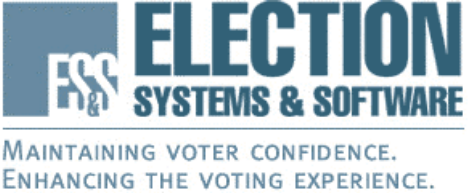
ES&S Model 100 Precinct Ballot Counter
Operator’s Manual
Version 5.2
For use with
Unity 3.0
Election Systems and Software, Inc.
Corporate Headquarters
11208 John Galt Blvd.
Omaha, NE 68137, USA
Phone: (402) 593-0101
Toll Free Inside the U.S.: (800) 247-8683
Fax: (402) 593-8107
http://www.essvote.com
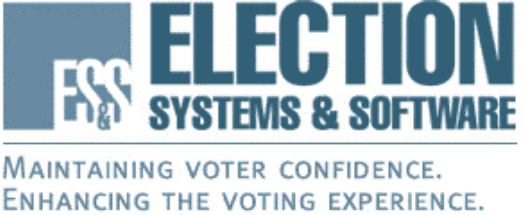
ES&S Model 100 Precinct Ballot Counter
Operator’s Manual
Version Release 5.2
August 13, 2005
Election Systems and Software, Inc.
Corporate Headquarters
11208 John Galt Blvd.
Omaha, Nebraska 68137
United States of America
Phone: (402) 593-0101
Toll Free Inside of U.S.: (800) 247-8683
Fax: (402) 593-8107
http://www.essvote.com
Copyright 2005 All Rights Reserved

Revision History
Software
Release #
Documentation
Release #
Release
Date
Page # Notes
5.2 3.0_1 8/13/2005 53 Added note under Status Report.
5.2 3.0_1 8/13/2005 55 Re-aligned status report.
5.2 3.0_1 8/13/2005 55-64 Cleaned up tabs and made reports a smaller
font.
5.2 3.0_1 8/13/2005 94 In item #3 under Ballot Diagnostics Menu
heading changed Digital Table Menu to
Digital Reports Menu.
5.2 3.0_1 8/13/2005 100 In paragraph under The Election Test
Menu last sentence changed Read Ballot
Menu to Test Option.
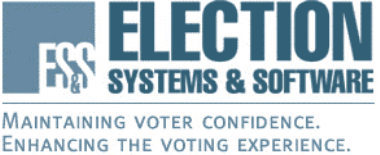
Our Mission
Our Mission is to support democracy worldwide by providing proven, accurate,
and innovative election systems and services to voters and election officials.
Our Vision
Our Vision is to continuously improve and grow our integrated total election
solutions that provide "Better Elections Every Day.” We will accomplish this
vision with an uncompromising commitment to customer satisfaction and integrity
within the election process.
Who We Are
ES&S is a company of dedicated people building integrated systems and
developing solutions for the election official’s total management needs:
• Election and voter registration management software
• Ballot counting and tabulation hardware
• Election information management software

2005 by Election Systems & Software, 11208 John Galt Blvd., Omaha, NE 68137-2364.
All rights reserved. Printed in the USA
Revisions for version 5.2: ES&S, Omaha, NE
This manual, as well as the software described in it, is furnished under license and may be used
or copied only in accordance with the terms of such license. The content of this manual is
furnished for informational use only, is subject to change without notice, and should not be
construed as a commitment by Election Systems & Software, Inc. Election Systems &
Software, Inc., assumes no responsibility or liability for any errors or inaccuracies that may
appear in this documentation. Except as permitted by such license, no part of this publication
may be reproduced, stored in a retrieval system, or transmitted, in any form or by any means,
electronic, mechanical, recording, or otherwise, without the prior written permission of Election
Systems & Software, Inc.
The Model 100 is a trademark of Election Systems & Software. Windows and Windows 95 are
trademarks of the Microsoft Corporation. All other products mentioned are the sole property
of their respective manufacturers.
Election Systems & Software does not extend any warranties by this document. All
product information and material disclosure contained in this document is furnished
subject to the terms and conditions of a purchase or lease agreement. The only
warranties made by Election Systems & Software are contained in such agreements.
Users should ensure that the use of this equipment complies with all legal or other
obligations of their governmental jurisdictions.
FCC Compliance:
This device complies with Part 15 of the FCC Rules. Operation is subject to the following two
conditions: (1) This device may not cause harmful interference, and (2) this device must accept any
interference received, including interference that may cause undesired operation.
This equipment has been tested and found to comply with the limits for a Class B digital device,
pursuant to part 15 of the FCC rules. These limits are designed to provide reasonable protection against
harmful interference in a residential installation. This equipment generates, uses and can radiate radio
frequency energy and, if not installed and used in accordance with the instructions, may cause harmful
interference to radio communications. However, there is no guarantee that interference will not occur in a
particular installation. If this equipment does cause harmful interference to radio or television reception,
which can be determined by turning the equipment off and on, the user is encouraged to try to correct the
interference by one or more of the following measures:
• Reorient or relocate the receiving antenna.
• Increase the separation between the equipment and receiver.
• Connect the equipment into an outlet on a circuit different from that to which the receiver
is connected.
• Consult the dealer or an experienced radio/TV technician for help.
The Model 100 Operator’s Manual version 5.2 contains all of the information necessary
to use any firmware version of the Model 100 5.2.X.X. Any changes to the tabulator’s
firmware version number beyond one decimal place represents changes to that do not
affect usability or system operation.
Model 100 is a registered trademark of Election Systems & Software Inc.
Disclaimer
L:\Product Management\New Doc Folder\Model 100\Manuals\M100 5-2x\ES-M100 OP 5.2 doc
Table of Contents
Chapter 1: Introduction.................................................................................................................1
Contacting ES&S for Technical Support.....................................................................................2
Chapter 2: Understanding Warning Symbols ..............................................................................3
Important Safety Instructions ......................................................................................................3
Chapter 3: Understanding the Counter........................................................................................7
The Scanner...............................................................................................................................7
The Ballot Box.....................................................................................................................8
The PC Card.......................................................................................................................9
Scanner Controls .................................................................................................................9
The Menu Display................................................................................................................9
Understanding the Three Operating Modes...............................................................................10
Diagnostic Testing Mode....................................................................................................10
Polls Open Mode...............................................................................................................10
Polls Closed Mode ............................................................................................................11
Understanding the Election Definition........................................................................................11
Chapter 4: Performing Pre-Election Day Tasks........................................................................13
Recommended Supplies...........................................................................................................13
Recommended Modem Types..................................................................................................14
Assembling the Ballot Box........................................................................................................14
Assembling the Nested Ballot Box......................................................................................15
Attaching the Model 100 to the Ballot Box.........................................................................18
Preparing the Counter ..............................................................................................................21
Charging the Battery...........................................................................................................21
Loading the Election Definition............................................................................................21
The Diagnostic-Test Menu .................................................................................................22
Changing Date and Time Settings........................................................................................23
Testing the Multi-Sheet Sensor...........................................................................................24
Connecting an External Printer............................................................................................24
Connecting an External Modem..........................................................................................25
Connecting the Internal Modem..........................................................................................25
Testing the Election Definition...................................................................................................25
Enabling Multiple Precincts for Testing................................................................................27
Configuring a Wireless Modem.................................................................................................28
The Pre-Voting Checklist.........................................................................................................29
Chapter 5: Performing Election Day Tasks...............................................................................31
Opening the Polls .....................................................................................................................31
Scanning Ballots.......................................................................................................................32
Closing the Polls.......................................................................................................................33
Reopening the Polls..................................................................................................................34
Handling Uncounted Ballots......................................................................................................35
Printing Election Reports ..........................................................................................................36
Transferring Results..................................................................................................................36
Chapter 6: Performing Post-Election Day Tasks ......................................................................39
Disassembling and Packing the Ballot Box................................................................................39
Appendix A: Maintaining the Counter.......................................................................................43
Cleaning the Scanner................................................................................................................43
Cleaning the Ballot Box............................................................................................................44
Maintaining the Internal Printer..................................................................................................45
Replacing the Paper Roll ....................................................................................................45
Feeding the Paper..............................................................................................................46
Maintaining the Scanner Battery................................................................................................46
Battery Cautions ................................................................................................................46
Charging the Battery...........................................................................................................47
Removing and Replacing the Battery...................................................................................47
Appendix B: Understanding Reports .........................................................................................53
Results Reports........................................................................................................................53
Report Format...................................................................................................................53
Report Types.....................................................................................................................53
System Reports........................................................................................................................54
Diagnostic Reports...................................................................................................................54
Appendix C: Understanding System Messages........................................................................67
System Error Recovery............................................................................................................67
Understanding Text Messages..................................................................................................67
Verification Messages ..............................................................................................................83
Understanding Numeric Messages............................................................................................84
Appendix D: Understanding System Menus .............................................................................91
Diagnostic Test Mode..............................................................................................................91
The DIAGS Menu .............................................................................................................93
The System Settings Menu .................................................................................................99
The Election Test Menu....................................................................................................100
Using the Ballot Auto-read Option....................................................................................101
Polls Open Mode...................................................................................................................102
Polls Closed Mode ................................................................................................................104
Model 100 Menu Flow Charts...............................................................................................106
Start-up Menu .................................................................................................................106
Diagnostic Menu..............................................................................................................108
System Settings................................................................................................................109
Calibration Menu .............................................................................................................110
Election Test Menu ..........................................................................................................111
Opening and Closing Polls Menu......................................................................................112
Appendix E: Troubleshooting ...................................................................................................114
Using the Temporary Ballot Storage Bin ...........................................................................114
Recovering or Replacing the Scanner................................................................................115
Appendix F – Loading New Firmware Onto The M100..........................................................117

1
Chapter 1: Introduction
The Model 100 precinct ballot scanner is part of a jurisdiction-wide election
tabulating system. Each scanner can process ballots for up to 10 precincts.
Voters make selections and then insert their ballots directly into the Model 100 at
the polling place. The scanner tabulates votes and sorts a ballot as soon as a voter
inserts it and then feeds the ballot into the attached ballot storage bin.
Election laws and procedures vary from state to state. Use the procedures in this
manual combined with the election policies and guidelines for your jurisdictions to
develop a comprehensive election strategy.
The Model 100 Operator’s Manual contains the following sections:
• Understanding Warning Symbols: This section defines all of the warning
symbols used in this manual used to indicate possible hazards when using the
Model 100 scanner.
• Understanding the Counter: This section contains descriptions of ballot
scanner functions, including diagrams and descriptions of the individual parts of
the Model 100 and the control panel.
• Performing Pre-Election Day Tasks: This section contains a list of all
necessary election supplies as well as instructions for assembling the ballot box
and counter, preparing the counter for operation and testing the loading election
definition.
• Performing Election Day Tasks: This section contains instructions for
opening the polls, closing the polls and printing reports.
• Performing Post-Election Day Tasks: This section describes post-election
tasks including shutting down and disassembling the counter.
• Appendix A: Maintaining the Counter: This section contains procedures for
routine and preventative maintenance for the Model 100.
• Appendix B: Understanding the Reports: Appendix B contains descriptions
and samples of each report generated by the Model 100.
• Appendix C: Understanding System Messages: Appendix C contains
descriptions of all system messages and instructions for correcting errors.
• Appendix D: Understanding System Menus: Appendix D contains
descriptions of Model 100 system menus.
• Appendix E: Troubleshooting: Appendix E contains troubleshooting tips for
poll workers.

2
Contacting ES&S for Technical Support
The Model 100 Operator’s Manual contains comprehensive instructions for using
the tabulator and descriptions of all scanner functions. If you require additional
assistance or encounter a processing problem or system error, contact the ES&S
technical support staff for advice or assistance.
Stay close to your scanner when you contact ES&S for support. Also, be prepared
to provide the following information to the ES&S support representative:
• The model number of your tabulator.
• The version number of the firmware installed on the tabulator.
• The exact wording of any messages displayed by the scanner.
• A description of what happened to cause the problem.
Support representatives normally answer calls between 8:00 a.m. and 5:00 p.m.
CST but ES&S extends support hours during election periods.
To contact an ES&S support representative:
Telephone: 877-377-8683 (USA & Canada) or
402-593-0101 (International)
Fax: 402-593-8107
Write: Election Systems & Software
11208 John Galt Blvd.
Omaha, NE 68137 USA
ES&S support services are subject to the prices, terms, and conditions in place at
the time the service is used.
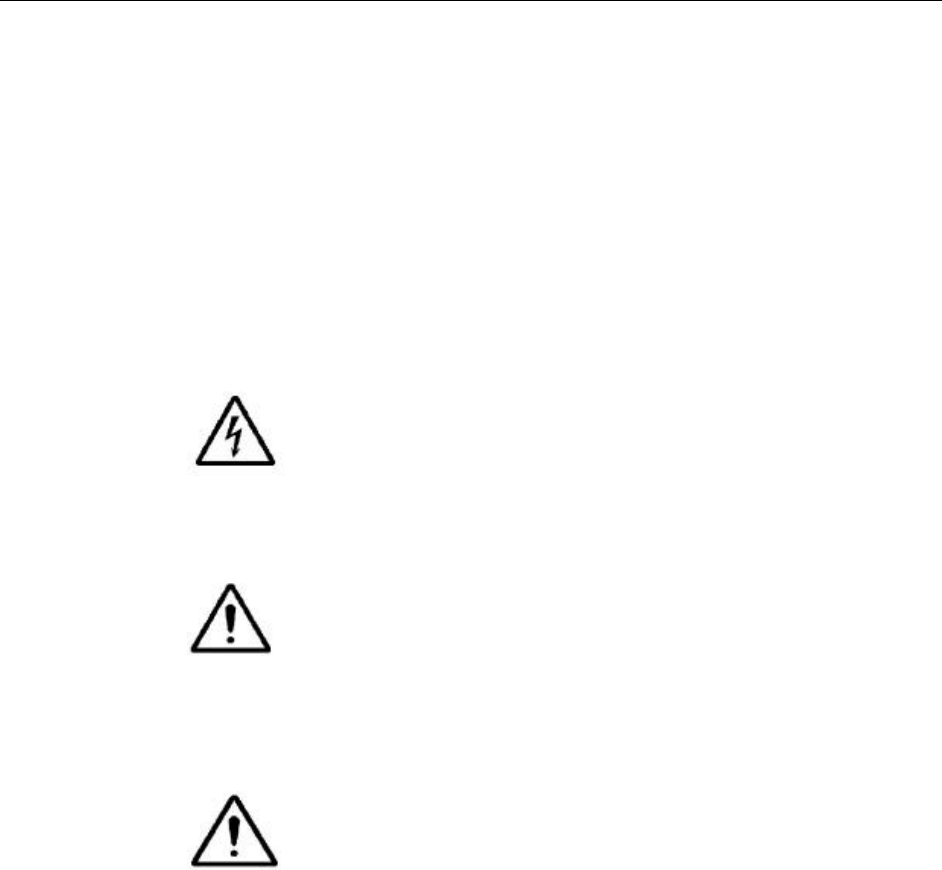
3
Chapter 2: Understanding Warning
Symbols
The following symbols appear in the Model 100 Operator’s Manual next to the
descriptions for any procedure that, if improperly executed, could cause harm to the
operator or damage to the scanner. Read all of the warnings in this manual and use
extra caution when you carry out any task that may pose a physical danger to
yourself or the Model 100 tabulator.
Electrical Shock Danger: This symbol appears next to procedures
that expose the operator to a risk of electric shock. Any operation
that requires opening the Model 100 enclosure exposes users to
dangerous high voltages. To reduce the risk of fire or shock, do not
attempt to open the Model 100 enclosure unless you receive proper
training from an ES&S technician.
User Caution: The user caution symbol appears next to procedures
that could cause damage to the scanner or injury to the operator if
improperly executed. Carefully read all warnings and proceed with
caution if you choose to carry out these tasks.
Important Safety Instructions
Important: Read and follow the safety recommendations in this
section of the Model 100 Operator’s Manual to maintain proper
safety measures when operating the scanner.
Read the Operator’s Manual
Carefully read the operator’s manual before you attempt to operate the scanner.
Carefully follow all instructions and read all warnings contained in the Model 100
Operator’s Manual.
Power Sources
Only use the type of power source indicated on the ID label of your Model 100 to
power the tabulator. Make sure that you install the tabulator in compliance with all
applicable sections of the National Electric Code. Consult your local building code
before you install any ballot-scanning equipment.

4
Ventilation
The case of the Model 100 scanner contains slots and openings that provide the
ventilation for the unit. To prevent the Model 100 from overheating, do not block or
cover any of the scanner’s openings during operation. Do not operate the Model
100 in an enclosed housing unless ES&S approves the container. Use only the
integrated ballot box supplied by ES&S as a ballot container for the Model 100.
Water and Moisture
Caution: Do not place containers with liquids such as coffee, water
or soda on or near a Model 100 terminal. Do not operate the scanner
in an excessively wet environment. Store the Model 100 in a cool dry
place.
Cleaning
Follow instructions in the “Cleaning the Scanner” section of Appendix A to properly
maintain the Model 100. Use only the cleaning solutions approved and specified by
ES&S to clean the tabulator.
Heating
Do not install the Model 100 near heat sources such as radiators, air ducts, areas
subject to direct sunlight or other products that produce excessive heat.
Power Cord Protection
After you plug the scanner into an approved outlet, route or install the power cord
for the Model 100 in such a manner to protect it from being walked over or
pinched. Turn the scanner key to the off position before connecting or disconnecting
the power cord. Remove the power cord before you move the unit. Only plug the
power cord in to an easily accessible unobstructed wall socket.
Servicing
Do not attempt to service the scanner unless specifically instructed to do so by
ES&S. Do not attempt to open the scanner case or perform internal maintenance
unless you receive proper training from ES&S.

5
Damage Requiring Service
Some situations require an ES&S technician to resolve. Unplug the Model 100 and
call ES&S to schedule service with a technician for the following conditions. Do not
attempt to repair the scanner without first contacting ES&S.
• When the power cord is damaged
• If liquid is spilled into the scanner casing
• If the product is physically damaged in any way
• When the scanner displays a negative change in performance
Additionally, you should seek assistance from ES&S if the scanner does not
function according to the descriptions in the operator’s manual. Unless you receive
specialized training from ES&S, do not attempt to adjust advanced settings that are
not described in the Model 100 Operator’s Manual. Improper adjustment of
advanced controls may result in damage to the scanner and often require service by
an ES&S technician to restore the scanner.
Battery Replacement Warning
Caution: Improperly replacing the terminal battery exposes the
operator to a risk of explosion. Only qualified ES&S technicians should
replace Model 100 scanner batteries.

6
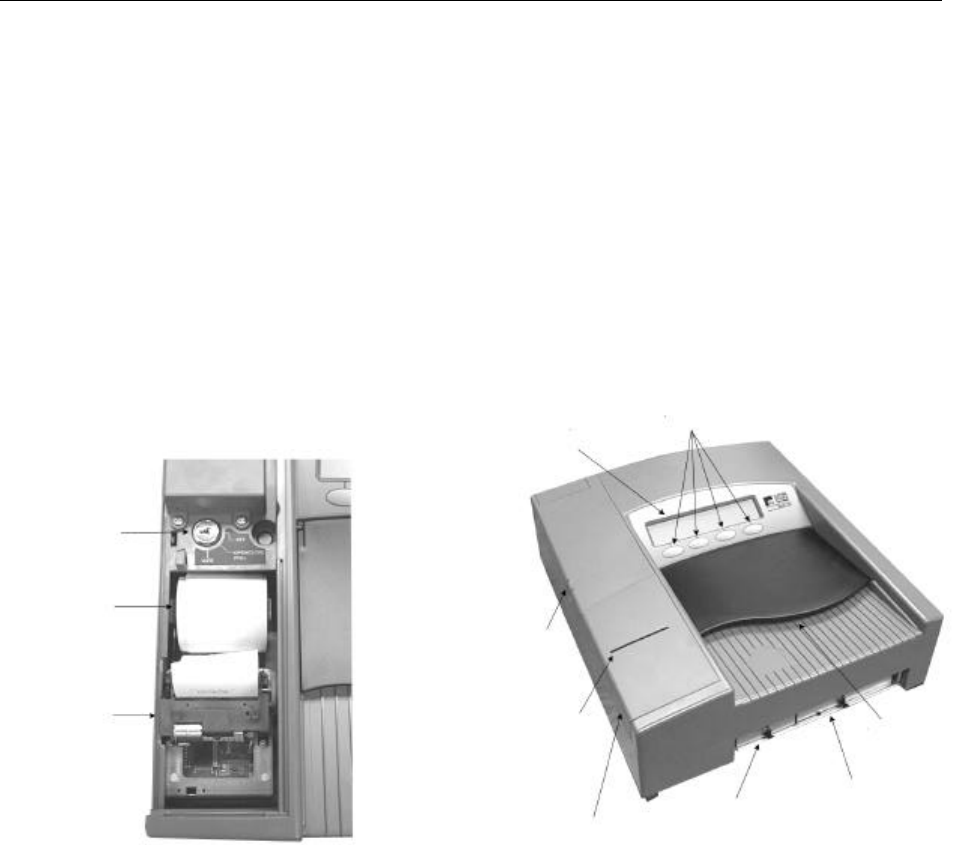
7
Chapter 3: Understanding the Counter
Use the diagrams and descriptions in this chapter to familiarize yourself with Model
100 scanner components and functions. Always scan a ballot test deck before your
election to test the scanner for accuracy and to correct any functional errors before
you count official ballots.
For a list of recommended polling place supplies and instructions for assembling and
testing the Model 100, see Chapter 4, “Performing Pre-Election Day Tasks.”
The Scanner
The Model 100 scanner reads marks on both one and two-sided ballots.
Administrators can request custom ballot acceptance criteria, which ES&S
programs onto the scanner’s election definition PC Card. For example, if a
jurisdiction prohibits counting blank ballots, ES&S election coders can program the
Model 100 sort blank ballots out of the general ballot count until jurisdiction officials
can review the ballots. With each acceptable ballot counted, the Model 100
increases the running vote totals for each race included on the election definition.
A standard 120-volt AC power cord supplies electricity to the scanner. If a power
outage occurs, the Model 100 contains an internal back-up battery that can run the
scanner for one to three hours, depending on scanner activity. The tabulator stores
accumulated totals to internal scanner memory (DRAM) and to a removable PC
Card.
Key
Printer
Paper
Thermal
Printer
Display Screen
(LCD)
Menu Control
Buttons
Ballot
Entry Slot
Parallel/Serial
Port Access Panel
PC Card Slot
Access Panel
Printer
Access Panel
Printer
Paper Slot
Key Access
Panel
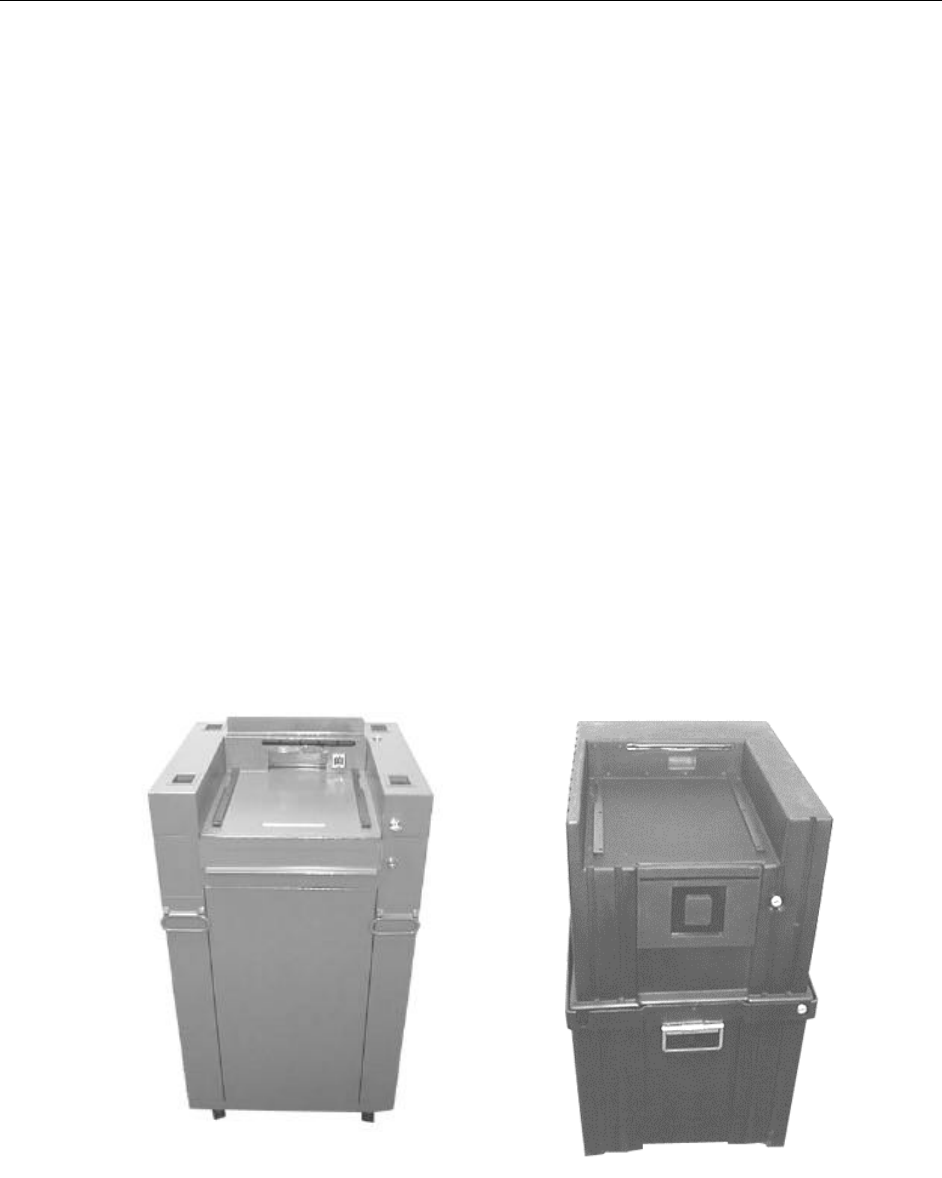
8
The Model 100 can generate reports and store election results in the following
formats:
• Paper reports produced from the scanner’s internal, thermal printer or by an
external printer connected to the scanner.
• A removable PC Card that you can use to transfer scanner results to Election
Reporting Manager after the polls close.
• Data transferred by modem directly from the scanner to a PC running Election
Reporting Manager.
The Ballot Box
Model 100 ballot boxes store ballots and house the scanner at the polling place.
ES&S supplies one of two styles of ballot box (metal or nested) with each Model
100 scanner. The Model 100 feeds scanned ballots directly into the ballot box,
which sorts the ballots according to criteria programmed in the election definition
with an internal diverter. The ballot box also has a compartment that poll workers
can use to temporarily store uncounted or contested ballots in the event of a power
failure or scanner error.
Metal Ballot Box Nested Ballot Box
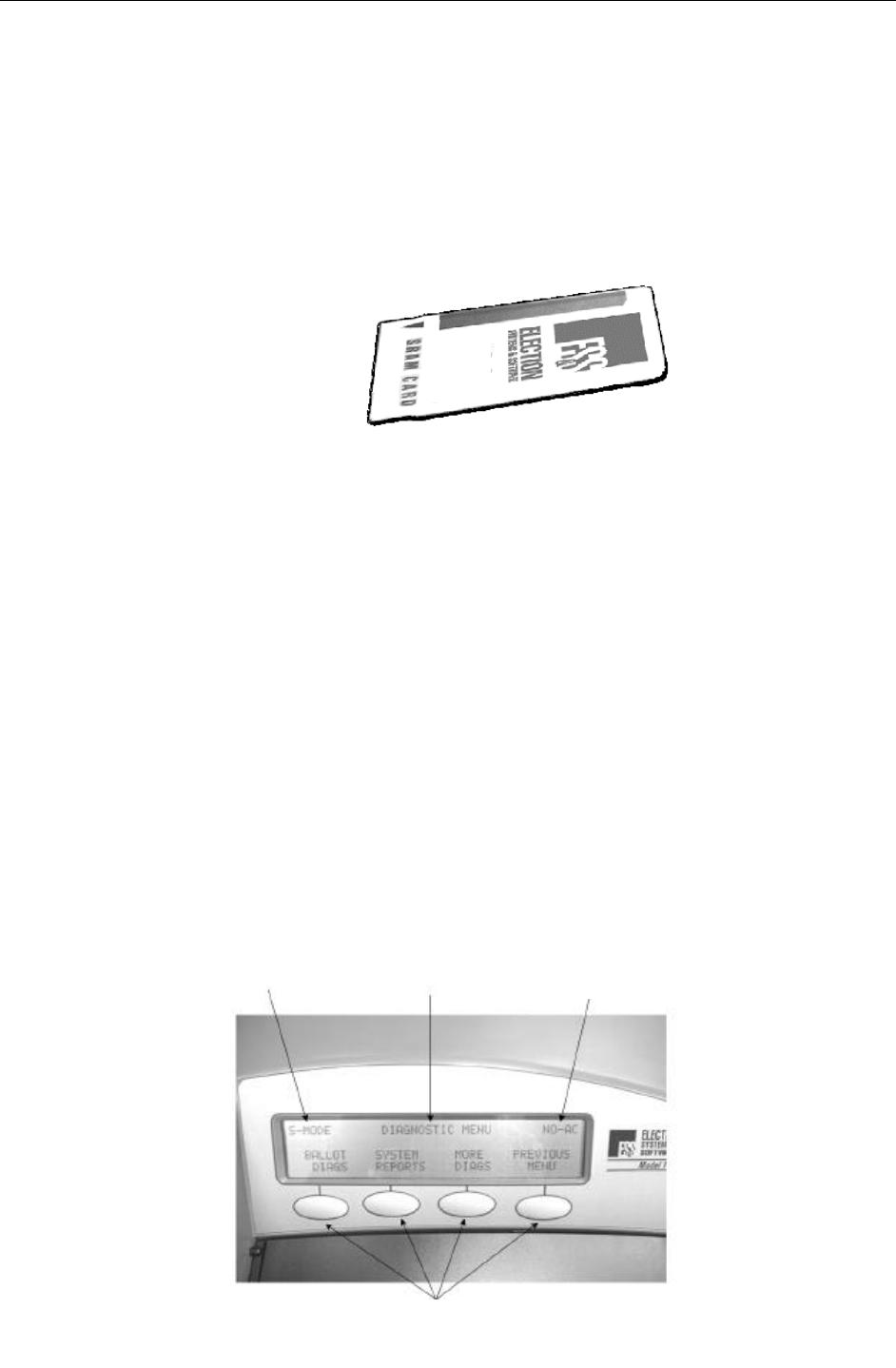
9
The PC Card
The Model 100 uses PC Cards to store the scanner’s election definition, audit log
and other election-specific information. Data on the PC Card exists in one
sequential block, which is updated each time the Model 100 scans a ballot. Use PC
Cards with a memory capacity of 256KB (kilobytes) or 512KB.
Scanner Controls
The four external buttons below the Model 100 LCD message screen control all
scanner functions. Push the button below a menu option on the display screen to
navigate Model 100 system menus.
The Menu Display
The Model 100 display screen contains four message areas. The top-center line of
text on the screen identifies the current menu. The message in the top left corner
identifies the status of the scanner. For example, “S-MODE” indicates that the
operator has turned the scanner control key to the OPEN/CLOSE POLL position
and the Model 100 is in supervisor mode. The message on the top right of the
screen displays the scanner’s battery status. The message “NO-AC” indicates that
the scanner is using battery power. The lower line of text identifies available menu
options. Press the button below a command to select a menu option.
Menu Option
Control Buttons
Supervisory
Mode Indicator
Current Title
Menu Type of Power
Source

10
Operators access most menu options through a series of sequential steps, while
other options are only available while the scanner key is in the OPEN/CLOSE
POLL position. The far right control button usually functions as a “Previous Menu”
key that navigates backwards through Model 100 menus. For a detailed list of
menu commands and functions, see Appendix D, “Understanding System Menus.”
Understanding the Three Operating Modes
The Model 100 operates in three separate modes. Operators open the scanner in
diagnostic mode to calibrate and test the scanner. In polls open mode, the Model
100 actively scans ballots and tabulates results, and, in polls closed mode, the
scanner prints poll reports and transfers election results.
Diagnostic Testing Mode
Open the scanner in diagnostic testing mode to load system firmware, calibrate the
scanner and test your election definition.
Election officials should load system programs and test Model 100 election
definitions before delivering scanners to polling places. Complete the following tasks
to prepare a scanner for an election:
1. Load the election definition into the scanner. For more information, see
“Loading the Election Definition” in Chapter 4.
2. Test the election definition and the scanner to ensure accuracy. For more
information on testing the scanner, see Chapter 4, “Preparing the Counter.”
3. If necessary, lock out system functions after testing the scanner. For more
information about locking down the system, see Chapter 4, “Preparing the
Counter.”
Note: Locking out system functions keeps protects the Model 100 from
tampering but still allows access to election testing functions.
Polls Open Mode
Open the polls to begin regular Election Day functions such as scanning ballots and
tabulating vote totals.

11
Poll workers should monitor the scanner during an election, but the Model 100
requires minimal operator involvement during voting. The operator’s main
responsibility during voting is responding to system messages.
Polls Closed Mode
Close the polls at the assigned time to print reports or transfer scanner totals to
election headquarters. Available Model 100 reports include Status Reports, Poll
Reports, Precinct Reports, Certification Reports and the Audit Log report. After
the polls close, operators can also transfer results to a central site using the
scanner’s modem.
Understanding the Election Definition
Election coders program a custom election definition onto a PC Card for each
Model 100 used in your jurisdiction. An election definition contains all of the
candidates, contests and ballot variations that the scanner will process at the polling
place. The election definition also contains customizable program options that
control how the tabulator operates and reports results. Customizable options
include (but are not limited to):
• Automatic results transfer by modem
• Ability to re-open the polls
• Grouping of undervotes and overvotes on reports
• Automatic certification report printing when polls are closed
• Automatic results report printing when polls are closed
• Rejection, acceptance or query the voter when a scanner detects an overvoted,
cross-voted or blank ballot

12

13
Chapter 4: Performing Pre-Election
Day Tasks
Use the equipment list and the procedures included in this chapter to prepare your
Model 100 scanner for a live election. Always perform routine maintenance on your
voting equipment and test your ballot scanners before you open the polls on
Election Day.
For instructions for opening and closing the polls, operating the scanner during an
election and printing or transferring results, see Chapter 5, “Election Day Tasks.”
Recommended Supplies
ES&S recommends maintaining a supply of the following items for each Model 100
used in your jurisdiction. All of the listed items are available for order from ES&S.
Contact ES&S customer service at (800) 247-8683 with any questions or orders.
Allow four weeks for delivery.
• Paper Spools: The printer uses NRC 2.25” by 165’ thermal paper rolls. The
NCR part number is 856704. Recommended Quantity: 1full roll per
scanner
• PC Cards: Battery backed PC cards that store the scanner’s election definition
and ballot count. The standard memory capacity for Model 100 PC Cards is
256k but larger sizes are available. Recommended Quantity: 1 per scanner
• Marking Devices: ES&S recommends and supplies the Bic Round Stic
(Black) medium point pen for voters to mark ballots. The Bic pen is the only
marking device approved by ES&S for the use with the Model 100.
• Pressurized air cans: Use pressurized air to clean the scanner.
Recommended Quantity: 2 cans per scanner
• Cleaning pad and isopropyl rubbing alcohol: Use isopropyl alcohol to clean
the scanner rollers. If you order the cleanser from ES&S, the part identifier is
ES-Cleaner. To clean the scanner rollers, pour the cleanser into a spray bottle
and dampen the cleaning pad. Never spray cleanser directly on the scanner.
Recommended Quantity: 1 bottle per scanner

14
Recommended Modem Types
Equip your Model 100 scanners with modems if your jurisdiction transfers precinct
results to election headquarters over a network connection. ES&S tested and
approved the following modems for use with Model 100 precinct scanners:
• PCMCIA Modem: MEGAHERTZ, XJ4336-CC4336, V.34+
Data/Fax/Cell/VOX
• PCMCIA Modem: 3COM, 3CXM/3CCM556, MEGAHERTZ Cell
Telephony Modem, Data/Fax/Cell 56 Kbps
• PCMCIA Modem: USROBOTICS, XJ/CC5560, MEGAHERTZ Modem,
Data/Fax/Cell 56 Kbps
• PCMCIA Modem: 3COM, MEGAHERTZ, 3CXM756 / 3CCM756,
Data/Fax/Cell Serial Port Modem
• External Modem: Hayes compatible external modem
• Cellular Digital Packet Data (CDPD): Internal Novatel Model NRM 682
(n
• External PCS Phones: Samsung PCS3500, Motorola PCS7876, QualComm
PCS 2760, Sony SPC 4000
Note: If your jurisdiction transfers results via for TCP/IP wireless transmission,
use one of the PCS phones in the previous list.
Note: CDPD wireless modem functionality is not supported for the Unity 2.5
voting system.
Assembling the Ballot Box
ES&S delivers each Model 100 scanner with either a nested ballot box (made of
hard plastic) or a metal box. The metal ballot box does not require assembly. If
your jurisdiction uses metal boxes, skip to the “Mounting the Scanner” section of
this chapter. Use the instructions in the following sections to prepare ballot boxes at
your polling places if your jurisdiction uses nested ballot boxes.
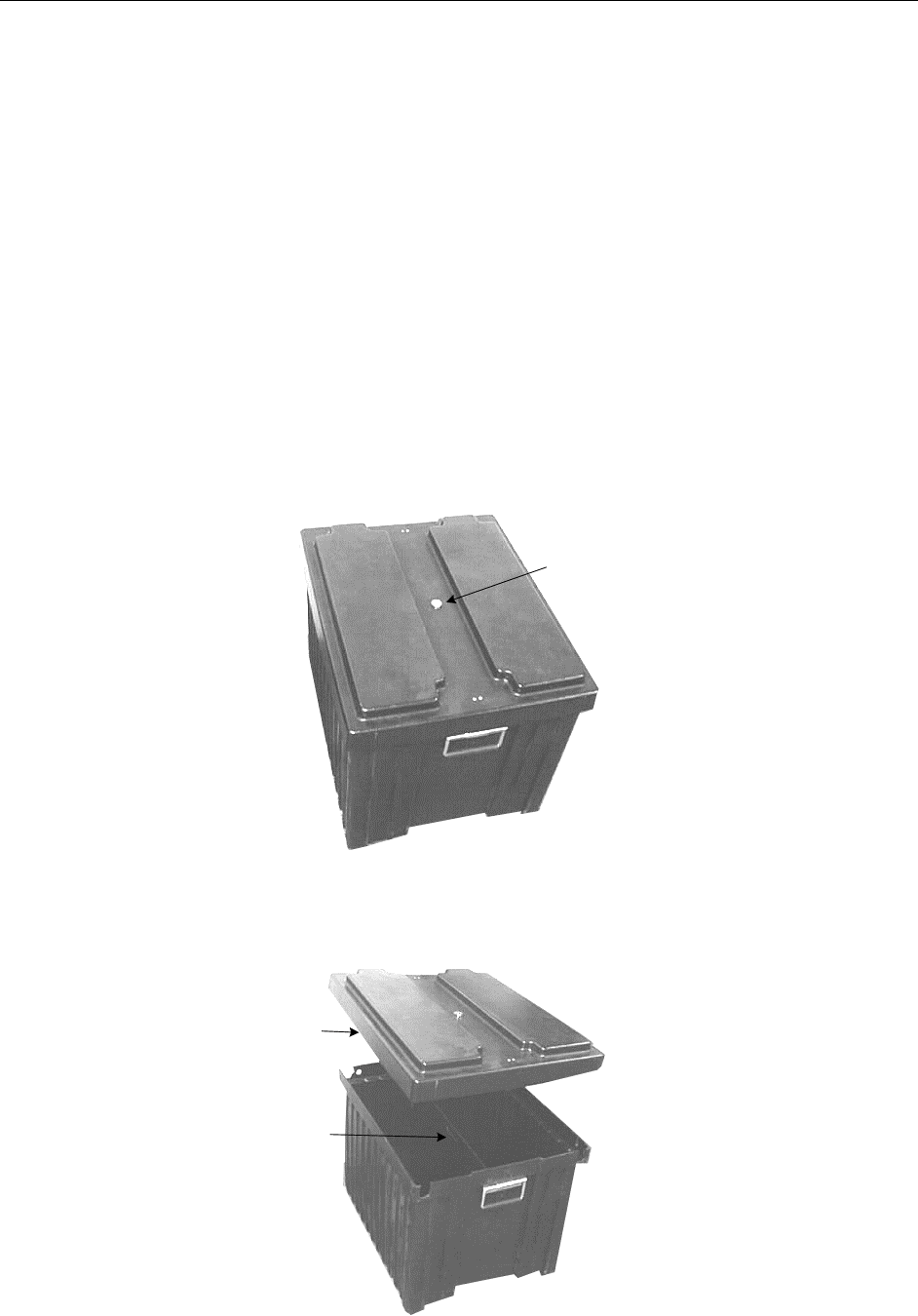
15
Assembling the Nested Ballot Box
ES&S delivers the nested ballot box and scanner in two containers. A carrying case
that holds the scanner and power cord and a cube that assembles into the ballot
box. Keys for the scanner and ballot box accompany the equipment. Completely
assemble the ballot box before you mount the scanner.
Note: Although the ballot box can be assembled by only one person, ES&S
recommends a second poll worker assist with separating the top half of the box
from the bottom half and with attaching the two halves during assembly.
To assemble the nested box
1. Unlock the cover of the ballot box with the key provided (one key fits the lock
for all nested boxes).
2. Lift the box cover straight up and off the box and then set the cover aside.
Lock
Cover
Divider
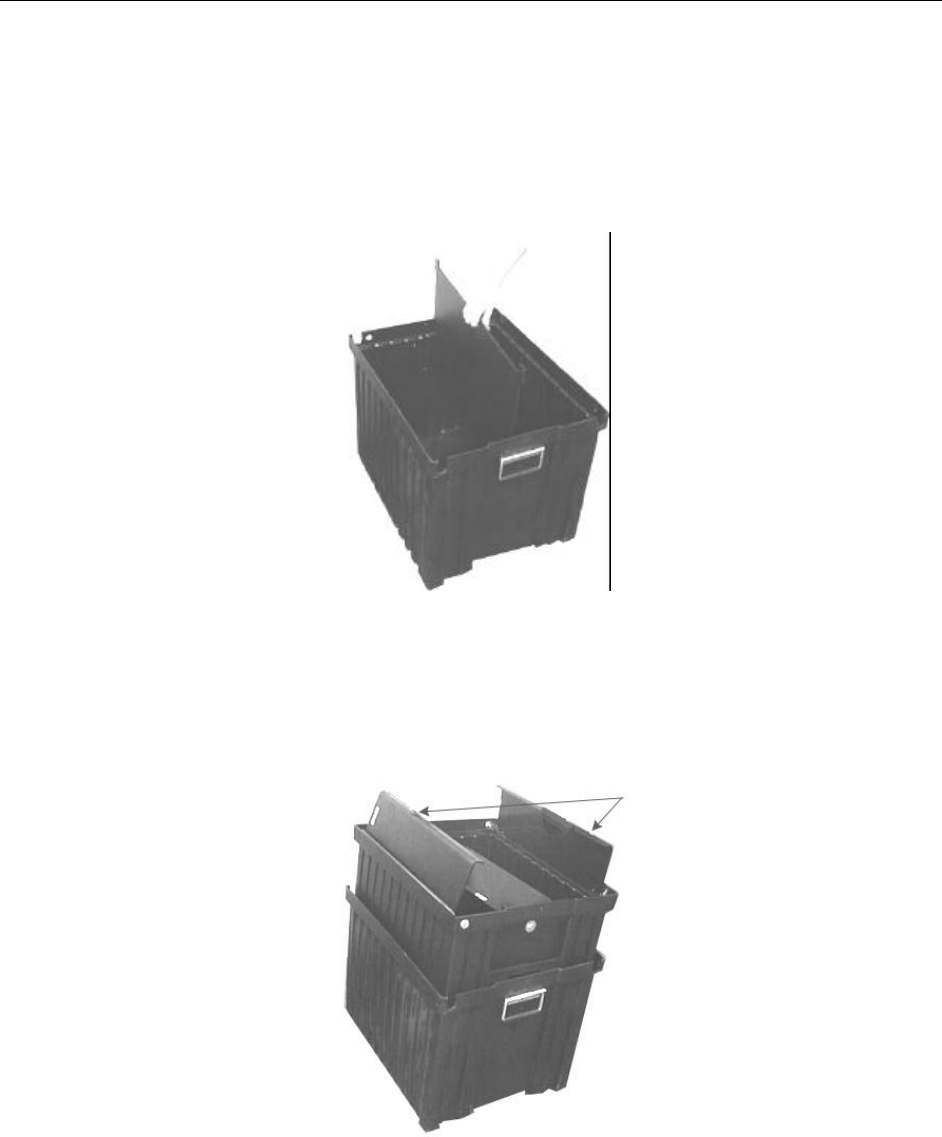
16
3. Remove the divider, which looks like a flat piece of plastic with a cutout handle,
from inside the box and set the divider aside.
4. Swing the two handles up from inside the ballot box. Pull up on the handles until
the top section of the box separates from the bottom section and then set the
top section to the side.
Top Section
Handles
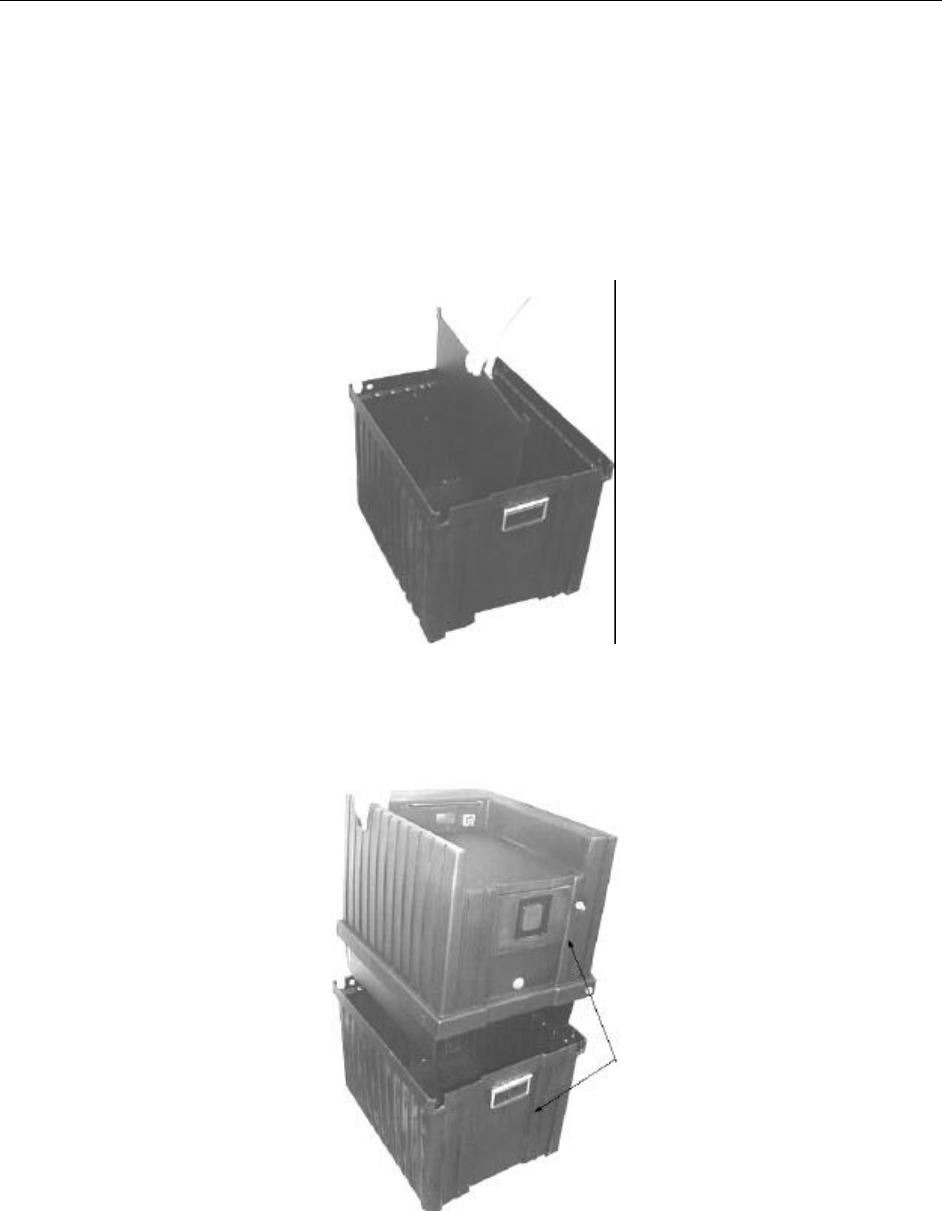
17
5. Align the edges of the divider with the vertical grooves inside the bottom section
of the box. Insert the divider until it locks into the tab at the bottom of the box.
6. Flip the top section of the box upside down so that the swinging handles hang
down. Position the top section of the box over the bottom section. Make sure
that the indentations on the front of both boxes face the same direction.
Rim
Indentations
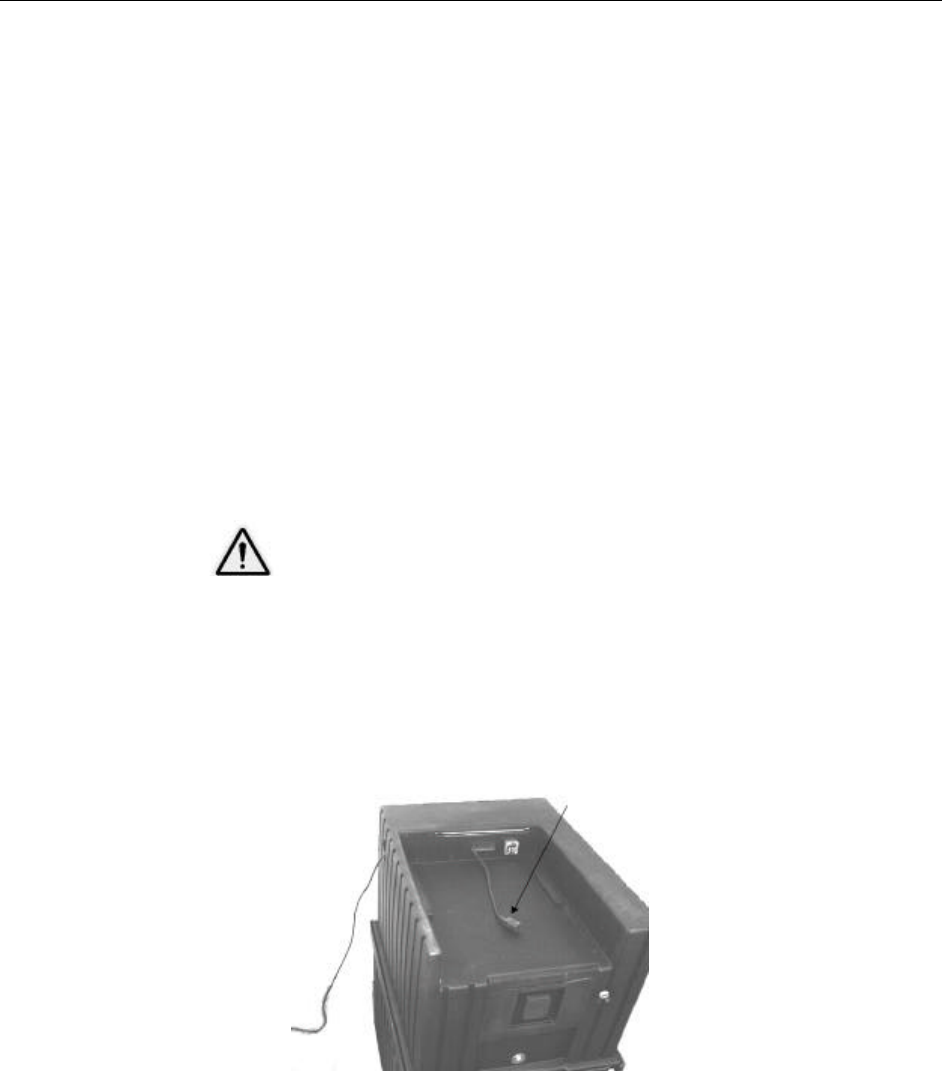
18
7. Lower the top section of the box until it fits inside the bottom. The handles on
the top section should fit snugly inside of the bottom section. Use your ballot
box key to lock the two locks on the front and the back of the box.
8. Slide the latch on the top section of the ballot box through the hole in the side of
the bottom section.
Attaching the Model 100 to the Ballot Box
The metal box and nested box are equipped with different types of scanner access
doors. Other than the access door, the process for mounting the scanner to either
ballot box is the same.
To set up the power cord
1. Before you mount your scanner to the top of a ballot box, inspect the power
cord for damage.
Important: If the cord appears damaged, discard it and contact
ES&S for a new cord.
2. Insert the female end of the cord through the opening on the outer left side of
the ballot box.
3. Thread the cord through the outside opening on the back of the box until the
cord appears on the inside of the opening at the top recessed area.
4. Pull the cord through the opening until it extends a few inches into the recessed
area of the ballot box. Then, remove the scanner from the carrying case.
Cord
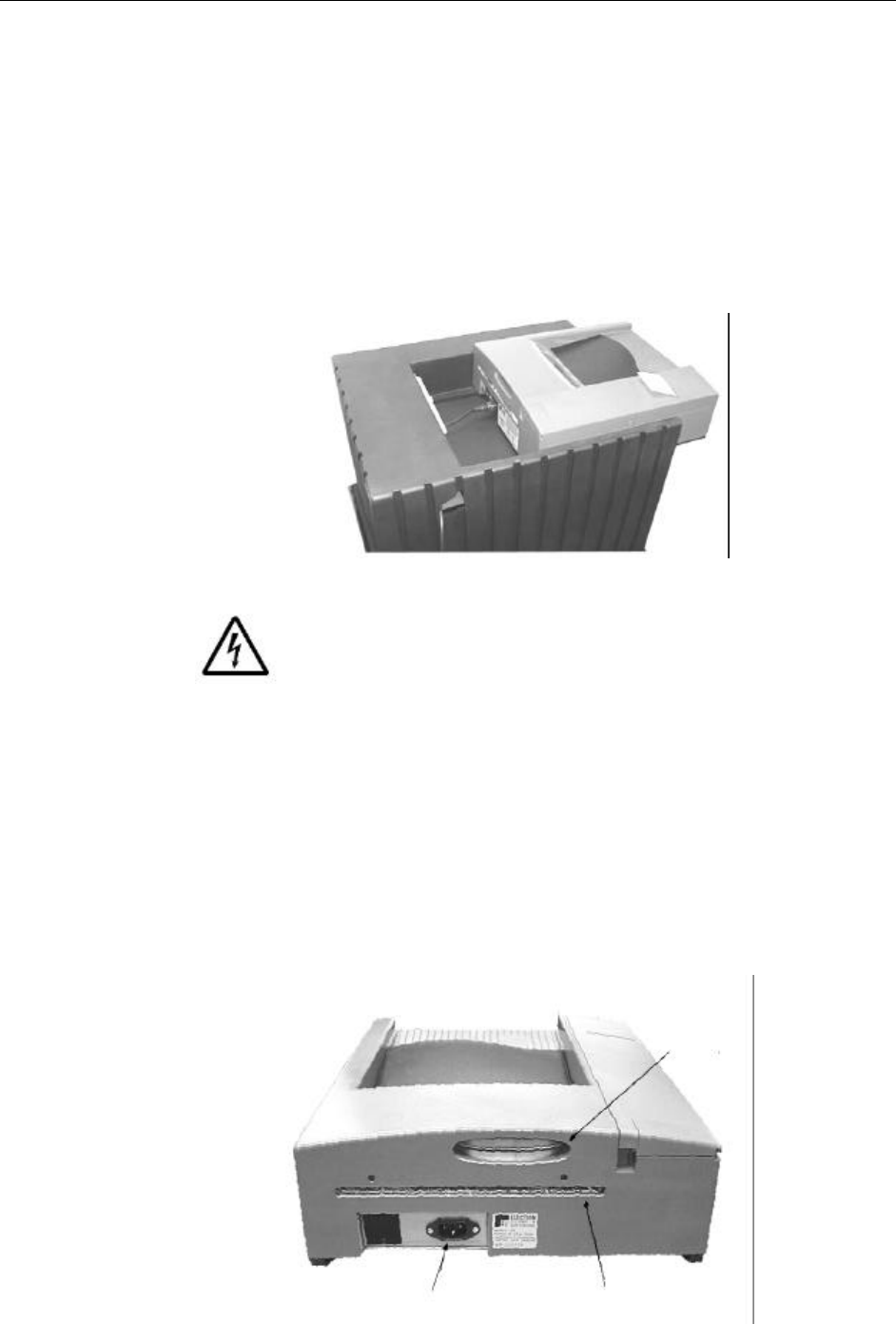
19
5. Place the scanner about one-third of the way into the recessed area and slide it
onto the mounting rails until it sits about four or five inches from the back of the
recessed area.
Warning: Only plug the Model 100 scanner into a grounded, three-
pronged electrical outlet. Plug only one scanner into each available
outlet. ES&S recommends does not recommend using an extension
cord.
6. Plug the female end of the power cord into the Power Entry Module on the
back of the scanner and then plug the male end of the cord into a wall outlet.
Arrange your voting equipment to make sure that no one trips on the cord or
accidentally unplugs the scanner on Election Day.
Note: The message, “NO-AC,” appears on the scanner’s display screen if the
scanner is not receiving power through the power cord. Check your
connections and the wall outlet if this message appears on your scanner’s
display screen.
Mounting
Rails
Rear
Handle
Paper Path
Power Entry
Module
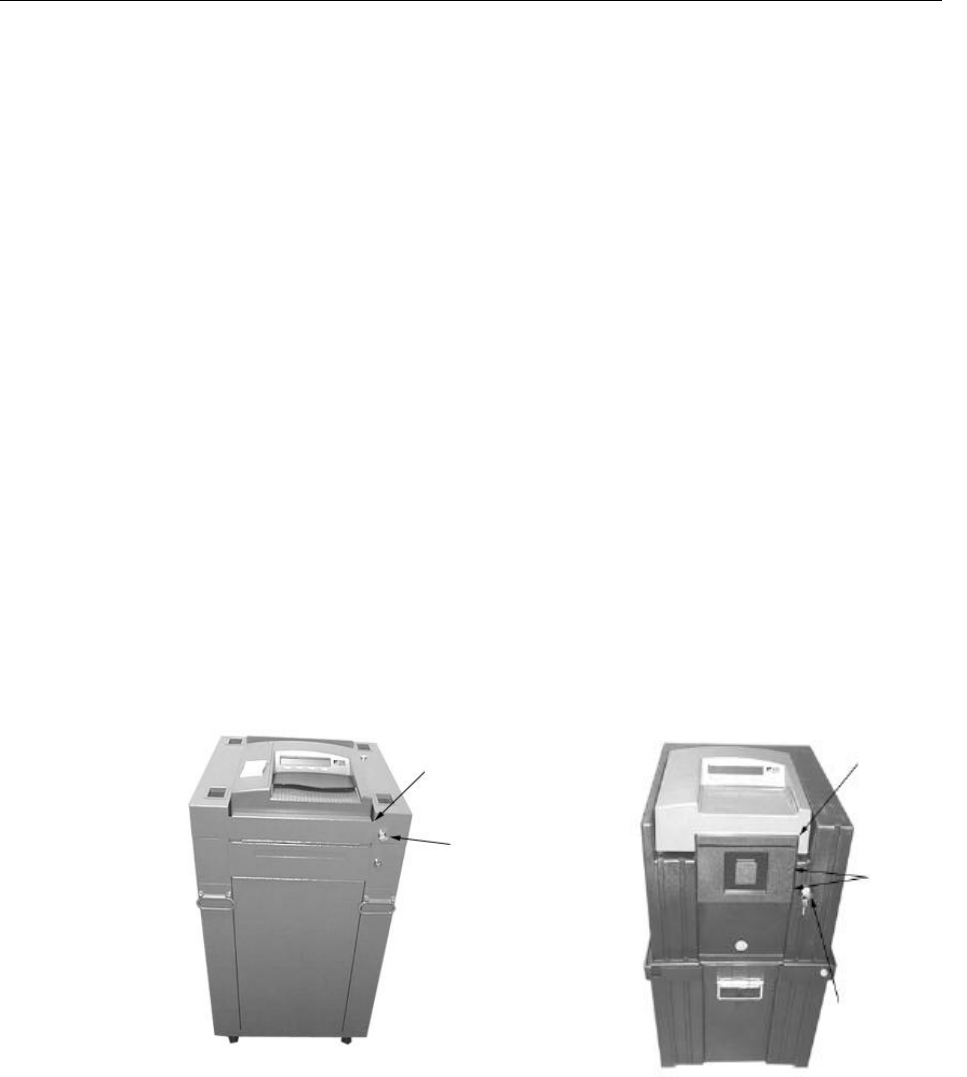
20
To attach the scanner to the ballot box
1. Slide the scanner against the back of the ballot box. Make sure the diverter
connector at the back of the scanner locks into the slot on the ballot box.
2. Insert the scanner key into the control panel turn it to OPEN/CLOSE POLL
position to start the Model 100 and generate an Initial State Report.
3. Slide the door on the front of the ballot box up until it covers the front of the
scanner.
Note: The front access door on the nested ballot box slides up and down,
while the door on the metal box is a hinged panel. Both doors lock to limit
access to the scanner’s PC Card.
Metal Ballot Box Nested Ballot Box
4. If you use a nested ballot box, align the bottom arrow on the door with the
center of the lock and lock the door into place.
OR
If you use a metal ballot box, align the hole in the access door with the bracket
on the box and lock the hinged panel into place. Test the door to make sure the
lock properly engages.
Swing Hinged
Door Downward
Hinged
Door Lock
and Key
Pull Door
Upward
Arrows
Door Lock
and Key

21
Preparing the Counter
After you mount the scanner to the ballot box, there are a number of tasks that you
must complete before you open the polls. Because the proper operation of the
counter depends on performing the following tasks, it is important to carefully
review this section before every election.
Charging the Battery
The Model 100 uses a backup battery to ensure that scanner operations continue
without interruption during a power failure. Plug the scanner in and turn the power
on for twelve hours to fully charge the battery. If you charge multiple Model 100
precinct counters, do not connect more than 40 scanners per 15-amp circuit.
To check the battery charge
1. Turn the scanner key to the OPEN/CLOSE POLL position to power up the
scanner and open the DIAGNOSTIC-TEST menu. Select DIAGS to open
the DIAGS menu and select MORE DIAGS.
2. From the MORE DIAGS menu, select BATTERY STATUS to check your
scanner’s battery charge. For more information on the battery, see Appendix A,
“Maintaining the Counter.
Loading the Election Definition
Model 100 precinct tabulators use election definitions programmed on PC Cards to
recognize ballot marks and tabulate results. Make sure the scanner key is in the
OFF position when you load an Election Definition.
To load an election definition
1. Lift the access door on the front left of the scanner to access the Model 100 PC
Card slots. Insert the card programmed with your election definition into either
card slot.
2. Turn the key to the OPEN/CLOSE POLL position to start the scanner. The
Model 100 automatically loads the election definition and prints an initial state
report. The “S-MODE” prompt should appear in the upper left corner of the
Model 100 display screen.
Note: An arrow on the PC Card label shows which end of the card you should
insert into the scanner. After the card is inserted, the eject button to the right of
the card slot sticks out. Install the card in either the top or the bottom slot. If

22
one slot does not accept the card, try the other. Do not force the card into a
slot.
Checking the Election Definition for Accuracy
The Model 100 automatically generates an Initial State report when you start the
scanner. Check the report for the following information:
• System Values: Make sure the date and the time appear correctly on the
report. If the information is not correct, change date and time from the
DIAGNOSTIC-TEST menu. For more information about changing the date
and time settings for the scanner, see “Changing the Date and Time” in this
chapter.
• Election Information: Make sure that the jurisdiction name, polling place, and
the number of precincts listed on the report are correct.
The Diagnostic-Test Menu
After you insert an election definition and start the scanner, the message,
“ELECTION CARD INSERTED, OPEN POLLS NOW?” appears on the display
screen. Press the first and third buttons on the control panel to access the scanner’s
diagnostic test options.
Access the following the following menus from the DIAGNOSTIC-TEST menu:
Press both buttons at
once to select the
Diagnostic -Test menu

23
• DIAGS: Select DIAGS to open the DIAGNOSTIC menu. Select MORE
DIAGS to access the BATTERY STATUS option and check the charge for
the backup batter. Only ES&S technicians should select the MOTOR
CONTROL, BALLOT DIAGS and SYSTEM REPORTS commands.
• SYSTEM SETTINGS: Access the SYSTEM SETTINGS and select
THRHLDS to perform system tests such as the multi-sheet test (see
“Checking the Multi-sheet Sensor” in this chapter). Select DATE TIME to
change the scanners date and time settings (see “Changing the Date and Time”
in this chapter). Only ES&S technicians should select CALIBRATE DACS.
• ELECTION TEST: Select the ELECTION TEST menu to test your scanner
and election definition. For more information about testing your scanner, see
“Testing the Election Definition” in this chapter
Note: The Model 100 does not allow you to open the scanner for voting unless
you install a PC Card programmed with an election definition. If you start the
Model 100, without installing a PC card first, only the diagnostics menu will be
accessible. For a description of the menu options available without an election
definition, see “Appendix D: Understanding System Menus.”
Changing Date and Time Settings
Daylight savings or a power failure can throw off Model 100 date and time settings.
Use the DATE/TIME option from the SYSTEM SETTINGS menu to reset the
scanner’s date and time settings.
To change the date and time
1. Access the SYSTEM SETTINGS menu from the DIAGNOSTIC-TEST
menu and select DATE TIME.
2. Select SET DATE or SET TIME, depending on which setting you want to
change.
3. In either mode, press SELECT to scroll through number positions and then
select PLUS or MINUS to increase or decrease the values.
Note: The SET ZONE option is the time zone setting based on Greenwich
Mean Time. The DAYLIGHT SAVINGS option sets the date that the internal
clock automatically changes for daylight savings. ES&S sets the TIME ZONE
and DAYLIGHT SAVINGS options before shipping the scanner, and you
should not adjust them.
4. After you correct the scanner’s date and time settings, select PREVIOUS
MENU twice to return to the DIAGNOSTIC-TEST menu. The message,
“LOCK OUT SYSTEM SETTINGS?” appears.

24
5. Select YES to remove the SYSTEM SETTINGS option from the
DIAGNOSTIC-TEST menu. If you lock out the scanner’s system settings, the
option will not be available unless you install new election definition PC Card
into the scanner. Select NO to retain access to the scanner’s system settings.
Testing the Multi-Sheet Sensor
The Model 100’s multi-sheet sensor prevents multiple ballots from passing through
the scanner’s read area at the same time. Test the multi-sheet sensor before Election
Day to make sure that your scanner does not accept multiple ballots.
To test the multi-sheet sensor
1. From the SYSTEM SETTINGS menu, select THRHLDS to access the
THRESHOLDS menu.
2. Select MULTI SHEET to open the MULTI SHEET DETECTION menu.
3. Place one test ballot on top of another and push the stacked ballots halfway into
the ballot entry slot. The message, “DETECT TRUE,” appears if the scanner
recognizes the presence of more than one ballot in the read area. The message,
“FALSE,” appears if the scanner fails to detect multiple ballots.
4. If the multi-sheet sensor functions properly, press PREVIOUS to return to the
THRESHOLDS menu. From the THRESHOLDS menu, press PREVIOUS
MENU to return to the SYSTEM SETTINGS menu.
Note: If your scanner fails to detect multiple ballots, try the test again. Make
sure that you feed the ballots at least halfway into the read area. If the sensor
fails repeatedly, contact ES&S customer service for assistance.
Connecting an External Printer
You can connect an external printer to the Model 100 in order to print scanner
reports on 8.5 x 11-inch paper. The scanner automatically sets the external printer
as the default report destination once you attach a printer to your Model 100.
To connect an external printer, plug the printer cable into the parallel printer port
located behind the right, front door of the scanner.

25
Connecting an External Modem
If your Model 100 is not equipped with an internal modem, connect an external
modem to the scanner to transfer results directly from your polling place to election
headquarters.
To connect an external modem
1. Connect the serial cable for your modem to the external communications port
under the Model 100’s right, front panel.
2. Connect the other end of the modem cable to the RS-232 port on the modem.
3. Connect the telephone line at your polling place to the RJ-11 telephone jack on
the modem.
4. Plug the modem into an electrical outlet.
Connecting the Internal Modem
If your Model 100 scanner is equipped with an internal modem, use the telephone
cord that came with your scanner to connect the Model 100 to a telephone jack.
To connect the internal modem
1. Connect one end of the telephone line to the RJ-11 telephone jack behind the
front, right access door on the scanner.
2. Connect the other end of the telephone line to a telephone jack at the polling
place.
Testing the Election Definition
Test the election definition for each of your scanners before you deliver Model 100s
to your polling places. To test a Model 100 election definition, scan the ballot test
deck supplied by ES&S with your election definition PC Card and compare the
results to the test reports supplied by ES&S.

26
Test the scanner only after you install the election definition and configure the Model
100. If your jurisdiction programs its own election definitions, create a test deck that
includes at least one ballot for each precinct enabled for your scanner and maintain
accurate records of your test ballot selections. After you scan the test ballots,
generate a results report and compare the scanner report to your ballot records. If
the results do not match, make sure that the marks on your test ballots are dark and
clean and then scan the test ballots again.
Note: The following ballot test is not accurate if you modify the TARGET
COUNT setting from the AUTOREAD SETTINGS menu.
To scan a ballot test deck
1. Start the scanner and access the DIAGNOSTIC-TEST menu, select
ELECTION TEST to open the ELECTION TEST menu.
2. From the ELECTION TEST menu, select TEST BALLOT to open the
BALLOT TEST menu.
3. From the BALLOT TEST menu, select FEED BALLOTS to open the
ELECTION TEST INSERT BALLOT menu.
4. Insert test ballots into your scanner one at a time. The public counter on the
Model 100 message display screen should increase by one for each ballot the
scanner processes. The Model 100 can scan ballots inserted in any orientation.
Note: If you programmed the Model 100 to tabulate ballots for multiple
precincts, you must enable the additional precincts before scanning your ballots.
For more information about scanning ballots for multiple precincts, see
“Enabling Multiple Precincts for Testing” in this chapter.
To print ballot test reports
1. After you finish scanning test ballots, select PREVIOUS to open the BALLOT
TEST menu. From the BALLOT TEST menu, select PREVIOUS MENU to
return to the ELECTION TEST menu.
2. From the ELECTION TEST menu, select REPORTS to open the
ELECTION REPORTS menu.
3. From the ELECTION REPORTS menu, select REPORTS to open the
PRINT REPORTS menu.
4. From the PRINT REPORTS menu, access the following reports to view test
results for your scanner:

27
• Select STATUS REPORT to generate a report that includes the number
of ballots processed by your scanner. Verify that the number of ballots
counted matches the number of ballots in your test deck.
• Select PRECINCT REPORT or POLL REPORT to generate test
results reports. Compare the scanner reports to your test ballot records to
make sure that the totals match.
5. Verify your results and then select PREVIOUS MENU three times to exit the
ELECTION TEST menu. The third time you select PREVIOUS MENU the
message “Clear Election Test Results and Leave Election Test Menu?” appears.
Select YES to clear test results and return to the DIAGNOSTIC TEST menu.
If your scanner results and test records do not match, review your test ballots
for errors and repeat the test. If the results are not correct after running the test
a second time, contact ES&S for customer support.
To repeat a diagnostic test from the PRINT REPORTS menu
1. Beginning in the PRINT REPORTS menu, press PREVIOUS MENU twice
to open the ELECTION TEST menu.
2. Select ZERO TOTALS to clear the scanner totals from your previous test.
The message “Counters are set to zero” appears when the scanner memory is
clear. Press OK to continue.
3. Select TEST BALLOT and repeat the testing process described in the
“Testing the Election Definition” section of this chapter.
Note: If your scanner totals do not match test ballot records after a second
test, contact an ES&S technical support representative for assistance.
Enabling Multiple Precincts for Testing
The Model 100 can process ballots for up to 10 precincts. This feature is useful for
the following reasons:
• System redundancy and backup
• Absentee ballot counting, (ES&S can program a “dummy” precinct that allows
you to view absentee ballot totals separately from Election Day totals)
• Processing ballots for multiple precincts on a single scanner
Note: When you create a ballot test deck for a scanner programmed to read
ballots for multiple precincts, create and scan at least one ballot for each
precinct the scanner will process on Election Day.
To enable multiple precincts for a ballot test

28
1. Use the instructions in the “Testing the Election Definition” section of this
chapter to access the ballot test menu. Feed one test ballot into the scanner and
then press the far left button on the scanner’s control panel under the
ELECTION TEST INSTERT BALLOT menu to open the ENABLE
PRECINCTS menu.
2. Select NXT-PREC to cycle through the available precincts.
3. Select ENABLE for each precinct that you want to open on your scanner.
Selected precincts remain enabled for the duration of your ballot test. The
scanner defaults to original precinct settings after you complete the test.
4. Select PREVIOUS to return to the ELECTION TEST INSERT BALLOT
menu.
5. Resume your ballot test and print your test reports. For more information on
testing your scanner, see “Testing the Election Definition” in this chapter.
Note: After you open the polls, enable precincts by turning the key to the
OPEN/CLOSE polls position and pressing the button furthest to the left on the
control panel. Once you enable a precinct, you cannot disable it.
Configuring a Wireless Modem
If your jurisdiction uses optional, Model 100 wireless modems to transfer results to
election headquarters, configure the modem from the DIAGNOSTIC-TEST menu
before you open the scanner for voting.
To configure the Model 100 wireless modem
1. Turn the key on the Model 100 to the OPEN/CLOSE POLL position. The
message, “ELECTION CARD INSERTED OPEN POLLS NOW?” appears.
2. Press the first and second buttons from the left simultaneously to open the
MODEM menu. The options available in the MODEM menu are MODEM
SETTINGS and CDPD STATUS.

29
3. Select MODEM SETTINGS to change the telephone number for election
headquarters, change IP address settings for your network transfers and to
configure other modem functions.
4. Select CDPD STATUS to test the Model 100 wireless modem.
Note: CDPD wireless modems are not supported by the Unity 2.5 voting
system
The Pre-Voting Checklist
Review the following list before you open the scanner for voting:
• Have you anticipated all potential special voting conditions, such as overvotes
and absentees, and included those conditions in the election definition?
• Have you charged the scanner’s back-up battery?
• Is there a sufficient paper supply for the printer? If you use an external printer,
have you recently changed the ribbon? Is a backup ribbon readily available?
• Have properly completed setup and test procedures?
• Do ballots contain the correct precinct identification number(s)? Does the
identification number on the PC Card match the number on your ballots?
After completing all pre-election preparations, turn the key on the Model 100 to the
OFF position. Remove the key, close the key access panel and prepare the scanner
for transportation to the polling place.

30

31
Chapter 5: Performing Election Day
Tasks
This chapter contains instructions for the following Election Day tasks:
• Opening the polls
• Scanning Ballot
• Closing the polls
• Re-Opening the polls
• Handling Uncounted Ballots
• Printing election reports
• Transferring results
Opening the Polls
Before your polling location opens for voting, retest and check the system
configuration for each of your scanners. For more information about testing and
configuring scanners, see Chapter 4, “Performing Pre-Election Day Tasks.”
After you test and configure your scanners, load the PC Cards with the scanner
election definitions and turn the Model 100 control key to the OPEN/CLOSE
POLL position on each scanner at the polling location. Then, use the instructions in
this section to prepare the scanners for voting.
To open the polls
1. After you start the scanner with the control key, the system initializes and the
message “ELECTION CARD INSERTED: OPEN POLLS NOW?” appears.
Select YES to open the polls.
2. After you open the polls, the message “PLEASE TURN KEY/SWITCH TO
VOTE” appears on the scanner display screen. Turn the key to the VOTE
position to initialize the following scanner functions:
• The scanner checks available memory and scans election definition for
errors.
• Depending on options set for your election definition, the Model 100 prints
a Status Report, a Zero Totals Report and/or a Zero Certification Report

32
on activation. Select CANCEL at any time during printing to cancel the
current report and all following reports.
3. After the Model 100 finishes printing the startup reports, make sure the scanner
key is in the VOTE position, and then remove the key and close the access
panel.
4. After you remove the key, you can open the scanner for live voting. Make sure
that the public counter on the Model 100 display screen increases by one with
each ballot cast but do not make any further adjustments to the scanner unless a
system message appears.
Note: If you need to review a scanner’s function history, you can print a system
audit report at any time while the polls are open. To print an audit report, open
the scanner’s access panel, insert the control key and turn the key to the
OPEN/CLOSE POLL position. Select AUDIT LOG REPORT from the
scanner control panel to print the report. You can cancel the report at any time
by pressing CANCEL. After you finish printing, turn the key to the VOTE
position and close the key access panel to re-open the scanner for voting.
Scanning Ballots
The Model 100 can scan ballots inserted in any direction or orientation. Depending
the options set for your election definition, the Model 100 will use one of the
following methods for accepting or rejecting blank ballots, overvotes, and crossover
votes:
• Unconditional acceptance: The scanner accepts and tabulates results for all
ballots. The scanner automatically sorts questioned ballots without storing
results from those ballots.
• Unconditional rejection: The Model 100 automatically rejects crossover,
overvoted or blank ballots. Voters must review and correct ballot selections
before the scanner will accept the ballot.
• Query the voter for correction: The Model 100 returns a questioned ballot
to the voter and displays a screen message that describes the problem and
prompts the voter to either review and edit the ballot or cast the ballot as it is.
The voter can presses RETURN to correct the ballot or presses ACCEPT to
cast the ballot without editing selections.
Poll workers should closely monitor system messages during voting. For
descriptions of system messages and recommended actions, see Appendix C,
“Understanding System Messages.” If you encounter a problem that you cannot
correct, contact election headquarters or ES&S technical support.

33
Closing the Polls
Close your polling place for voting at the assigned time and then, use the Model 100
control key to prepare scanner results for processing. You cannot print reports,
transfer results or process vote totals from the scanner’s PC Card until you properly
close the polls.
You can print election, event, and audit log reports after you close the scanner for
voting. You can also transfer results to combine your scanner totals with the final
vote tallies from other polling places at a central counting location.
To close the polls
1. Check the ballot auxiliary bin for sorted, uncounted ballots.
Note: Study your jurisdiction’s procedures for handling uncounted ballots
before Election Day. For more information about removing and processing
sorted ballots, see “Handling Uncounted Ballots” in this chapter.
2. Open the Model 100 Key Access Panel, insert your control key and turn the
key to the OPEN/CLOSE POLL position to access the CLOSE POLLS
command.
3. Press CLOSE POLLS to officially close the polls. Depending on your election
configuration, the scanner may automatically print one or more of the following
reports: Status report, Race Results report, Certification report and/or Audit
Log report. Select CANCEL to stop printing a report at any time. The POLLS
CLOSED menu appears after the scanner finishes printing.
Note: If you configured the Model 100 election definition to automatically
transmit results over a network connection to a central PC, the data transfer
begins at this time.
4. To print additional Audit Log Reports, select AUDIT – LOG REPORT from
the scanner control panel. Select CANCEL to stop printing at any time.
Caution: If you use a modem to transfer Model 100 results, generate all
necessary, printed reports before you transmit results. In order print paper
reports, the scanner uses PC Card data that the Model 100 automatically
deletes after transferring data over a network. For descriptions and examples of
each Model 100 report, see Appendix B, “Understanding Reports.”
5. From the POLLS CLOSED menu, select SEND RESULTS to manually
transmit election results over a network connection. After the Model 100
attempts to send results, the scanner displays a message that indicates whether
data transfer was successful. If the transfer fails, attempt to send results again.
Deliver the PC Card to election headquarters if the transfer fails a second time.

34
For more information about transferring Model 100 results, see the
“Transferring Results” section of this chapter.
Reopening the Polls
If you discover voted ballots mistakenly left in voting booths after the polls close or,
if you must close the scanner for voting before the assigned time, you can reopen
the Model 100 to scan uncounted ballots.
Note: Some jurisdictions do not allow reopening of the polls after the assigned
closing time. Your jurisdiction must specifically request the option to reopen the
polls from ES&S election programmers or include the option on the election
definition PC Card in order to reopen polls.
To reopen the polls
1. Turn the scanner control key to the OPEN/CLOSE POLL position to access
the POLLS CLOSED menu. Select MORE to open the MORE
SELECTIONS menu. From the MORE SELECTIONS menu, press RE-
OPEN POLLS, to open a password selection screen.
2. Contact your election administrator or ES&S customer support for the scanner
password. Press the outside-left button on the control panel to cycle through the
numeral positions. Use inside-left button to increase the selected number and
inside-right button to decrease the number.
3. Press the button labeled ENTER after you input the password. The message,
“CLEAR ELECTION DAY TOTALS,” appears if your password is correct.
Select YES to clear scanner totals or NO to add the totals from any scanned
ballots to the stored results.
Note: Do not select YES under the “CLEAR ELECTION DAY TOTALS”
heading unless you want to erase all vote totals from scanner memory. If you
accidentally press YES, you must rescan all of the ballots cast on the scanner.
4. The message, “ELECTION CARD INSERTED, OPEN POLLS NOW?”
appears after you clear or retain scanner results. Simultaneously press the first
and third buttons on the control panel to access the DIAGNOSTIC-TEST
menu from this screen. Select YES and then turn the key back to the VOTE
position to re-open the polls.
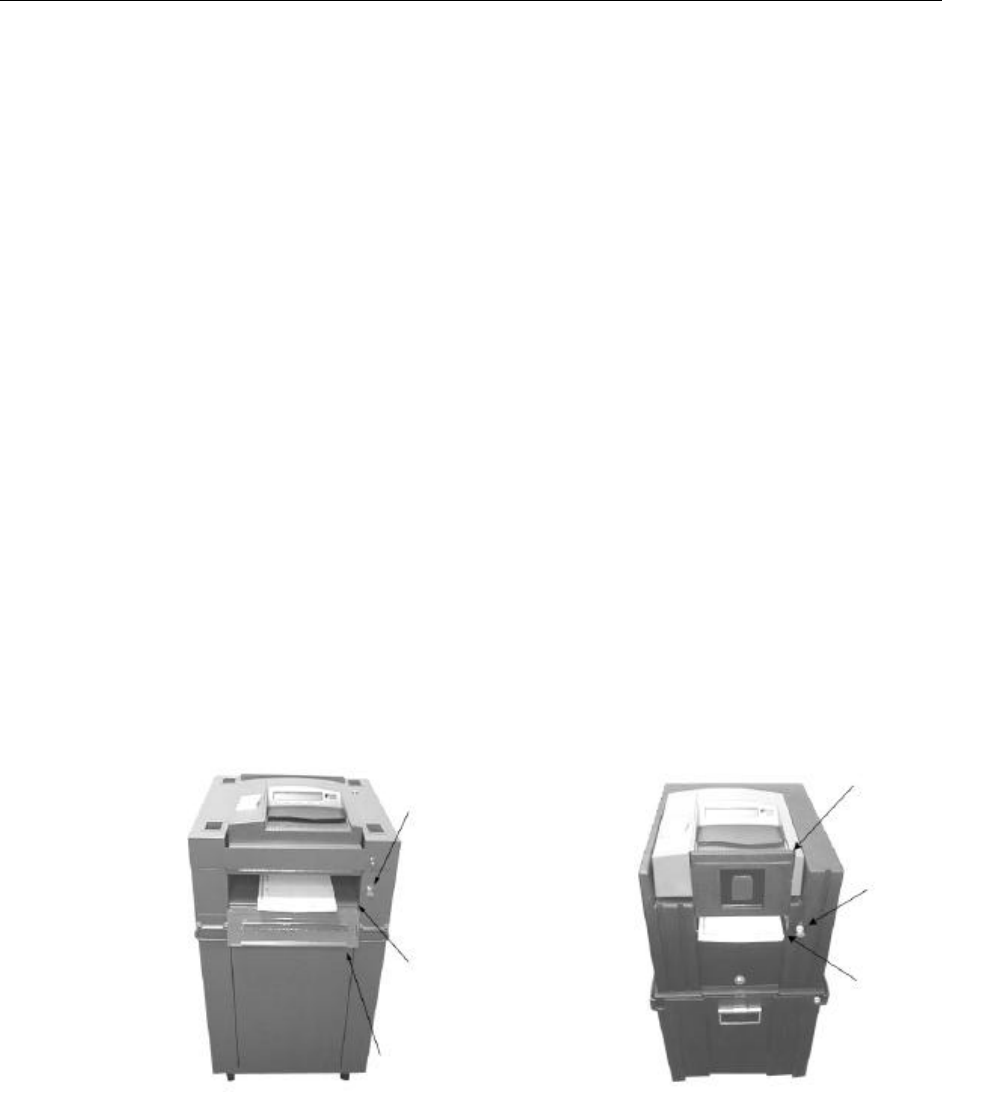
35
Lock and
Key
Uncounted
Ballot(s)
Storage Bin
Hinged Panel
Slide Door
Upwards
Lock and
Key
Uncounted
Ballot(s)
Storage Bin
Handling Uncounted Ballots
Save any ballots that were uncounted during voting due to, sorting, power failure or
scanner problems in the temporary ballot storage bin. After you close the polls,
remove and scan the uncounted ballots to add the totals to your scanner’s memory.
Study your jurisdiction’s regulations for handling uncounted ballots before you
remove and scan stored ballots.
If your jurisdiction uses metal ballot boxes, unlock the ballot access panel on the left
side of the ballot box to remove stored write-in ballots.
To access the temporary ballot storage bin
1. Unlock the sliding door on the front of the nested ballot box or the bottom door
on the front of the metal ballot box.
2. If you use the nested ballot box, slide the bin door upward and away from the
storage bin to access your uncounted ballots. If you use the metal ballot box,
swing the hinged door on the front of the box down to access the uncounted
ballot storage bin.
Metal Ballot Box Nested Ballot Box
3. Inspect the uncounted ballots and then feed them into the scanner.
Note: Double-check the back of the bin to make sure that no ballots remain
uncounted.

36
Printing Election Reports
The Model 100 generates a variety of results reports after the polls close.
Depending on the options configured for your election definition, the scanner may
automatically print reports when you close the polls or you can manually select
reports from the POLLS CLOSED menu.
To print a report
1. Close the polls to access the POLLS CLOSED menu and select RESULTS
REPORT to reprint any automatic reports generated by the polls closed. The
types of reports generated depend on your election definition settings.
2. To print additional reports, return to the POLLS CLOSED menu and select
MORE to access additional commands. Press MORE REPORTS to access
additional report formats.
Note: You can configure your election definition to require a password
to access the report menus.
3. Select CHANGE TYPE to toggle between Media and Summary report
formats. For descriptions and examples of Media and Summary reports, see
Appendix B, “Understanding Reports.”
4. From the REPORT SELECTION menu, select a report to begin printing.
Press CANCEL to stop printing at any time.
Note: For descriptions and examples of each Model 100 report, see Appendix
B, “Understanding Reports.”
Transferring Results
If your jurisdiction uses Election Reporting Manager to generate election reports,
transfer results from your precinct counters to the PC running the reporting
software.
To transfer the results with a modem:

37
1. Select SEND RESULTS from the POLLS CLOSED menu. The Model 100
automatically searches for a modem and dials the phone number programmed
into the election definition. The scanner displays a confirmation message if the
data transfer is successful.
2. If the transfer fails, try to send results a second time. If the transfer fails again,
deliver the scanner’s PC Card to election headquarters and load scanner results
directly to Election Reporting Manager.
To transfer results with the PC Card:
1. Unlock the access door on the front of the ballot box.
2. Push the eject button and remove the PC Card from the scanner.
3. Deliver the PC Card to election headquarters.
Note: Deliver all write-in ballots to your election administrator as soon as
possible after the polls close. Separate all of the write-in ballots from regular
ballots. To remove write-in ballots from the ballot box, follow the instructions in
the “Handling Uncounted Ballots” section of this chapter.

38
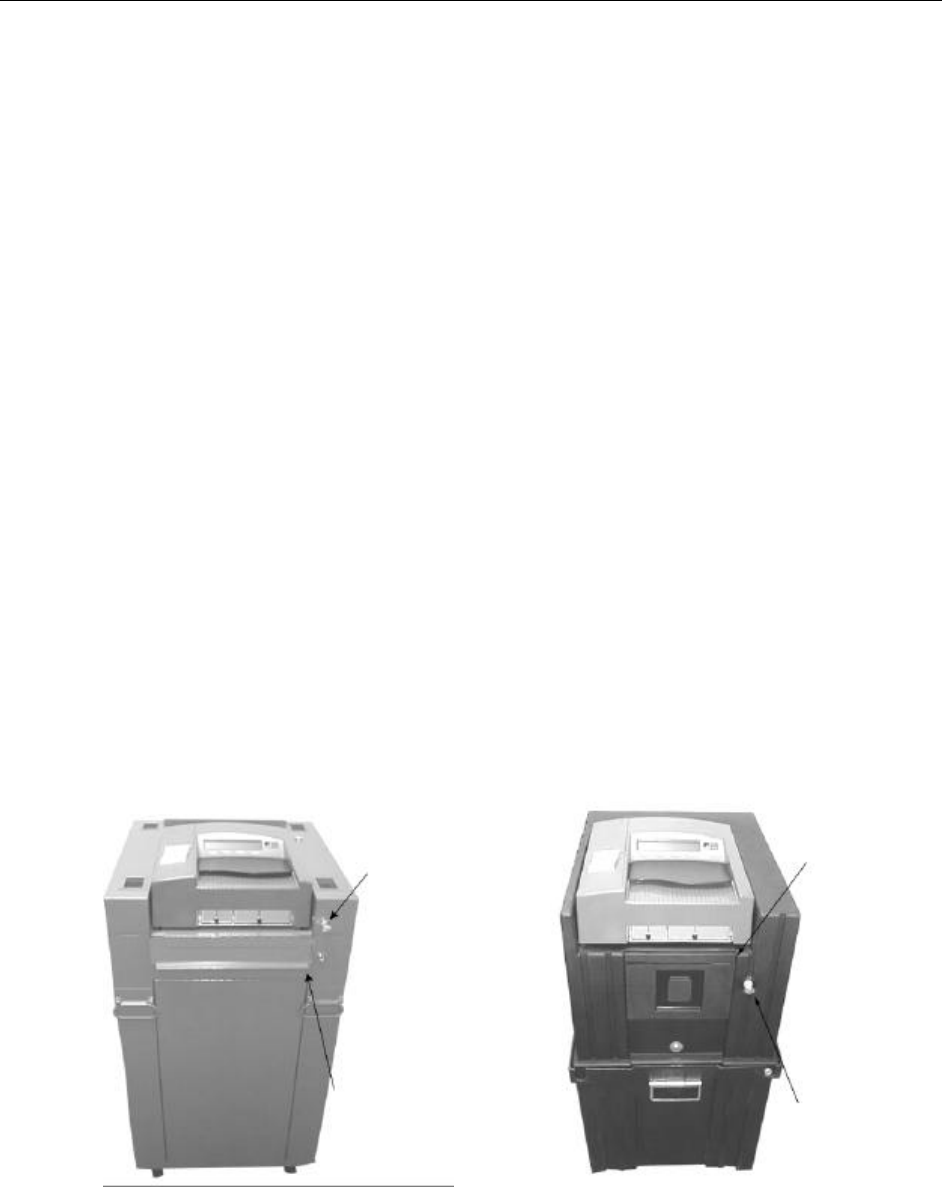
39
Chapter 6: Performing Post-Election
Day Tasks
Use the instructions in this chapter to perform routine maintenance and clean the
Model 100 after the polls close. Post-election maintenance ensures that your
scanner will be usable for many elections.
Disassembling and Packing the Ballot Box
Carefully pack the scanner and ballot box for storage. Disassemble the Nested
Ballot Box after you remove uncounted ballots from the ballot storage bin. The
Metal Ballot Box requires no disassembly.
To remove the scanner from the ballot box:
1. If you use the nested box, unlock the small sliding door on the front ballot box
and slide the door down until it no longer covers the front of the scanner.
OR
If you use the metal box, unlock the top hinged panel on the front of the ballot
box and swing it down to expose the front of the scanner.
The Metal Ballot Box The Nested Ballot Box
2. Turn the scanner control key to the OFF position, remove the key, and give it
to the Election Administrator.
Note: Close the Key Access Panel and Printer Access Panel before you
continue.
Hinged
Door
Lock
Swing Hinged
Door Downward
Slide Door
Downward
Door
Lock
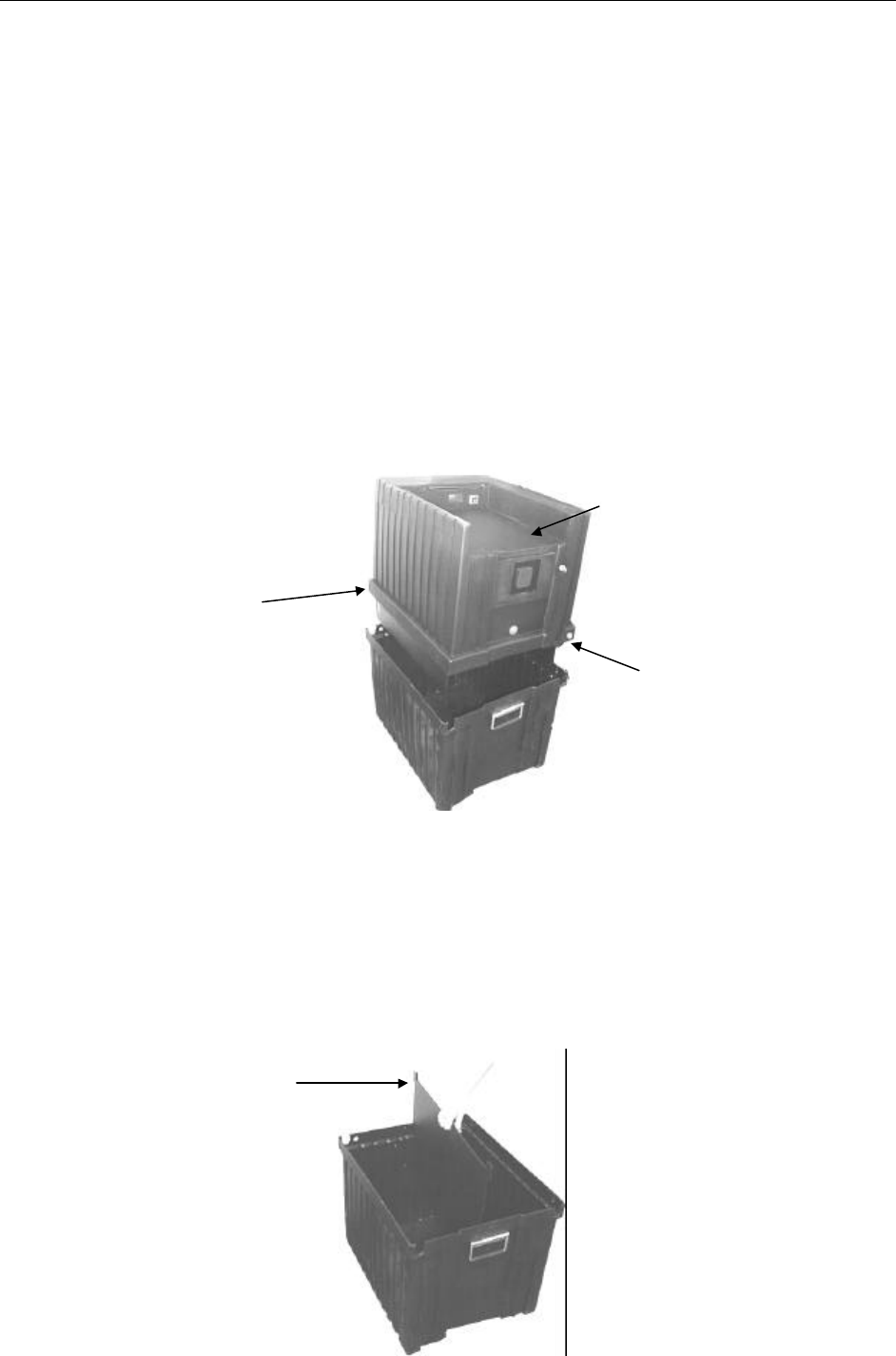
40
3. Pull the scanner forward about four to five inches and disconnect the power
cord from the back of the terminal. Thread the cord through the back of the
ballot box and unplug it from the wall outlet.
4. Slide the scanner forward until it clears the mounting rails and remove the
scanner from the ballot box.
Note: Lock and secure all of the ballot box doors before you place the metal
box in storage.
5. Place the scanner and its power cord into the scanner carrying case.
To dismantle the nested ballot box:
1. Unlock the front and back locks that secure the two halves of the ballot box.
Then, remove the top section of the box and set it aside.
2. A plastic divider separates write-in ballots from the rest of the stored ballots in
the box. The Model 100 diverts write-in ballots to the right side of the box and
sends regular ballots to the left side. Keep the write-in ballots separated and
remove all of the ballots from the box. Pack the regular and write-in ballots into
separate, secure cases and transport them to your election headquarters.
3. Remove the plastic divider from inside the box.
Remove Top
Section
Front
Lock
Divider
Back
lock
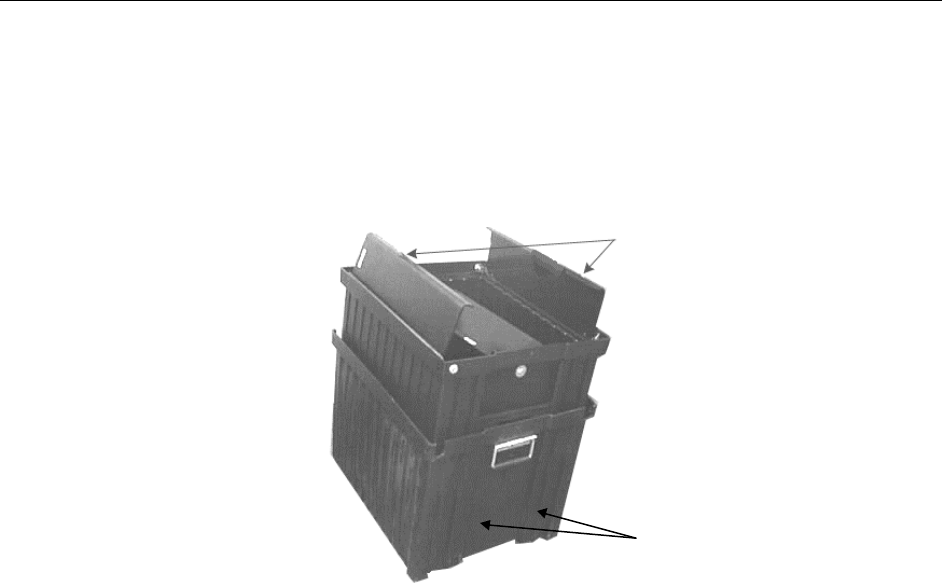
41
4. Turn the top section of the box so that the scanner compartment rests on the
floor. Lift the top section and align the indentations on the front of the top and
bottom of the ballot boxes. Lower the top half of the box into the bottom half.
5. Slide the divider into the left side of the top section until the top of the divider
rests below the top rim of the box. Do not force the divider into the box. If you
encounter any resistance when you slide the divider into the box, you are
attempting to place the divider on the wrong side of the box.
6. Locate the ballot box cover and align the front of the rim ( the side with the
indentation) with the front edge of the ballot box.
7. Place the cover onto the ballot box. Firmly press on the lid to engage the locks
on the top of the cover at the front and back of the nested box.
Top Section
Handles
Rim
Indentations

42

43
Appendix A: Maintaining the Counter
Perform the following maintenance tasks to keep your Model 100 scanner in proper
working order:
• Clean the scanner
• Clean the ballot box
• Maintain the internal printer
• Maintain the scanner battery
Cleaning the Scanner
Clean your scanner before and after each election.
To clean the scanner
1. Turn off the scanner and unplug the power cord.
Warning: Electrical Shock Danger. Always unplug the AC power
cord, turn the scanner’s key to the OFF position and remove the key
before you clean a Model 100 scanner.
2. Clean the ballot entry and exit slots with a can of pressurized clean, dry air or
inert gas, which is available for order from ES&S. Aim the air can’s spray tube
into the ballot entry slot and blow out all the debris. Clean the ballot exit slot in
the same way. Repeat the entire procedure and inspect the entrance and exit
slots with a flashlight.
3. Use pressurized air to remove dust and debris from around the menu display.
4. Use a soft cloth and water, or a mild solution of water and soap, to wipe down
the scanner. Dampen, do not soak, the cloth with the cleaning solution. Do not
spray cleaning solution directly onto the scanner.
5. Clean the menu display window with the damp cloth. Be careful not to scratch
the display panel. Then, clean the control panel buttons and the area around the
buttons.
6. Use the cloth and cleaning solution to clean the scanner’s outer case. Start at
the top and work down to the base.
7. Clean the scanner’s stainless steel base plate with the cleaning solution. Wipe all
traces of the cleaning solution off the scanner after you finish cleaning.

44
Cleaning the Ballot Box
Clean your Model 100 ballot boxes either before or after each election. You must
disassemble the nested box for cleaning. The metal box requires no disassembly.
To clean the ballot box
1. If you use the nested ballot box, separate the box into its two halves. For
instructions for disassembling the ballot box, see Chapter 4, “Assembling
the Ballot Box.”
2. Use a cloth dampened with cleaning solution to clear dust and debris from
the ballot box. For instructions for mixing cleaning solution, see “Cleaning
the Scanner,” earlier in this appendix.
3. Remove the divider from the lower ballot bin before you clean the bottom
section of the ballot box. Clean the inside of the bin first and then the
outside. Wipe down the interior ballot divider and the box cover.
Remember to periodically rinse the cleaning cloth.
4. Stand the ballot box upright to clean the recessed, scanner housing.
Important: Make sure the power cord and the diverter motor
connector are not damaged or dirty.
5. Turn the mounting pedestal upside down and clean the inside of the box.
Use a soft cleaning brush or feather duster to clear dust and debris. Use a
brush to clean the diverter vane, the diverter motor and the controller circuit
board for the ballot diverter. Do not to bend or damage any of the sensitive
components contained in the diverter motor assembly.
6. Use a brush to clean debris and dust from the ballot chute assembly. Do not
use liquids to clean the inside of scanner mounting pedestal. Re-assemble
the unit after you finish cleaning.
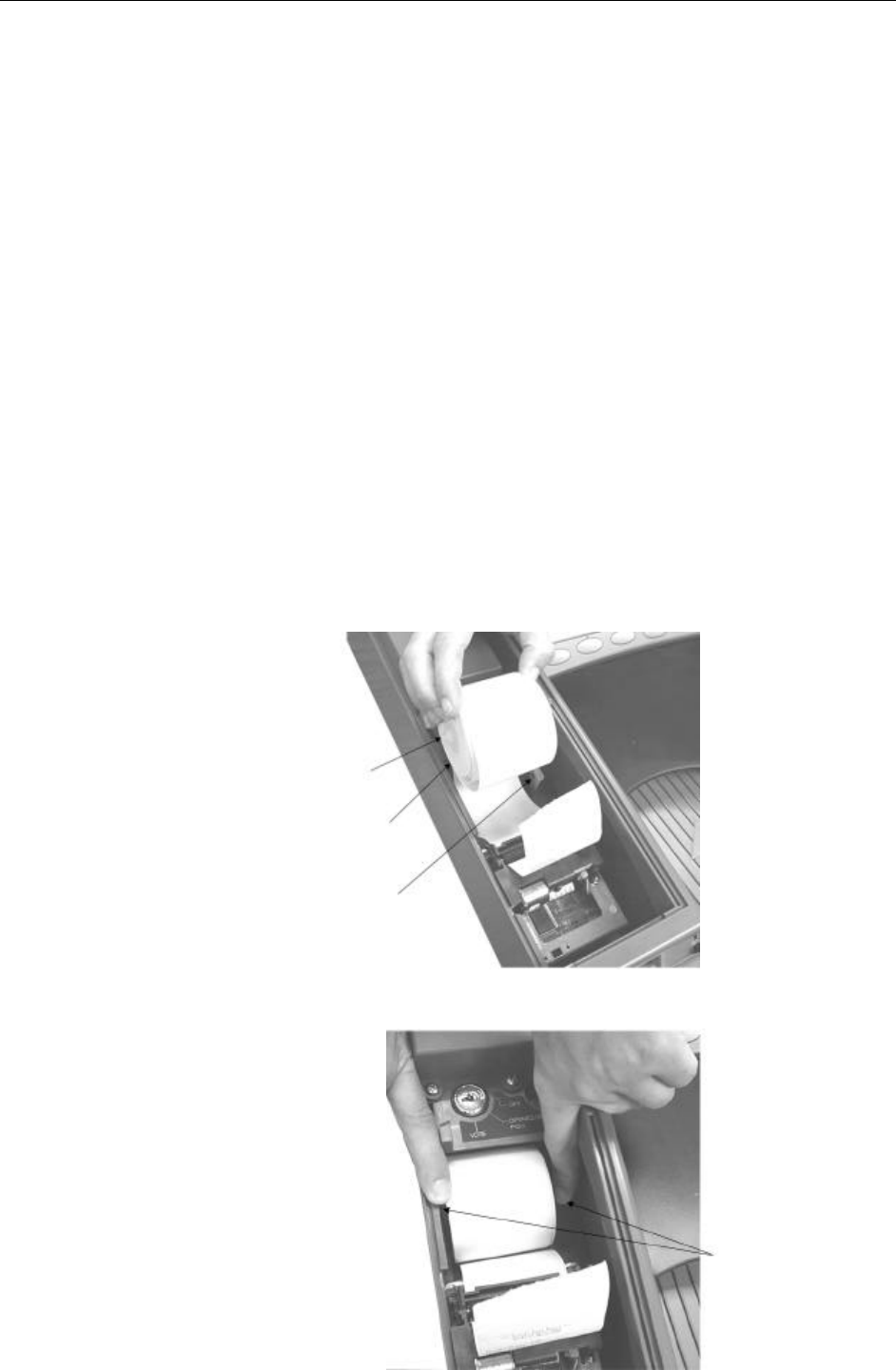
45
Maintaining the Internal Printer
Open the door on the left side of the scanner to access the internal printer.
Replacing the Paper Roll
Check the Model 100 printer and change the paper roll, if necessary, for Election
Day.
Note: A “time out waiting for paper” message may appear due to the internal
printer being out of paper.
To replace the paper roll
1. Depress the mounting brackets on each side of the empty paper roll and lift the
roll out of the scanner.
2. Remove the white plastic paper spool from the center of the empty paper roll
and insert it into a new roll. Press out on the paper mounting brackets and insert
the new roll into the printer.
3. Manually feed the paper or select PAPER FEED from the ELECTION
TEST menu to position the printer paper.
Paper Roll
Mounting
Brackets
Mounting
Bracket
Printer Paper
Printer Spool

46
Feeding the Paper
Use the following instructions to place blank space on the paper between reports or
to advance the paper if the printer jams.
To advance the paper
1. From the DIAGNOSTIC-TEST menu, select ELECTION TEST.
2. Select REPORTS in the ELECTION TEST menu.
3. Select PAPER FEED to advance the printer paper.
OR
1. From the POLLS CLOSED menu, select MORE.
2. Press PAPER FEED to advance the printer paper.
Maintaining the Scanner Battery
The Model 100 uses a 12-volt, 7-amp lead acid battery to power the scanner in
case of an electrical power failure. Depending on the age of your scanner, the
battery is either an Exide NP7-12 or Powersonic PS-1270. A fully charged
battery can power an “active” scanner for up to one hour and an “idle” scanner for
up to three hours. The machine is “active” when counting ballots or printing reports.
Estimated battery life is five years.
To check the charge for your backup battery, open the DIAGNOSTIC-TEST
menu and select DIAGS, then MORE DIAGS, and then select BATTERY
STATUS. Refer to the following instructions for more information.
Battery Cautions
Important: You can use the backup battery under normal operating
conditions, in any orientation without danger of leaking. Removing the
battery from the scanner exposes it to risks that are not present under
normal operating conditions.
Warning: Shorting the battery terminals together is especially
hazardous even if the battery is “discharged” or “dead.” Shorting the
terminals can create sparks, melt wires, and possibly start a fire. Use
extreme caution when handling the backup battery.
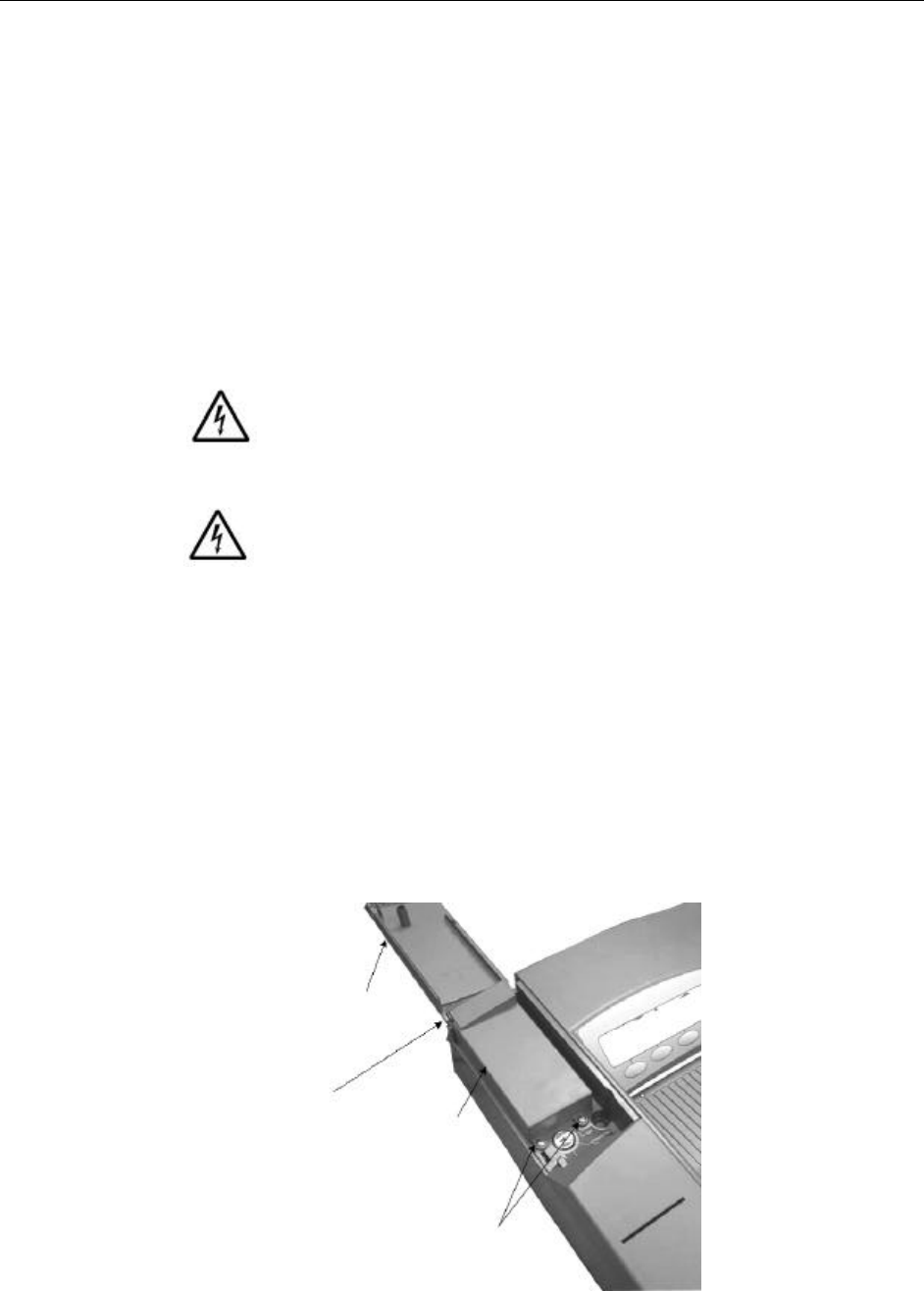
47
Note: The Model 100 battery may be recycled. Please dispose of the
battery properly.
Charging the Battery
Plug the power cord into the scanner and turn the power on for at least 12 hours to
fully charge the battery. Check the condition of your power cord if the message
“NO-AC” appears in the upper right quarter of the menu display after you turn the
scanner on.
Removing and Replacing the Battery
Warning: Do not attempt to replace the battery in the Model 100
scanner. Only qualified ES&S technicians should replace the battery for
this machine.
Warning: Electrical Shock Danger. Make sure that you unplug the
AC power cord, turn the scanner key to the OFF position and removed
it before replacing the battery.
Because you must remove the external cover of the Model 100 before you can
replace the battery, you should not attempt to replace the battery without proper
training from ES&S. Removing the cover exposes the scanner’s internal circuitry to
damage. Always contact ES&S technical support before you attempt to replace a
Model 100 backup battery.
To remove the battery
1. Open the Key Access Panel, locate the two screws for the Battery Access
Panel and remove the screws.
Key Access Panel
Hinge
Battery
Access
Panel
Battery Access
Panel Screws (2ea)
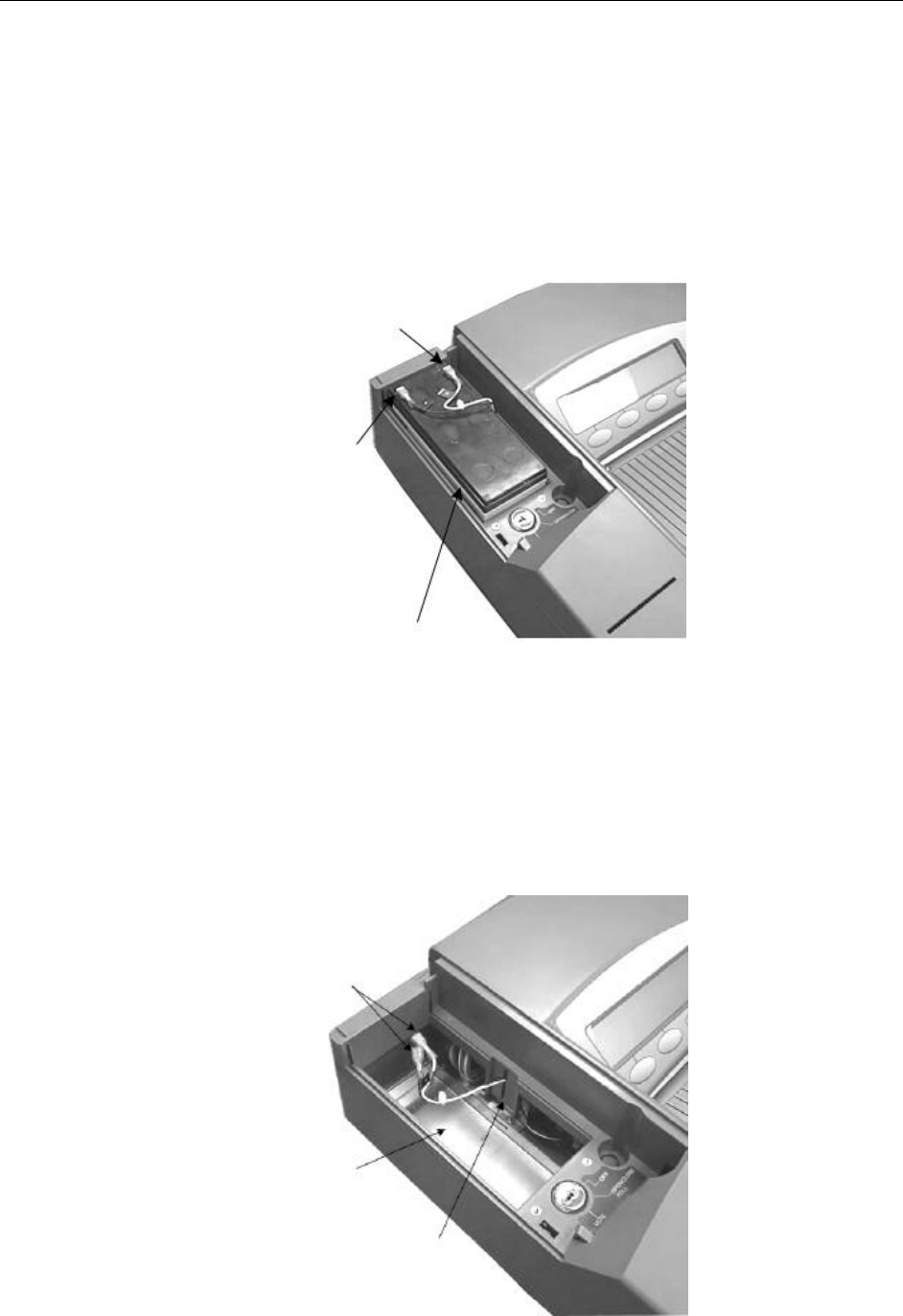
48
Black (Negative)
Terminal
Connector
2. Remove the two panels as one unit (with a hinge). Rotate the Key Access Panel
towards the closed position until the panels clear the slots. Remove the panel to
expose the battery.
3. Disconnect the red (positive) and black (negative) terminal connectors and lift
the battery out of the scanner housing.
4. Inspect the Model 100 battery compartment. Make sure the terminal wires are
properly threaded through the terminal wire slot in order to protect the wires
from crimping when you install a new battery.
Red (Positive)
Terminal
Connector
Battery
Terminal
Wires
Battery
Compartment
Slot for Terminal
Wires
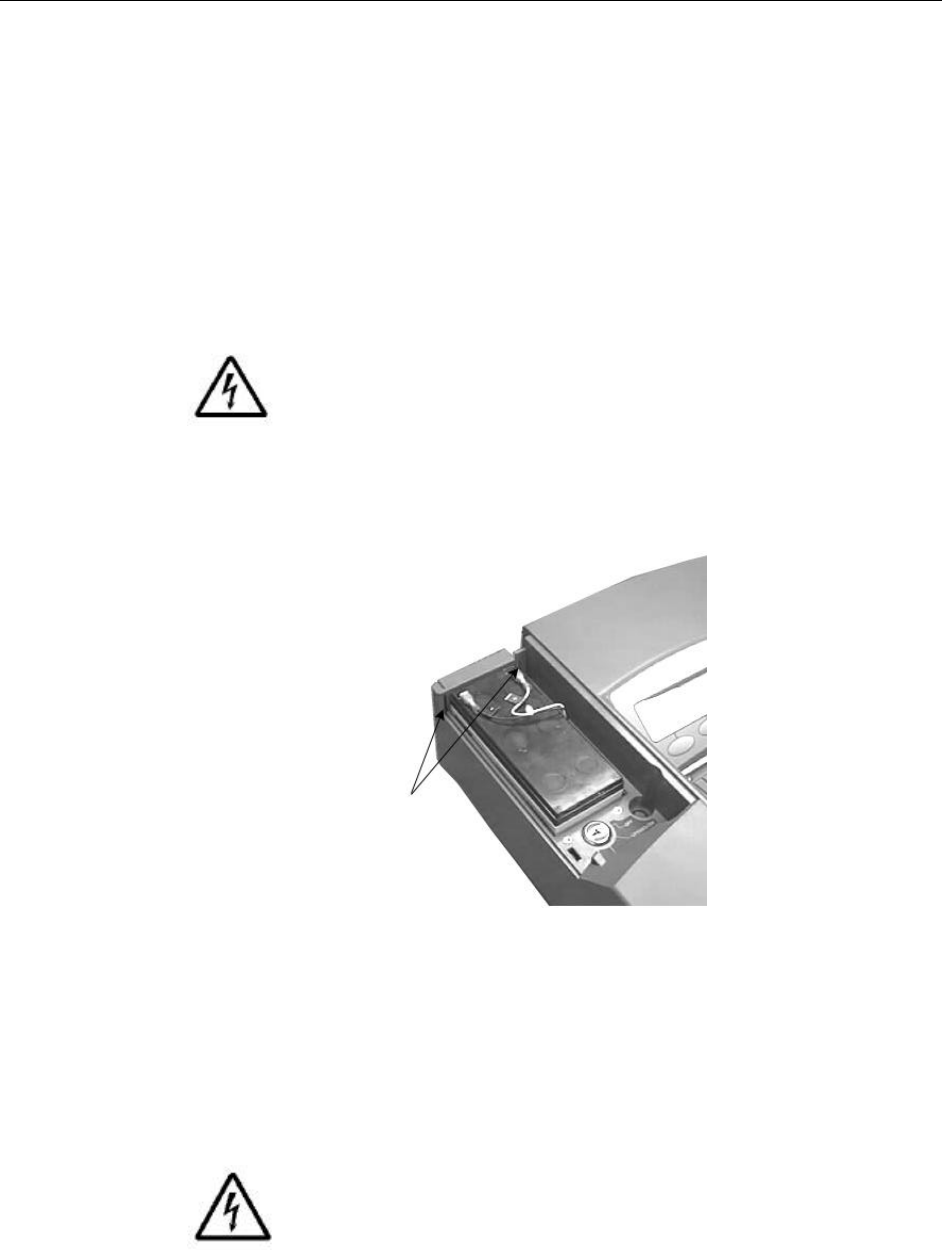
49
To install a new battery
1. Place a new battery into the battery compartment at the rear of the scanner.
2. Insert the red, positive wire from the terminal into the red battery connector on
the battery. Then, insert the black wire into the black battery connector.
Warning: Use caution when you connect the battery to the scanner.
Inserting a scanner wire into the wrong battery port can cause a short
circuit that can injure you or cause permanent damage to the scanner.
3. Insert the panel hinge into the scanner slots and reinstall the two access panels
(Key and Battery Access Panels).
4. Rotate the Battery Access Panel forward until the two screw holes align with
the nut plates on the main unit and insert the two screws.
5. Turn on the scanner for 24 hours to charge the battery then check the battery
status to confirm that the battery holds a charge.
To replace a Model 100 fuse
Warning: Electrical shock danger. Do not replace the fuse for the
Model 100 scanner unless you receive proper training from ES&S.
Only qualified ES&S technicians should attempt to replace the scanner
fuse.
Scanner
Slots
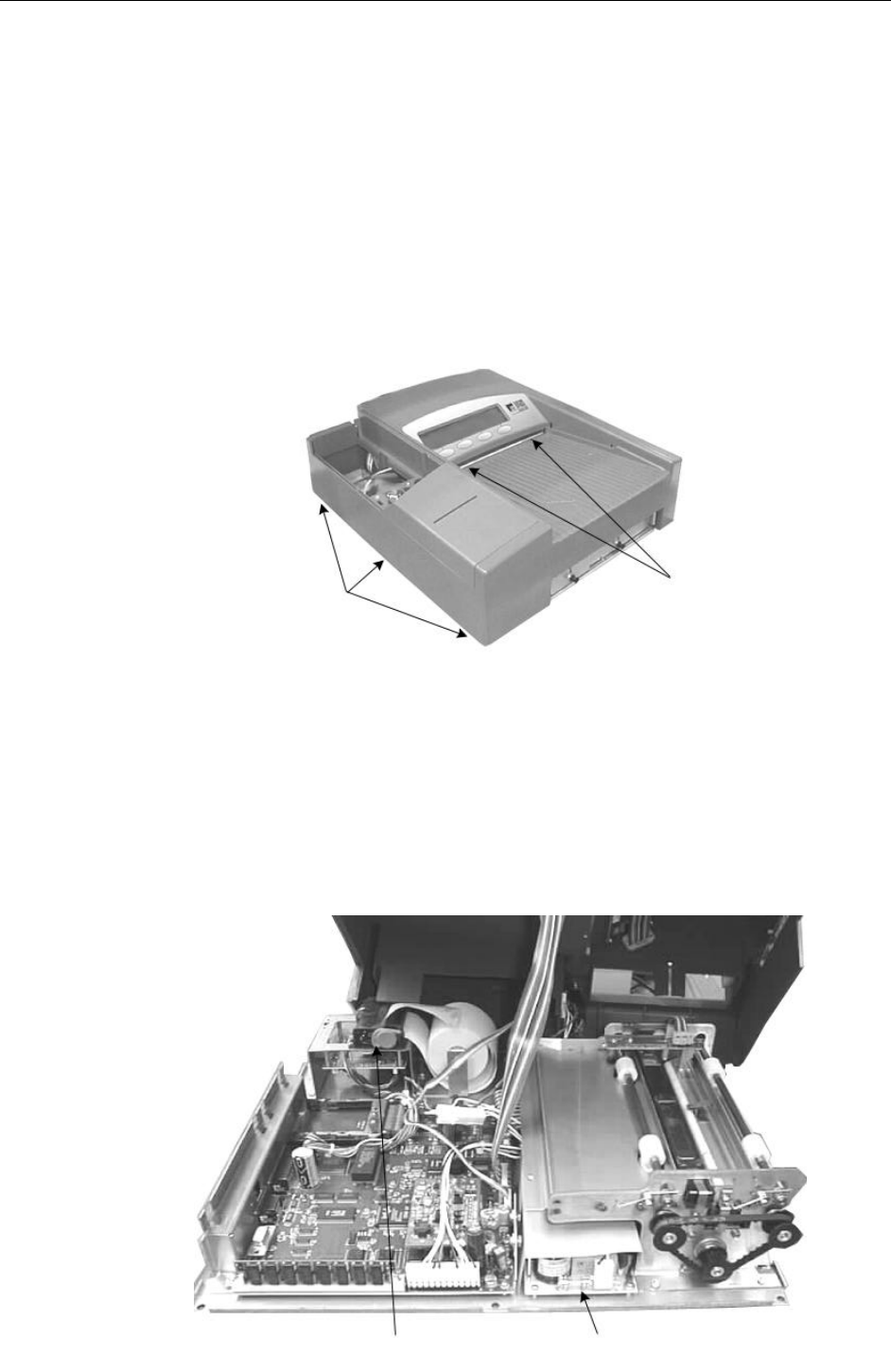
50
1. To replace the AC line fuse, turn the scanner key to the OFF position,
disconnect the power cord and remove the scanner from the Ballot Box. Then,
remove the battery (See “Removing and Replacing the Battery” in this chapter).
2. Turn the scanner on its side, and remove the six Phillips head screws that
connect the mounting rails to the stainless steel base plate. Set the mounting rails
aside and set the scanner upright.
3. Remove the ballot cover above the ballot input path to expose the two Phillips
head screws near the ballot insert slot. Remove the two Phillips head screws to
open the scanner’s outer case.
4. The Model 100 AC power supply module contains a 3 AG, 2-amp Fast-Blow
fuse. This power module is mounted on the left side of the stainless steel deck
plate near the center of the scanner. You can recognize the power supply by the
shield made out of stiff “fish” paper that surrounds the module. The fuse is
mounted on the outside edge of the power supply module and can be accessed
without removing the fish paper shield.
1
/16” Phillips
Head Screws
8/32” Phillips
Head Screws
Printer Fuse

51
5. After you replace the fuse, check the fish paper shield to make sure it remains in
place around the AC power supply module.
6. Replace the scanner’s cover and secure the eight mounting screws (six mounting
rails and two screws near the ballot insert slot). Route the cables from the cover
assembly away from the paper drive mechanism.
Note: For more information about reassembling the scanner, see the “Removing
and Replacing the Battery” section of this appendix.

52

53
Appendix B: Understanding Reports
The Model 100 generates a variety of election results reports. Appendix B contains
descriptions and examples of each available report. Familiarize yourself with the
available report formats and types to generate the proper reports for your
jurisdiction.
Results Reports
Select from the following report formats and types to configure reports for your
jurisdiction.
Report Format
ES&S or your jurisdiction’s election programmer hard code available report
formats into the Model 100 election definition. The report formats that you select
(either media or summary) affect the Poll Reports and Precinct Reports generated
directly from the Model 100. Reports printed in media format display candidate
names, candidate vote totals and write-in totals. Reports printed in summary format
display candidates, candidate vote totals, write-ins, undervote and overvote totals.
Report Types
Select from the following report types.
Status Report
The status report lists the number of ballots accepted by the scanner and
categorizes the ballots by type. This report also displays the ballot counts each
active precinct and the totals for your polling place.
Note: Counts of cross over votes are for statistical use and are not included in the
ballot totals.
Poll Report
The poll report lists results for every contest voted and recorded on the scanner.
Precinct Report
The precinct report displays the results for every contest voted on the scanner
broken down by precinct.

54
System Reports
The Model 100 can generate the following system reports.
Initial State Report
The initial state report is a descriptive list of system settings that automatically
generates when you turn on the scanner. The report includes a list of election
configuration settings if the election definition is loaded when you turn on the
scanner.
Audit Log Report
The audit log lists all of the scanner events that occur from the time you load your
election definition PC Card into the scanner to the time you remove the card after
your election is complete. The audit log also displays the total number of write-in
votes counted by the scanner as well as the number of accepted and rejected blank
ballots, the number of overvoted ballots and the number of crossover ballots
scanned.
Certification/Zero Report
The certification report, or zero report, prints automatically when you open the polls
for voting. The zero report lists the date and time that the polls open followed by the
vote count for all of your contests and blank signature lines for poll worker
certification. The Model 100 allows you to print an additional certification report
immediately after printing a results report.
Diagnostic Reports
The Model 100 prints the following diagnostic report types.
Configuration Report
The configuration report lists system and election configuration settings along with
scanning parameters and cell window locations.

55
Debug Report
The debug report displays low-level system settings. ES&S technical support uses
the debug report to diagnose problems with the Model 100.
System Report
Select the System Report to print a System Audit Log.
Status Report
***Status Report***
10:57:34 06/19/2002
Wisconsin Certification
Wisconsin Open Primary 17/41
0001 POLLING PLACE 1 0001
Election Date: July 4, 2002
WARD 1
Ballot Types:
DEM REP WIS LIB NON XRV
-------- -------- -------- ------- --------- ---------
0 1 0 0 0 0
Total: 1
WARD 2
Ballot Types:
DEM REP WIS LIB NON XRV
-------- -------- ------- ------ -------- --------
0 1 0 0 0 0
Total: 1
WARD 4
Ballot Types:
DEM REP WIS LIB NON XRV
-------- -------- ------- ------ -------- --------
0 1 0 0 0 0
Total: 1
WARD 5
Ballot Types:
DEM REP WIS LIB NON XRV
-------- -------- ------- ------ -------- --------
0 1 0 0 0 0
Total: 1
Grand Total
Ballot Types:

56
DEM REP WIS LIB NON XRV
-------- -------- ------- ------ -------- --------
0 1 0 0 0 0
Total: 1
Poll Report-Media Format
*** Voting Results Report ***
10:37:28 06/19/2002
Sample County
Test Election
0001 POLLING PLACE 1
Election Date: July 4, 2002
Total Number Voting: 50
Poll Voting Report
Total Ballots for All Precincts 50
Ballots for Code 000001-01-01 12
Ballots for Code 000002-01-01 14
Ballots for Code 000004-01-01 12
Ballots for Code 000005-01-01 12
GOVERNOR
WILLIAM A. (BILL) ALLAIN 18
BILLY M. DAVID 5
EVELYN GANDY 8
LONNIE C. JOHNSON 8
MIKE P STURDIVANT 5
Write In 4
AGRICULTURE AND COMMERCE COMMISSIONER
TROY MAJURE, JR. 19
JIM BUCK ROSS 18
CHARLES J.D. TILLMAN 8
Write In 3
CITY COUNCIL
Number to Vote For: 2
ELIZABETH M. VERTERANO 16
NICK DeROSA 23
CONNIE MANGINO 17
THOMAS P. COSTA 17
EUGENE DeCAPRIO 9
Write In 9

57
HIGH SCHOOL LEVY
FOR 12
AGAINST 27
Poll Report—Summary Format
*** Voting Results Report ***
10:37:28 06/19/2002
Sample County
Test Election
0001 POLLING PLACE 1
Election Date: July 4, 2002
Total Number Voting: 50
Poll Voting Report
Total Ballots for All Precincts 50
Ballots for Code 000001-01-01 12
Ballots for Code 000002-01-01 14
Ballots for Code 000004-01-01 12
Ballots for Code 000005-01-01 12
GOVERNOR
WILLIAM A. (BILL) ALLAIN 18
BILLY M. DAVID 5
EVELYN GANDY 8
LONNIE C. JOHNSON 8
MIKE P STURDIVANT 5
Write In 4
Over Votess 1
Under Votes 1
……………………………………………………………..
Total Votes 50
AGRICULTURE AND COMMERCE COMMISSIONER
TROY MAJURE, JR. 19
JIM BUCK ROSS 18
CHARLES J.D. TILLMAN 8
Write In 3
Over Votes 0
Under Votes 2
……………………………………………………………
Total Votes 50
CITY COUNCIL
Number to Vote For: 2
ELIZABETH M. VERTERANO 16

58
NICK DeROSA 23
CONNIE MANGINO 17
THOMAS P. COSTA 17
EUGENE DeCAPRIO 9
Write In 9
Over Votes 0
Under Votes 2
………………………………………………………………
Total Votes 100
Precinct Report—Summary Format
*** Voting Results Report ***
10:48:54 06/19-2002
Wisconsin Certification
Wisconsin Open Primary 17/41
0001 POLLING PLACE 1 0001
Election Date: July 4, 2002
Total Number Voting: 4
Precinct Voting Report
WARD 1
Total Ballots 1
Ballots for Code00001-01-01
PARTY PREFERENCE
DEMOCRAT 0
REPUBLICAN 1
WISCONSIN GREEN 0
LIBERTARIAN 0
Over Votes 0
Under Votes 0
……………………………………………….…..………
Total Votes 1
(REP) GOVERNOR
CHUCK HALE 1
Write In 0
Over Votes 0
Under Votes 0
……………………………………………….…..………
Total Votes 1
(REP) LIEUTENANT GOVERNOR
MICK FLEETWOOD 0
Write In 0
Over Votes 0
Under Votes 1
…………………………………………………...………

59
Total Votes 1
NONPARTISAN JUDICIAL RACE
JUDICIAL CANDIDATE 1 1
Over Votes 0
Under Votes 0
…………………………………………………...………
Total Votes 1
Initial State Report
10:57:25 06/19/2002
ELECTION DEFINITION LOADED UNIT: 3159
CPU 386 QNX_speed 361
CPU total memory 3712K
Application Memory 2496K
Communication utilities available
PCMCIA modems supported
TCP/IP based communications supported
*** Initial State Report ***
10:57:25 07/15/2003
Firmware Version: 5.1.0.0
Machine ID: 3159
Wisconsin Certification
Wisconsin Open Primary 17/41
0001 POLLING PLACE 1 0001
Election Date: July 4, 2003
Maximum Number of Types: 6
Number of Precincts: 4
Number of Ballot Face Styles: 24
Audit Log Entries: 34/21043
System Configuration:
Election Results Printing: Enabled
Election Results Transferred: YES
Diverter Installed: YES
Unreadable Marks Setting: Accept
Report Type: SUMMARY
Ability to ReOpen Polls: YES
Report Format: Poll Report
Report By Rotation: NO
Election Configuration:
Ballots by Style: NO
Overvoted Ballots: Query
Blank Ballots: Query
Cross-over Ballots: Query

60
Single Over-Vote: NO
Divert Blanks to Writein Bin: NO
Response Type: OVAL
Use Separate Non Party Type: YES
Ballot Size: 14 Inches by 36 Rows
Ballot Sides Defined: 2
Modem Info
Modem Phone #: 555-5555
Server IP: 192.168.1.5
M100 IP: 192.168.2.11
MAC (EID): 0060 D618 OABE

61
Audit Log Report
*** Audit Log Report ***
11:08:09 06/19/2002
System Events
Last Clock Change: 15:10:11 12/18/2001
Last Power On: 11:02:49 06/19/2002
Last Polls Open: 11:04:16 06/19/2002
Number of System Halts: 62
Ballot Accounting
Precinct:
WARD 3
Total Blank Accept: 0
Total Blank Reject: 0
Total Overvote Accept: 0
Total Overvote Reject: 0
Total Crossover Accept: 0
Total Crossover Reject: 0
Total Marginal Accept: 1
Total Marginal Reject: 0
Total Write-ins: 0
Total Undervote Accept 0
Total Undervote Reject 0
Master Accounting:
Total Blank Accept: 0
Total Blank Reject: 0
Total Overvote Accept: 0
Total Overvote Reject: 0
Total Crossover Accept: 0
Total Crossover Reject: 0
Total Marginal Accept: 1
Total Marginal Reject: 0
Total Write-ins: 0
Total Undervote Accept 0
Total Undervote Reject 0
11:02:49 06/19/2002
ELECTION DEFINITION LOADED UNIT: 3159
11:03:05 06/19/2002
User Event: Open Polls
11:03:09 06/19/2002
SUPERVISOR SWITCH DISENGAGED

62
11:03: 09 06/19/2002
DIAGNOSTICS CHECK COMPLETED
11:03:10 06/19/2002
COUNTERS CLEARED
11:04:16 06/19/2002
Polls Opened
11:04:53 06/19/2002
FIRST BALLOT PROCESSED
Zero/Certification Report
*** Zero Totals Report ***
11:03:10 06/19/2002
SAMPLE COUNTY
TEST ELECTION
POLLING PLACE 1
Election Date: November 11, 2000
Total Number Voting: 0
Poll Voting Report
GOVERNOR
WILLIAM A. (BILL) ALLAIN 0
BILLY M. DAVID 0
EVELYN GANDY 0
LONNIE C. JOHNSON 0
MIKE P STURDIVANT 0
Write In 0
Over Votes 0
Under Votes 0
Total Votes 0
AGRICULTURE AND COMMERCE COMMISSIONER
TROY MAJURE, JR. 0
JIM BUCK ROSS 0
CHARLES J.D. TILLMAN 0
Write In 0
Over Votes 0
Under Votes 0
Total Votes 0
CITY COUNCIL
Number to Vote For: 2
ELIZABETH M. VERTERANO 0
NICK DeROSA 0
CONNIE MANGINO 0
THOMAS P. COSTA 0
EUGENE DeCAPRIO 0
Write In 0
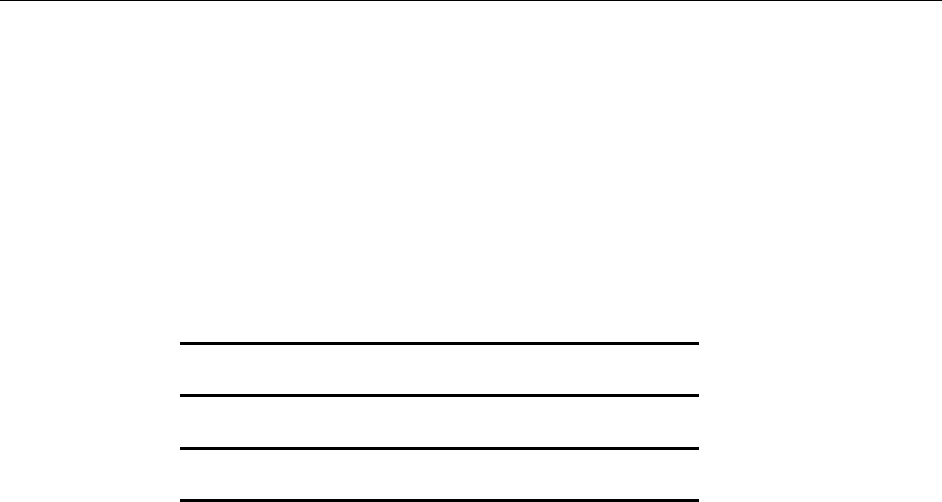
63
Over Votes 0
Under Votes 0
Total Votes 0
---Report Continued---
WE, THE UNDERSIGNED, DO HEREBY CERTIFY
THAT THE ABOVE RESULTS ARE A TRUE AND
ACCURATE ACCOUNT OF ALL BALLOTS COUNTED
AND THAT ALL COUNTERS WERE ZERO (0)
WHEN THE POLLS OPENED AND THAT THE
ELECTION WAS HELD IN ACCORDANCE WITH
THE LAWS OF THE STATE.
ELECTION JUDGE
ELECTION JUDGE
ELECTION JUDGE
ELECTION JUDGE

64
Configuration Report
*** Configuration Report***
11:10:10 06/19/2002
Firmware Version: 5.1.0.0
Machine ID: 3161
Wisconsin Certification
Wisconsin Open Primary 17/41
0002 POLLIN PLACE 2 0002
Election Date: July 4, 2002
Maximum Number of Types: 6
Number of Precincts: 1
Number of Ballot Face Styles: 6
Audit Log Entries: 14/20857
System Configuration:
Election Results Printing: Enabled
Election Results Transferred: NO
Diverter Installed: YES
Unreadable Marks Setting: Reject
Report Type: Summary
Ability to Reopen Polls: YES
Report Format: Poll Report
Report by Rotation: NO
Election Configuration:
Ballots by Style: NO
Overvoted Ballots: Query
Blank Ballots: Query
Cross-over Ballots: Query
Single Overvote: NO
Divert Blanks to Writein Bin: NO
Response Type: OVAL
Use Separate Non Party Type: YES
Ballot Size: 14 Inches by 36 Rows
Ballot Sides Defined: 2
Modem Information:
Modem Phone #: 333-4576
Server Phone #: (if applicable)
Modem MAC: (if applicable)
Modem Server IP address: (if applicable)
Scanning Parameters:
Top DAC Value: 80
Bottom DAC Value: 80
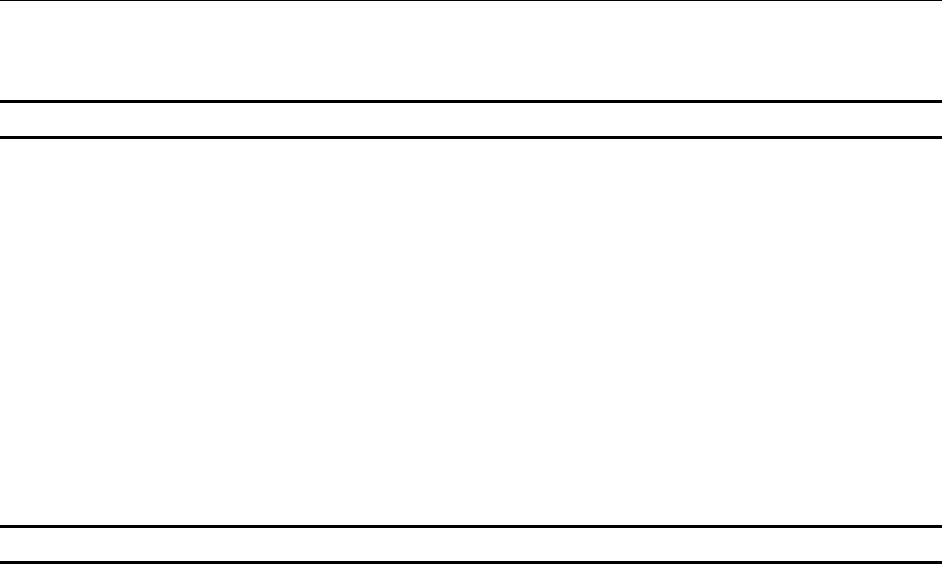
65
Ballot Size: 14 Inches x 36 Rows
Debug Report
*** DEBUG REPORT ***
11:09:48 06/19/2002
Program Version: 5.1.0.0
OS Version: 4.22
Errno: 35
Errno String: No message of desired type
Memory Available: 2860
Largest Mem Block: 2844
Heap Check: Good Heap
Counter Size: 2252 Bytes
Election Definition Size: 6308 Bytes
System Audit Log Report
*** System Audit Log ***
11:10:29 06/19/2002
Last Clock Change: 15:10:11 12/18/2001
Last Power On: 11:02:49 06/19/2002
Last Polls Open: 11:04:16 06/19/2002
Number of System Halts: 62

66

67
Appendix C: Understanding System
Messages
This appendix lists all system messages. In addition to the message itself, the
scanner beeps to provide an audible cue that a message requires attention from a
poll worker. If you find your message in this appendix and still require assistance,
please contact your election administrator to schedule technical service or a back-
up machine. Election administrators may contact ES&S at 1-800-247-8683.
System Error Recovery
If you encounter the ‘SYSTEM ERROR’ message, use the following process to
continue counting ballots.
1. Turn the key to the OFF position to turn off the tabulator, and then remove the
PC Card.
2. Make a duplicate copy of the PC Card.
3. Send the duplicate card with the Model 100 to ES&S for testing.
4. Replace the Model 100 with the back-up Model 100 tabulator assigned to your
polling place.
5. Insert the original PC Card with the election definition
6. Turn the key to OPEN/CLOSE POLL and continue counting ballots.
Understanding Text Messages
Accept Ballots For Precinct
Cause: The “Accept Ballots For Precinct” message appears when the Model 100 enables a
precinct that has been programmed in the election definition card, but marked as inactive.
Solution: Ballots for the enabled precinct are counted and cannot be canceled. No response
required.
Attempt Send Results
Cause: This message appears when the Model 100 locates a TCP/IP protocol, CDPD, or
landline network attempts to send election results.

68
Solution: No response required.
Audit Log Full
Cause: This message appears if audit log is full. There is a limited capacity for audit log entries
stored to the PC Card. Exceeding this limit either: 1) prevents the scanner from entering Polls
Open mode, or 2) causes the scanner to stop counting ballots. If the Audit Log exceeds its
capacity during voting, the scanner defaults to a read-only mode. This means that no
additional information is added to the PC Card; the Polls Open mode is not allowed.
Solution: A new PC Card is required to continue counting ballots. Select Previous to return to
the Main menu. Remove the original PC Card and insert a new card programmed with a
duplicate election definition. Return to the menu and function where the error occurred and
contact your system administrator.
Ballot Jammed
Cause: This message appears if a ballot becomes trapped in the scanner’s read area.
Solution: Check the back of the scanner to make sure that nothing blocks the ballot path.
Contact ES&S for assistance if you cannot resolve the problem.
Blank Ballot Accepted
Cause: This message appears after the scanner accepts a blank ballot.
Solution: No response required.
Blank Ballot Returned
Cause: This verification appears when the scanner returns a blank ballot to the voter.
Solution: No response required.
Blocked Sensor Continuous
Cause: This message appears if the scanner detects an obstruction on part of the CCD array
Read-Head, or a contiguous vertical line on the ballot.
Solution: First, make sure the machine is not in vote mode. Then try feeding clean, blank
ballots into the scanner to remove any possible obstruction. If the error continues, contact
your election administrator to schedule technical service and a back-up machine.
Counter Block Failed CRC
Cause: This message appears if the counter block fails a cyclic redundancy check (CRC). As
the election progresses, data is copied to the PC Card in “counter blocks” of data. The CRC is
a safety check that the scanner performs to ensure proper copying of data to the card.
Solution: The PC Card may be corrupt. Try a different card. If the message continues, contact
your election administrator to schedule technical service.

69
Counters Are Full
Cause: This message appears if the scanner blocks on the PC Card are full and there is no
room to write further election data to the card. Results from the ballot currently inserted in the
machine are not added to the scanner’s running total.
Solution: The system halts when counters are full. Turn the power switch OFF and then back
ON to reboot the system. Keep the PC Card loaded in the scanner. If the error continues,
contact your election administrator to schedule technical service.
Counters Are In Overflow
Cause: The counter has exceeded its storage limit. If this error occurs, the election results
stored to the scanner’s DRAM are corrupt, although the scanner values on the card may be
correct.
Solution: This error causes a system halt. Reboot the system by turning the power switch OFF
and then back ON. Keep the PC Card loaded in the scanner. If the error persists, contact your
election administrator to schedule technical service and locate a backup tabulator.
Counters Cannot Hold Next Count
Cause: There is not enough space left within the counters to store the count for the current
race.
Solution: This condition causes a system halt. Reboot the system by turning the power switch
OFF and then back ON. Leave the PC Card loaded in the scanner. If the error persists, contact
your election administrator to schedule technical service and request a backup tabulator.
Counters Cleared
Cause: This message appears after the DRAM counters are successfully cleared in the
election definition.
Solution: No response required.
Cross Voted Ballot Accepted
Cause: This is a verification message that confirms that a cross-voted ballot has been
accepted by the Model 100.
Solution: This message only appears with straight party or pick-a-party ballots, when a voter
has voted in more than one party. No response required.
Cross Voted Ballot Returned
Cause: This message appears when the scanner returns a cross-voted ballot to the voter.
Solution: This message only appears with straight party or pick-a-party ballots, when a voter
has voted in more than one party. Return the ballot to the voter for review or verification.

70
Diverter Control Error
Cause: This message appears if the scanner fails to change the diverter position after a ballot
has been fed.
Solution: Retry and contact ES&S if the problem persists.
Diverter Not Detected
Cause: The scanner cannot detect the diverter on a second attempt.
Solution: Contact your election administrator to schedule technical service and request a
backup tabulator.
Diverter Not Found
Cause: This message appears if the election definition loaded into the Model 100 is
programmed for a ballot box with a diverter unit, but no diverter unit is detected.
Solution: Contact your election administrator to schedule technical service and request a
backup scanner.
DRAM Counter Space Bad
Cause: This message appears if the scanner encounters a problem with the DRAM memory
section that stores the election results.
Solution: Contact your election administrator to schedule technical service and request a
backup scanner.
Election Card Recovered In The Machine
Cause: This verification message indicates that the inserted card been opened and removed
from another machine, while still in the vote mode.
Solution: No response required.
Election Certified – Card In Rom Mode
Cause: The election has been certified and the card is closed. You may remove the card from
the scanner after viewing this message.
Solution: No response required.
Election Definition Failed CRC
Cause: This message indicates that the election definition failed the CRC.

71
Solution: The PC Card may be corrupt and a new PC Card is required. If the message
continues, contact your election administrator to schedule technical service.
Election Totals Cleared
Cause: This verification message indicates that election totals are set to zero.
Solution: No response required.
Error Accessing NVRAM
Cause: This message appears if the scanner encounters a problem accessing the NVRAM
(Non-Volatile Random Access Memory).
Solution: Contact your election administrator to schedule technical service and request a
backup scanner.
Error Getting Machine ID
Cause: This message appears if the scanner has a problem retrieving the machine
identification number from FLASH memory.
Solution: Contact your election administrator to schedule technical service and request a
backup scanner.
Error Reading Ballot Retry Ballot Black Check - <code> (x)
Cause: This message appears if the scanner cannot read one of the black boxes printed at the
top and bottom of each ballot column. The displayed <code> will be one of the following: UT –
ballot fed face up, top first; UB – ballot fed face down, bottom first; DT – ballot fed face down,
top first; DB – ballot fed face down, bottom first. The (x) indicates the letter, A-F, that appears
in the error message and identifies which black check the scanner failed to read.
Solution: Feed the ballot into the scanner in a different orientation. If the mark still does not
register, use compressed air to clean the Model 100 optical sensors. If the scanner still does
not read, manually darken the black check mark with a sharpie and scan the ballot again.
Error Reading PCMCIA Card
Cause: This message appears if the scanner encounters a problem reading a block of data
from the PC Card. The election results stored to the scanner’s DRAM may be corrupt.
Solution: This condition causes a system halt. Reboot the system by turning the scanner OFF
and then back ON with the PC Card inserted. If the error continues, attempt to restart the
scanner with a new PC Card. If there are still problems, contact your election administrator to
schedule technical service and request a backup scanner.

72
Error Reading System Audit Log
Cause: This message appears if an error occurs while the scanner reads the system Audit Log
in NVRAM (Non-Volatile Random Access Memory).
Solution: Allow the system to initialize the System Audit Log with default values. The system
automatically initializes the log to default settings and displays a status message.
Error Seeking On PCMCIA Card
Cause: This message appears if the scanner encounters a problem while seeking a specific
offset on the PC Card.
Solution: This condition causes a system halt. Reboot the scanner by turning it OFF and then
back ON with the original PC Card inserted. If the error persists, attempt to reboot the system
with a new PC Card. Turn the system off and insert a new card programmed with a duplicate
election definition. Turn the system back on. If the continues, contact your election
administrator to schedule technical service and request a backup scanner.
Error Setting Real Time Clock
Cause: This message appears if you encounter a problem setting the real-time clock.
Solution: Contact your election administrator to schedule technical service and request a
backup scanner.
Error Writing PCMCIA Card
Cause: This message appears if the scanner encounters a problem while writing data to the PC
Card. This condition can corrupt election results if the error occurs while your scanner is open
for voting.
Solution: This error causes a system halt. Turn the scanner OFF and then back ON, without
removing the PC Card, to re-initialize your election. If the error continues, try to reboot the
system using a new PC Card with a duplicate election definition. If there are still problems,
contact your election administrator to schedule technical service and request a backup
scanner.
Error Writing System Audit Log
Cause: This message appears if an error occurs while the scanner is writing the system audit
log in NVRAM (Non-Volatile Random Access Memory).
Solution: Allow the system to initialize the System Audit Log with default values. The system
automatically initializes the log to default settings and displays a status message.

73
Error Writing To The Print Device
Cause: This message displays if the system encounters a printer processing error.
Solution: Contact your election administrator to schedule technical service and request a
backup scanner.
Event Log Failed CRC
Cause: The Event Log failed the Cyclic Redundancy Check (CRC). A CRC is a safety check
the counter performs to ensure that data is being copied properly.
Solution: This condition indicates that your PC Card may be corrupt; either reprogram the
same PC Card or try a different card programmed with a duplicate election definition. If the
error continues, contact your election administrator to schedule technical service and request
a backup scanner.
Factory Parameters Corrupt-Reset
Cause: The factory parameter values in NVRAM do not match the CRC calculation. This error
only occurs during the boot process.
Solution: Contact your election administrator for assistance.
Incompatible PCMCIA Card Format
Cause: This message indicates that the PC Card format is incompatible with the current
application code version.
Solution: Contact your election administrator to schedule technical service.
Incompatible System Log Format
Cause: This message indicates that the System Log format is incompatible with the current
application code version.
Solution: Contact your election administrator to schedule technical service.
Invalid Instruction
Cause: This is an internal error message.
Solution: Contact your election administrator to schedule technical service.

74
Invalid Memory Reference
Cause: This is an internal error message.
Solution: Contact your election administrator to schedule technical service.
Invalid Parity Error
Cause: This is an internal error message.
Solution: Contact your election administrator to schedule technical service.
Invalid Seq-Type-Split (X-X-X)
Cause: This message indicates that the Sequence-Type-Split code on an inserted ballot does
not match the codes defined in the election definition. The ‘X’ values will be the Sequence-
Type-Split code of the scanned ballot.
Solution: Insert a ballot with the correct Sequence-Type-Split code. If the error occurs again,
contact your election administrator to schedule technical service.
Invalid Sub Routine
Cause: This is an internal error message.
Solution: Contact your election administrator to schedule technical service.
Memory Allocation Error
Cause: This message indicates that the scanner did not successfully allocate system memory.
Solution: This condition may halt the system. Even if the scanner does not halt, contact your
election administrator to schedule technical service and request a backup scanner.
Menuing System Error
Cause: This message appears when the scanner encounters a system error.
Solution: This condition may halt the system. Even if the scanner does not halt, contact your
election administrator to schedule technical service and request a backup scanner.
Missing Precinct Counter Block
Cause: This message appears if the scanner cannot locate the race counter block for a given
race.
Solution: Contact your election administrator to schedule technical service.

75
More than one party has votes. Votes In Party Contests Will Be Ignored
Cause: This condition only occurs during an open primary election. This message indicates
that a party preference selection could not be established and the voter marked contests
affiliated with more than one party,
Solution: If you programmed your election definition to “Query upon Occurrence” of a cross-
voted ballot, the poll worker is responsible for accepting or rejecting the ballot. If you
programmed the election definition to “Always Reject” cross-voted ballots, the voter must re-
mark and resubmit the ballot. If the error continues, contact your election administrator to
schedule technical service.
Note: This error message does not appear if you programmed the Model 100 to “Always
Accept” cross-voted ballots.
NO BACK IMAGE DETECTED/Please See Election Official
Cause: The scanner displays this message if the Model 100 does not detect a contest on the
back of the ballot when the ballot’s sequence-type-split code indicates that information should
appear on the back of the ballot.
Solution: Contact your election administrator.
One Contest Has Too Many Votes
Cause: This message appears if the number of valid marks detected in the voting area for a
contest exceeds the number of votes allowed for that contest.
Solution: If you programmed your election definition to “Query upon Occurrence” of an
overvoted ballot, the poll worker must review the ballot and then decide whether to accept or
reject the voter’s selections. If you programmed the election definition to “Always Reject”
overvoted ballots, the voter must edit and resubmit the ballot. If this message appears for a
ballot that does not contain an overvoted contest, contact your election administrator to
schedule technical service.
Note: This error message does not appear if you programmed the Model 100 to “Always
Accept” overvoted ballots.
One Contest Has Too Many Votes (RACE TITLE)
Cause: This message appears if the number of valid marks detected on the ballot for a contest
exceeds the number of votes allowed for that contest. This message appears if you program
the election definition to display the contest title along with the error condition.
Solution: If you programmed your election definition to “Query upon Occurrence” of an
overvoted ballot, the poll worker must review the ballot and then decide whether to accept or

76
reject the voter’s selections. If you programmed the election definition to “Always Reject”
overvoted ballots, the voter must edit and resubmit the ballot. If this message appears for a
ballot that does not contain an overvoted contest, contact your election administrator to
schedule technical service.
Note: This error message does not appear if you programmed the Model 100 to “Always
Accept” overvoted ballots.
(X) Races Have Too Many Votes
Cause: The Model 100 displays this message if the number of valid marks detected for more
than one contest on the ballot exceeds the number allowed votes for each of those contests.
Solution: If you programmed your election definition to “Query upon Occurrence” of an
overvoted ballot, the poll worker must review the ballot and then decide whether to accept or
reject the voter’s selections. If you programmed your election definition to “Always Reject”
overvoted ballots, the Model 100 returns the ballot to the voter who must edit and resubmit
the ballot. If the error appears for a ballot that does not contain an overvoted contest, contact
your election administrator to schedule technical service.
Note: This error message does not appear if you programmed the Model 100 to “Always
Accept” overvoted ballots.
(X) Races Have Too Many Votes Including RACE TITLE
Cause: This message appears if the number of valid marks detected for more than one contest
exceeds the number of votes allowed for each of those contests. This message appears if you
program the election definition to display the contest title along with the error condition.
Solution: If you programmed your election definition to “Query upon Occurrence” of an
overvoted ballot, the poll worker must review the ballot and then decide whether to accept or
reject the voter’s selections. If you programmed your election definition to “Always Reject”
overvoted ballots, the Model 100 returns the ballot to the voter who must edit and resubmit
the ballot. If the error appears for a ballot that does not contain an overvoted contest, contact
your election administrator to schedule technical service.
Note: This error message does not appear if you programmed the Model 100 to “Always
Accept” overvoted ballots.
OS Shell Command Fail
Cause: This message appears if system call in the Model 100 code fails to function correctly.
Solution: This condition may cause a system halt. Even if the system remains in operation,
contact your election administrator to schedule technical service and request a backup
scanner.
Overvoted Ballot Accepted
Cause: This verification message appears when the scanner accepts a ballot that contains an
overvoted contest.

77
Solution: No response required.
Overvoted Ballot Returned
Cause: The Model 100 displays this message when the scanner returns a ballot that includes
an overvoted contest to the voter.
Solution: No response required.
Party Preference Race Missing
Cause: This message appears if the scanner processes a ballot that includes a party
preference contest and the selected party preference is not detected in the election definition.
Solution: You may require a new election definition. Contact your election administrator for
assistance.
PCMCIA Card Not Inserted
Cause: This message appears if the PC Card is removed while the scanner attempts to access
the card.
Solution: This condition causes a system halt and may corrupt the data stored to the PC Card.
Attempt to re-initialize the card by turning the system off, re-inserting the card, and turning the
power back on. If this action fails, you may require a new PC Card. Try the same procedure
with a different PC Card programmed with a duplicate election definition. If the error continues,
contact your election administrator to schedule technical service and request a backup
scanner.
PCMCIA Driver Missing
Cause: The message appears if the scanner cannot access the QNX/PC Card driver.
Solution: This condition causes a system halt. Contact your election administrator to schedule
technical service and request a backup scanner.
PCMCIA Header Section Failed CRC
Cause: This message appears if the header section of the PCMCIA card fails the CRC.
Solution: This message indicates that your PC Card may be corrupt. Try a different card. If the
error continues, contact your election administrator to schedule technical service.
Possible Bad Sensor
Cause: This message appears if the scanner detects an unacceptably long vertical line on a
ballot.
Solution: Retry the ballot. If the problem continues, contact the election supervisor.

78
Possible Blocked Sensor
Cause: This message appears if the scanner detects an intermittent obstruction on part of the
Read-Head, an intermittent fault in the CCD array Read-Head, or a non-contiguous vertical line
on the ballot.
Solution: Make sure that your scanner is not in the vote mode and then attempt to scan
entering clean, blank ballots to remove possible obstructions. If the error continues, contact
your election administrator to schedule technical service and request a backup scanner.
Printer Driver Missing
Cause: This message appears if the Model 100 fails to detect the printer driver.
Solution: Contact your election administrator to schedule technical service and request a
backup scanner.
Race Results Cross-Check Fail
Cause: The Model 100 displays this message if the race result counters fail the system cross-
check (between the precinct and master counters). This condition indicates that the election
results stored in the system’s DRAM are corrupt. The vote count results stored on the PC
Card may be corrupted.
Solution: This condition causes a system halt. Reboot the system by turning the power switch
OFF and then back ON to re-initialize the PC Card. If the system reads the card correctly,
continue with the election process. If the error continues, contact your election administrator
for a new card.
Note: The Model 100 does not record results from the ballot scanned when this error occurs.
You must remove and rescan the ballot.
Status Results Cross-Check Fail
Cause: This message appears if the status counters fail the cross-check (between the precinct
and master counters). This condition indicates that the election results stored in DRAM are
corrupt.
Solution: This condition causes a system halt. Reboot the system by turning the power switch
OFF and then back ON to re-initialize the PC Card. If the system reads the card correctly,
continue with the election process. If the error appears again, contact your election
administrator for a new card.

79
Note: You must remove and rescan the ballot that was in the scanner when the error occurred.
System Audit Log Failed CRC
Cause: This message appears if the System Audit Log stored to NVRAM fails the CRC. The
software attempts to initialize the log with default values. If this operation is unsuccessful, the
system shuts down.
Solution: Allow the system to initialize the System Audit Log using default values. If the
initialization shuts down the system using default values, contact your election administrator
to schedule technical service and request a backup scanner.
System Halted
Cause: The system has halted.
Solution: Restart the counter by turning the scanner key to the OFF position and then back
ON. If the scanner does not restart, contact your election administrator to schedule technical
service and request a backup scanner.
Unable To Initialize Scanning System-System Halted
Cause: This message indicates that an error occurred when your Model 100 attempted to
automatically initialize the machine scanner board.
Solution: Contact ES&S.
Unable To Load Keypad Server-System Halted
Cause: This message appears if the scanner fails to detect the keypad server.
Solution: Contact ES&S.
Unable To Load Signal Handlers-System Halted
Cause: This message appears if the scanner fails to detect signal handlers.
Solution: Contact ES&S.
Unable To Load Speaker Server-System Halted
Cause: This message appears if the scanner fails to detect the speaker server.
Solution: Contact ES&S.

80
Unable To Update Counters
Cause: This message appears if the scanner software fails to update the counters after you
scan a ballot.
Solution: This condition causes a system halt and requires a new PC Card to resolve. Turn off
the scanner, insert a new PC Card with a duplicate election definition and turn the scanner
back on. If the problem continues, contact your election administrator to schedule technical
service and a request a backup scanner.
Unable To Close Election
Cause: This message appears if scanner software fails to access the PC Card when you
attempt to close the election.
Solution: Check the PC Card for proper installation. If the card is installed properly, the card
may be defective or another hardware fault may have occurred. If the problem continues,
contact your election administrator to schedule technical service and request a backup
scanner.
Unable To Read PCMCIA Counter Block
Cause: This message appears if the system software fails to read the PC Card counter block.
Solution: Check the PC Card for proper installation. If the card is installed properly, the card
may be defective or another hardware fault may have occurred. If the problem continues,
contact your election administrator to schedule technical service and request a backup
scanner.
Unidentified Mark – Check Your Ballot
Cause: This message appears if the scanner detects a mark that meets the minimum threshold
for recognition by the system, but is not dark enough for the scanner to read as a valid vote.
Solution: Re-mark or darken the marks and rescan the ballot.
Unknown Error
Cause: This message appears if the Model 100 detects an internal system error.
Solution: Contact your election administrator to schedule technical service.
Voltage Too Low
Cause: This message appears if the scanner’s battery voltage falls below the acceptable
operating level.

81
Solution: Plug the terminal into a 120-volt A/C outlet. For more information about charging the
scanner battery, see “Charging the Battery” in Chapter 2. If the problem persists, contact your
election administrator to schedule technical service and request a backup scanner.
Voting Continued Prev Unit
Cause: This verification message appears if you successfully transfer a PC Card from one
Model 100 to another during active voting. The Model 100 also displays the machine ID for
the scanner that was previously using the card.
Solution: No response required.
Warning-The unit is on Battery Power
Cause: This message appears if the AC connection in the back of the machine has been
unplugged or if the scanner’s outlet fails to receive power.
Solution: Check the power cord connections to the scanner and wall outlet. Contact the
supervisor for your polling place if the scanner continues to run on battery power after you
properly plug it in.
Working Parameters Corrupt-Reset
Cause: This message appears if the working parameter values stored to the scanner’s NVRAM
do not match those calculated during the CRC. This error can only occur during the scanner’s
boot sequence
Solution: Contact your election administrator to schedule technical service and request a
backup scanner.
XBIN Directory Not Found
Cause: This message appears if a required XBIN directory does not exist because the binary
executable image block required for TCP/IP or PSMCIA modems was not programmed to the
election definition card, or the card could not be started successfully by the resource manager.
Solution: Contact your election administrator to schedule technical service and request a
backup scanner.

82

83
Verification Messages
The following verification messages are self-explanatory, descriptive messages that
the Model 100 displays in response to a specific action. Verification messages do
not require action from a poll worker.
• Aborted Printing
• Counters Cleared
• Current Unit
• Diagnostic Check Completed
• Election Definition Loaded
• Election Definition Unloaded
• Election Results Sent
• Entered Ballot Test Mode
• Exited Ballot Test Mode
• First Ballot Processed
• No Election Card
• Opening Polls
• Polls Closed
• Polls Opened
• Power On
• Real Time Clock Set
• Switched to AC Power
• Switched to Battery Power
• Total Ballots Accepted
• Voting Enabled

84
Understanding Numeric Messages
100 – MISSED ORIENTATION MARKS/Turn Ballot Over and Try Again
Cause: The scanner failed to detect the orientation of a ballot.
Solution: Remove the ballot from the scanner and attempt to feed the ballot in a different
orientation. If the error continues, contact your election administrator to schedule technical
service and request a backup scanner.
101 – MISSED TIMING MARKS/ Turn Ballot Over and Try Again
Cause: The scanner failed to detect one or more marks that appear in the ballot’s timing track.
Solution: Remove the ballot and reinsert it into the scanner. If the error persists, contact your
election administrator to schedule technical service and request a backup scanner.
102 – NO DATA FOUND/Please Re-insert Ballot After Beeps
Cause: The scanner failed to locate the leading edge of an inserted ballot.
Solution: Remove and reinsert the ballot. If the error continues, contact your election
administrator to schedule technical service and request a backup scanner.
103 – SYSTEM ERROR/Please See Election Official
Cause: The scanner encountered an unrecoverable error occurred in the operating system.
Solution: Contact your election administrator to schedule technical support and request a
backup scanner.
104 – ORIENTATION SKIP ERROR
Cause: The scanner failed to read the black checks on the leading edge of a ballot.
Solution: Remove and reinsert the ballot. If the error persists, contact your election
administrator to schedule technical service and request a backup scanner.
105 – SYSTEM ERROR/Please See Election Official
Cause: The scanner encountered an unrecoverable error in the operating system..
Solution: Contact your election administrator to schedule technical support and request a
backup scanner. Do not use the scanner until an ES&S service technician identifies and repairs
the problem.

85
106 – MISSED TIMING MARKS/ Turn Ballot Over and Try Again
Cause: The scanner failed to properly read one or more marks from a ballot’s timing track
Solution: Remove and reinsert the ballot. If the error persists, contact your election
administrator to schedule technical service and request a backup scanner.
107 – BALLOT ERROR: INVALID CC SEQUENCE
Cause: The scanner failed to read the correct sequence code from a ballot.
Solution: Remove and reinsert the ballot. If the error persists, contact your election
administrator to schedule technical service.
108 – BALLOT ERROR: INVALID CC TYPE
Cause: The scanner failed to recognize the type code for a ballot.
Solution: Remove and reinsert the ballot. If the error persists, contact your election
administrator to schedule technical service.
109 – BALLOT ERROR: INVALID CC SPLIT
Cause: The scanner failed to recognize a ballot’s split code.
Solution: Remove and reinsert the ballot. If the error persists, contact your election
administrator to schedule technical service.
110 – SYSTEM ERROR/Please See Election Official
Cause: The scanner encountered an unrecoverable error in the operating system.
Solution: Turn off the scanner and remove it from the polling area. Contact your election
administrator to schedule scanner maintenance. Do not use the scanner again until an ES&S
technician repairs the Model 100.
111 – SYSTEM ERROR/Please See Election Official
Cause: The scanner encountered an unrecoverable error in the operating system.
Solution: Turn off the scanner and remove it from the polling area. Contact your election
administrator to schedule scanner maintenance. Do not use the scanner again until an ES&S
technician repairs the Model 100.

86
112 – SYSTEM ERROR/Please See Election Official
Cause: The scanner encountered an unrecoverable error in the operating system.
Solution: Turn off the scanner and remove it from the polling area. Contact your election
administrator to schedule scanner maintenance. Do not use the scanner again until an ES&S
technician repairs the Model 100.
113 – SYSTEM ERROR/Please See Election Official
Cause: The scanner encountered an unrecoverable error in the operating system.
Solution: Turn off the scanner and remove it from the polling area. Contact your election
administrator to schedule scanner maintenance. Do not use the scanner again until an ES&S
technician repairs the Model 100.
114 – SYSTEM ERROR/Please See Election Official
Cause: The scanner encountered an unrecoverable error in the operating system.
Solution: Turn off the scanner and remove it from the polling area. Contact your election
administrator to schedule scanner maintenance. Do not use the scanner again until an ES&S
technician repairs the Model 100.
115 – MISSED BACK ORIENTATION MARK/Turn Ballot Over and Try Again
Cause: The counter failed to read an orientation mark on one side of the ballot.
Solution: Turn the ballot over and reinsert it into the scanner. If the scanner still cannot read
the orientation mark, contact your election administrator to schedule technical service and
request a backup Model 100.
116 – SYSTEM ERROR/Please See Election Official
Cause: The scanner encountered an unrecoverable error in the operating system.
Solution: Turn off the scanner and remove it from the polling area. Contact your election
administrator to schedule scanner maintenance. Do not use the scanner again until an ES&S
technician repairs the Model 100.
117 – SYSTEM ERROR/Please See Election Official
Cause: The scanner encountered an unrecoverable error in the operating system.
Solution: Turn off the scanner and remove it from the polling area. Contact your election
administrator to schedule scanner maintenance. Do not use the scanner again until an ES&S
technician repairs the Model 100.

87
118 – SYSTEM ERROR/Please See Election Official
Cause: The scanner encountered an unrecoverable error in the operating system.
Solution: Turn off the scanner and remove it from the polling area. Contact your election
administrator to schedule scanner maintfenance. Do not use the scanner again until an ES&S
technician repairs the Model 100.
119 – MULTIPLE BALLOTS DETECTED/Please Re-insert One Ballot After Beeps
Cause: The Model 100 detected more than one ballot in the scanner read area.
Solution: Remove ballots from the read area and reinsert them one at a time. If the error occurs
repeatedly, contact your election administrator to schedule technical service and request a
backup scanner.
120 – DIVERTER NOT INITIALIZED
Cause: The Model 100 failed to initialize the ballot box diverter. The scanner does not sort
write-in ballots properly if the diverter fails.
Solution: Make sure the scanner is correctly mounted to the ballot box. If the error persists,
contact your election administrator to schedule technical service and a back-up machine or
ballot box.
121 − DIVERTER DETECTION ERROR
Cause: The scanner failed to stop the diverter motor in the ballot box from running after
scanning a ballot.
Solution: Contact your election administrator to schedule technical service.
122 − DIVERTER NOT DETECTED
Cause: The scanner failed to detect the ballot diverter during a diverter test.
Solution: Contact your election administrator to schedule maintenance.
123 – UNABLE TO READ TIMING BAND/Turn Ballot Over and Try Again
Cause: The scanner detected a problem with a ballot’s alignment as it passed through the read
area.
Solution: Remove and reinsert the ballot in a different orientation. If the system continues to
reject the ballot, contact ES&S technical support for assistance.

88
124 – BALLOT DRAGGED/Turn Ballot Over and Try Again
Cause: The ballot did not enter the feed mechanism smoothly, which caused misalignment
during scanning.
Solution: Remove and reinsert the ballot. If the system continues to reject the ballot, contact
ES&S technical support for assistance.
125 - BALLOT TOO LONG/Please See Election Official
Cause: The length of an inserted ballot was greater than the ballot length specified in the
scanner’s election definition.
Solution: Contact ES&S technical support for assistance.
126 - BLACK CHECK: FACE DOWN HEAD EDGE/Turn Ballot Over and Try Again
Cause: The scanner failed to read one or more of the orientation marks that appear at the top
and bottom of each ballot column.
Solution: Remove and reinsert the ballot in a different orientation. If the Model 100 fails to read
the ballot a second time, clean the scanner’s optical sensors with compressed air. If the
scanner continues to fail, darken the black check marks with a black sharpie.
127 - BLACK CHECK: FACE DOWN TAIL EDGE/Turn Ballot Over and Try Again
Cause: The scanner failed to read one or more of the orientation marks that appear at the top
and bottom of each ballot column.
Solution: Remove and reinsert the ballot in a different orientation. If the Model 100 fails to read
the ballot a second time, clean the scanner’s optical sensors with compressed air. If the
scanner continues to fail, darken the black check marks with a black sharpie.
128 - BLACK CHECK: FACE UP HEAD EDGE/Turn Ballot Over and Try Again
Cause: The scanner failed to read one or more of the orientation marks that appear at the top
and bottom of each ballot column.
Solution: Remove and reinsert the ballot in a different orientation. If the Model 100 fails to read
the ballot a second time, clean the scanner’s optical sensors with compressed air. If the
scanner continues to fail, darken the black check marks with a black sharpie.

89
129 - BLACK CHECK: FACE UP TAIL EDGE/ Turn Ballot Over and Try Again
Cause: The scanner failed to read one or more of the orientation marks that appear at the top
and bottom of each ballot column.
Solution: Remove and reinsert the ballot in a different orientation. If the Model 100 fails to read
the ballot a second time, clean the scanner’s optical sensors with compressed air. If the
scanner continues to fail, darken the black check marks with a black sharpie.
130 - POSSIBLE FOLDED BALLOT/ Turn Ballot Over and Try Again
Cause: The scanner detected a ballot that is either folded, or shorter than the ballot length
specified in the scanner’s election definition.
Solution: Remove and reinsert the scanner. If the problem persists, contact the election
supervisor for assistance.
131 –BALLOT READ ERROR-Please See Election Official
Cause: The scanner detected possible counterfeit marks on the ballot.
Solution: Remove and examine the ballot. Attempt to rescan the ballot if it appears to be
genuine. If you detect a problem with the ballot, pass it on to your jurisdiction’s review board.
If this error message continues to appear as the scanner reads valid ballots, contact your
election administrator for assistance.
132 - - TOP SCANBAR HAS BLOCKED SENSORS/Please See Election Official.
Cause: The scanner has detected a particle blocking one of its top sensors or a sensor failure.
Solution: Clean the scanner’s optical sensors with compressed air. If the error persists, contact
your election administrator to schedule technical service.
133 - BOTTOM SCANBAR HAS BLOCKED SENSORS/ Please See Election Official
Cause: The scanner has detected a particle blocking one of its bottom sensors or a sensor
failure.
Solution: Clean the scanner’s optical sensors with compressed air. If the error persists, contact
your election administrator to schedule technical service.
134 - BOTH SCANBARS HAVE BLOCKED SENSORS/Please See Election Official
Cause: The scanner has detected a particle blocking one of its sensors or a sensor failure.
Solution: Clean the scanner’s optical sensors with compressed air. If the error persists, contact
your election administrator to schedule technical service.

90
135 - UNKNOWN ERROR, CODE: XXX
Cause: The scanner detected an undefined error during the scanning routine.
Solution: Remove and reinsert the ballot. If the error persists, contact your election
administrator to schedule technical service and request a backup scanner.
136 - UNKNOWN ERROR, DECODE: XXX
Cause: The scanner encountered an undefined error while attempting to decode a ballot.
Solution: Remove and reinsert the ballot. If the error persists, contact your election
administrator to schedule technical service and request a backup scanner.
137 – BALLOT TOO SHORT: XXX
Cause: The length of an inserted ballot was less than the ballot length specified in the
scanner’s election definition.
Solution: Contact ES&S technical support for assistance.

91
Appendix D: Understanding System
Menus
Appendix D contains diagrams and descriptions of Model 100 menu functions.
Which menu selections are available depend on what operating mode you activate
for the Model 100. For example, if you turn the control key to the OPEN/CLOSE
POLL position, Model 100 POLLS OPEN options are not accessible.
The Model 100’s three operating modes are DIAGNOSTIC-TEST, POLLS
OPEN, and POLLS CLOSED. You can only activate one mode at a time.
Diagnostic Test Mode
Perform diagnostic tests before you open the scanner for voting. Model 100
diagnostic test functions include processing a test deck, setting the system time,
calibrating the scanner, and auto-reading ballots. After you open the polls, the
DIAGNOSTIC-TEST menu is not available unless you reopen the polls after
closing the scanner for voting. To access the DIAGNOSTIC-TEST menu, start
the Model 100 with a PC Card loaded, wait until the automatic reports print and
then press the first and third buttons from the left on the control panel
simultaneously. You can also access the DIAGNOSTIC-TEST menu by starting
the Model 100 without installing a PC Card.
Accessing the Diagnostic Test Menu (with a PC Card Loaded)
To access the DIAGNOSTIC-TEST menu (with a PC Card loaded)
1. Insert the PC Card with the election definition and turn the scanner on. The
scanner powers up and the message “ELECTION CARD INSERTED: OPEN
POLLS NOW?” appears.
S
-
MODE DIAGNOSTIC
-
TEST MENU
SYSTEM ELECTION PREVIOUS
DIAGS SETTINGS TEST MENU
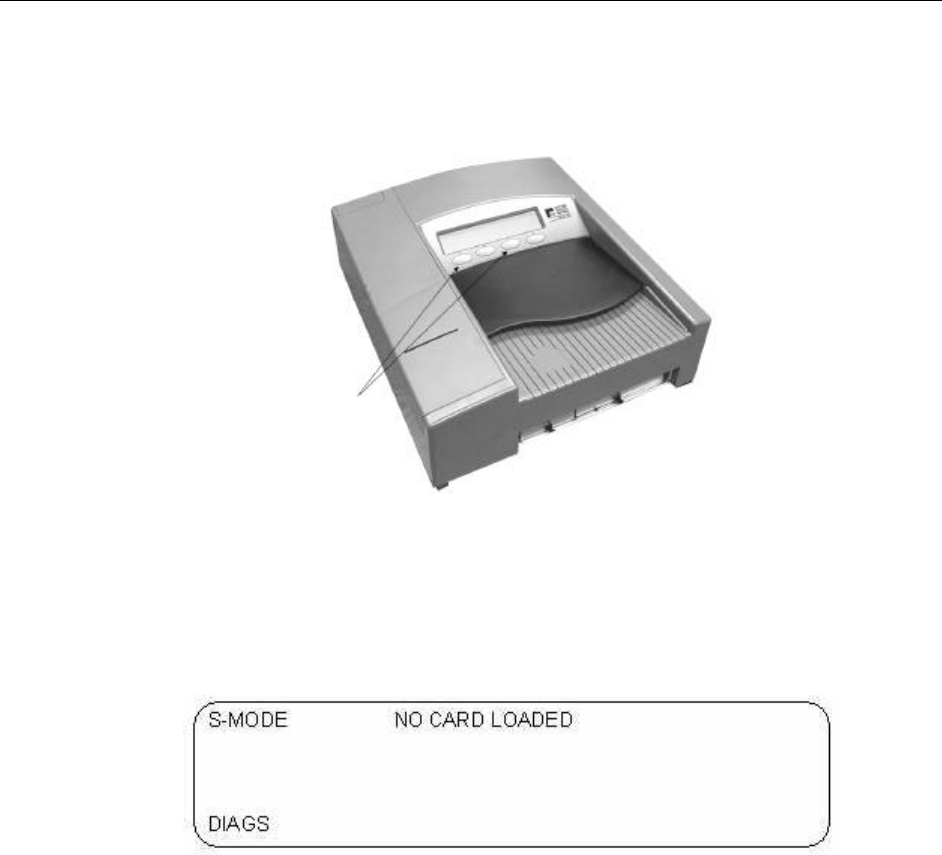
92
2. Press the first and third buttons from the left to access the DIAGNOSTIC-
TEST menu.
3. The three selections under the DIAGNOSTIC-TEST menu are DIAGS
(diagnostics), SYSTEM SETTINGS, and ELECTION TEST.
Accessing the Diagnostic Test Menu (without a PC Card)
To access the DIAGNOSTIC-TEST menu (without a PC Card)
Do not insert a PC Card into the scanner and turn the scanner key to
OPEN/CLOSE POLL. DIAGS is the only menu selection available when no PC
Card is loaded in the Model 100.
Press Both to
Select the
Diagnostic
Test Menu

93
The DIAGS Menu
Select DIAGS from the DIAGNOSTIC-TEST menu to test the scanner’s
accuracy and print reports that detail the current machine status. The three options
available from the DIAGS menu are BALLOT DIAGS, SYSTEM REPORTS,
and MORE DIAGS.
Select BALLOT DIAGS to test your scanner’s accuracy. The two options
available from the BALLOT DIAGS menu are FEED BALLOTS and
RECYCLE SET. Select RECYCLE SET to select the number of times that the
scanner will read the next ballot inserted into the Model 100.
To test the scanner
Select FEED BALLOTS and insert ballots into the scanner. If the scanner
successfully reads the ballot, the ballot emerges from the back of the scanner and
drops into the ballot box. If the scanner detects ballot irregularities, the scanner
rejects the ballot and a system error message appears.
The Ballot Diagnostics menu
After scanning test ballots, use the report options available under the BALLOT
DIAGNOSTICS menu to check the scanner’s accuracy. BALLOT
DIAGNOSTICS options print reports that describe the last ballot scanned.
Available options include: DIGITAL REPORTS, MARKS TALLY, and
GRAPHICS PRINT.
S
-
MODE BALLOT DIAGNOSTICS
TOTAL BALLOTS 0000
DIGITAL MARKS GRAPHICS PREVIOUS
REPORTS TALLY PRINT MENU

94
To print diagnostics reports
1. Select DIGITAL REPORTS and then select DIGITAL TABLE to generate
a report that shows how many pixels the scanner reads in each oval location.
2. Select MARK CODE from the DIGITAL TABLE menu to generate a
report that shows the different types of marks recognized by the scanner in each
response area. Four different kinds of readings are displayed:
• A dash (-) appears if the scanner detects a blank response area.
• An I (ignore) code appears if the scanner detects too few pixels in the
response area to register a valid mark.
• A V (vote) code appears if detects a valid voting mark in the specified area.
• An E (error) code appears if the scanner reads detects a mark but cannot
read the mark as a valid vote.
A number representing the variations in darkness (the thickness) of the mark
follows the vote codes.
Mark Code Table
*** Mark Code Table ***
10:37:01 03/20/2001
Orientation: FACE UP, HEAD FIRST
ROW CODE -A- -B- -C- -D- -E- -F-
001 12 V4 V4 V4 - - -
002 000 V1 V1 E2 - - -
003 000 - - - - - -
004 000 - - - - - -
005 000 - - V2 - - -
006 138 - V6 - - - -
007 000 - V6 - - - -
008 000 - - - - - -
009 000 - V5 V5 - - -
010 000 V6 - - - - -
011 000 V6 - V6 - - -
012 000 - - - - - -
013 000 - - - - - -
014 000 - - V3 - - -
015 309 V6 - - - - -
016 308 - - V6 - - -
017 319 - - - - - -
018 160 V6 - - - - -

95
3. From the DIGITAL REPORTS menu, select SCAN REPORT to produce a
report that assists you with diagnosing ballots with a high scan error rate.
Sample Scan Report and Description
*** Scanned Ballot Information ***
Orientation: FACE UP, HEAD FIRST (Orientation determined
by the scanning algorithm)
Ballot Sides Defined: 2
(Number of ballot sides defined on the Election Definition PCMCIA
card: 1 or 2)
Ballot Sides Determined: 2
(Number of sides the ballot has: 1 or 2)
FRONT OF BALLOT
Black Checks Info:
Mark: Left Edge Right Edge Size
TT: 008, 027, 152
A: 034, 040, 048
B: 092, 098, 046
C: 151, 157, 048
Black Check Information
Mark: The black check mark types on the ballot; TT, A, B, C, D, E, F
Left Edge: Millimeter measurement from the left edge of the ballot to the left edge of the
specified black check mark
Right Edge: Millimeter measurement from the left edge of the ballot to the right edge of the
specified black check mark
Size: Number of pixels that exist horizontally within the specified black check mark

96
Vertical skew: 1
(Difference in scans when finding the left edge and right edge of the leading
edge of the ballot; caused by the user inserting the ballot at an angle)
Timing Track Info:
(Number of timing tracks
found on the target side)
Number of timing bands: 036
Number of white bands: 036
Number of horizontal adjustments: -1
BACK OF BALLOT
Black Checks Info:
Mark: Left Edge Right Edge Size
D: 012, 018, 048
E: 071, 077, 048
F: 129, 135 ,048
TT: 201, 207, 050
Vertical skew: 4
Timing Track Info:
Number of timing bands: 036
Number of Timing Bands
(Number of black check marks (timing bands) vertically on
the ballot; the number of white bands should match the
number of bands of the Election Definition where a 14/36
ballot should have a value of 36)
Number of White Bands
Number of white spaces between the timing bands
vertically on the ballot; the number of white bands should
match the number of bands of the Election Definition
where a 14/36 ballot should have a value of 36)
Number of horizontal adjustments
(Number in millimeters that the timing track shifted
during the scanning of the ballot; -4 to +4 where
negative values determine a left shift and positive
values a right shift)
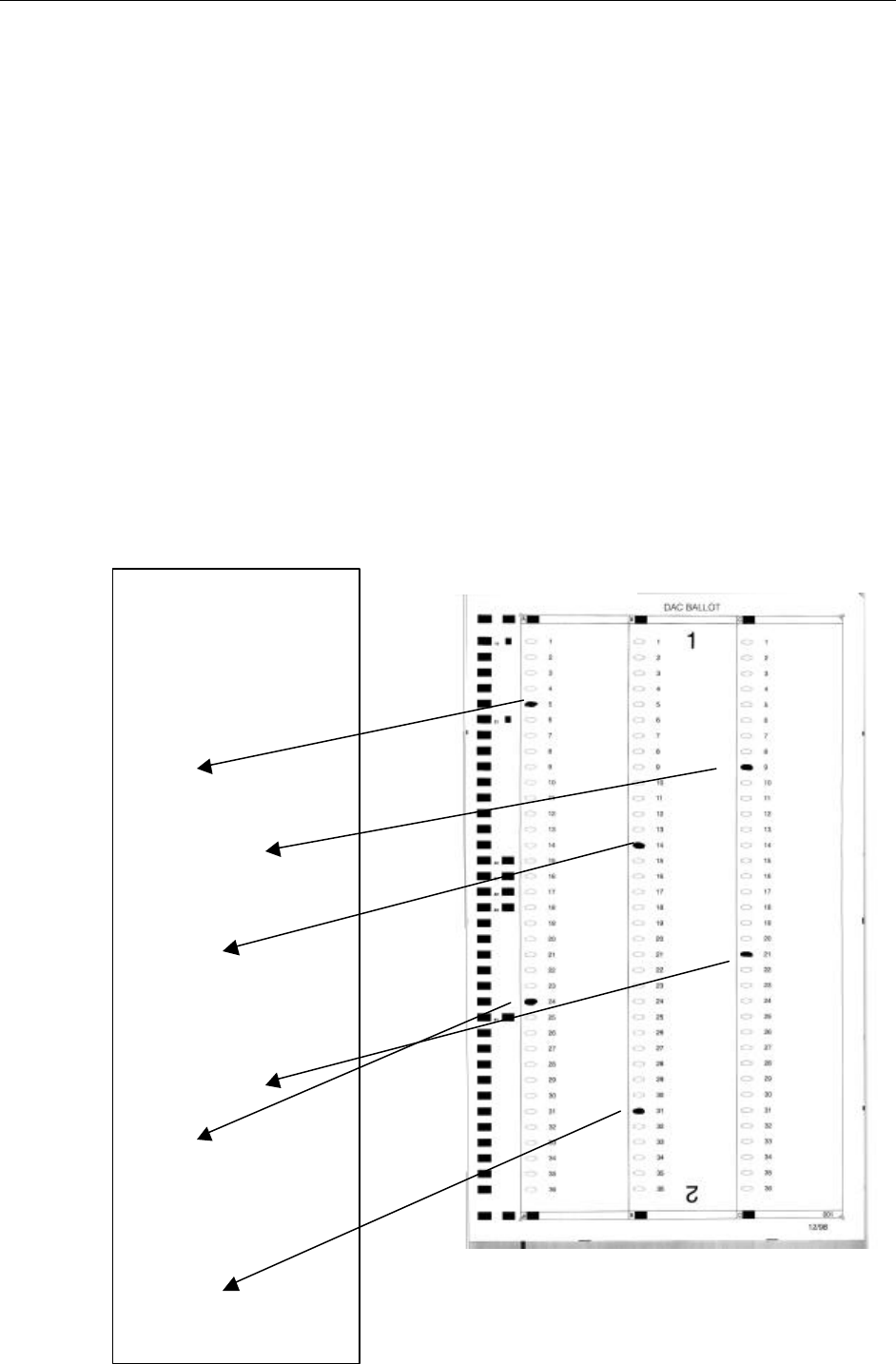
97
Number of white bands: 036
Number of horizontal adjustments: 2
SUCCESSFUL SCAN (0)
4. Select PREVIOUS MENU and then MARKS TALLY from the BALLOT
DIAGNOSTICS menu to generate a report that identifies the number of
marked ovals, by row, detected on both sides of the ballot. The report heading
shows how many ballots the Model 100 scanned and the report itself shows the
ballot position of marks read by the scanner.
A zero on the MARKS TALLY report identifies an oval that failed to register
on the scanner. A number (001, for example) indicates a scanned oval and
identifies the row/column position of the oval. The value of the number indicates
how many scanned ballots registered a valid mark in the specified ballot
position. For example, if the value 003 appears in row one, column A, three
scanned ballots contain a valid mark in the specified oval position.
Sample Marks Tally Report and Sample Ballot
Ballot Position Totals Report
Total ballots Scanned: 001
Row -A- -B- -C- -D- -E- -F-
1 000 000 000 000 000 000
2 000 000 000 000 000 000
3 000 000 000 000 000 000
4 000 000 000 000 000 000
5 001 000 000 000 000 000
6 000 000 000 000 000 000
7 000 000 000 000 000 000
8 000 000 000 000 000 000
9 000 000 001 000 000 000
10 000 000 000 000 000 000
11 000 000 000 000 000 000
12 000 000 000 000 000 000
13 000 000 000 000 000 000
14 000 001 000 000 000 000
15 000 000 000 000 000 000
16 000 000 000 000 000 000
17 000 000 000 000 000 000
18 000 000 000 000 000 000
19 000 000 000 000 000 000
20 000 000 000 000 000 000
21 000 000 001 000 000 000
22 000 000 000 000 000 000
23 000 000 000 000 000 000
24 001 000 000 000 000 000
25 000 000 000 000 000 000
26 000 000 000 000 000 000
27 000 000 000 000 000 000
28 000 000 000 000 000 000
29 000 000 000 000 000 000
30 000 000 000 000 000 000
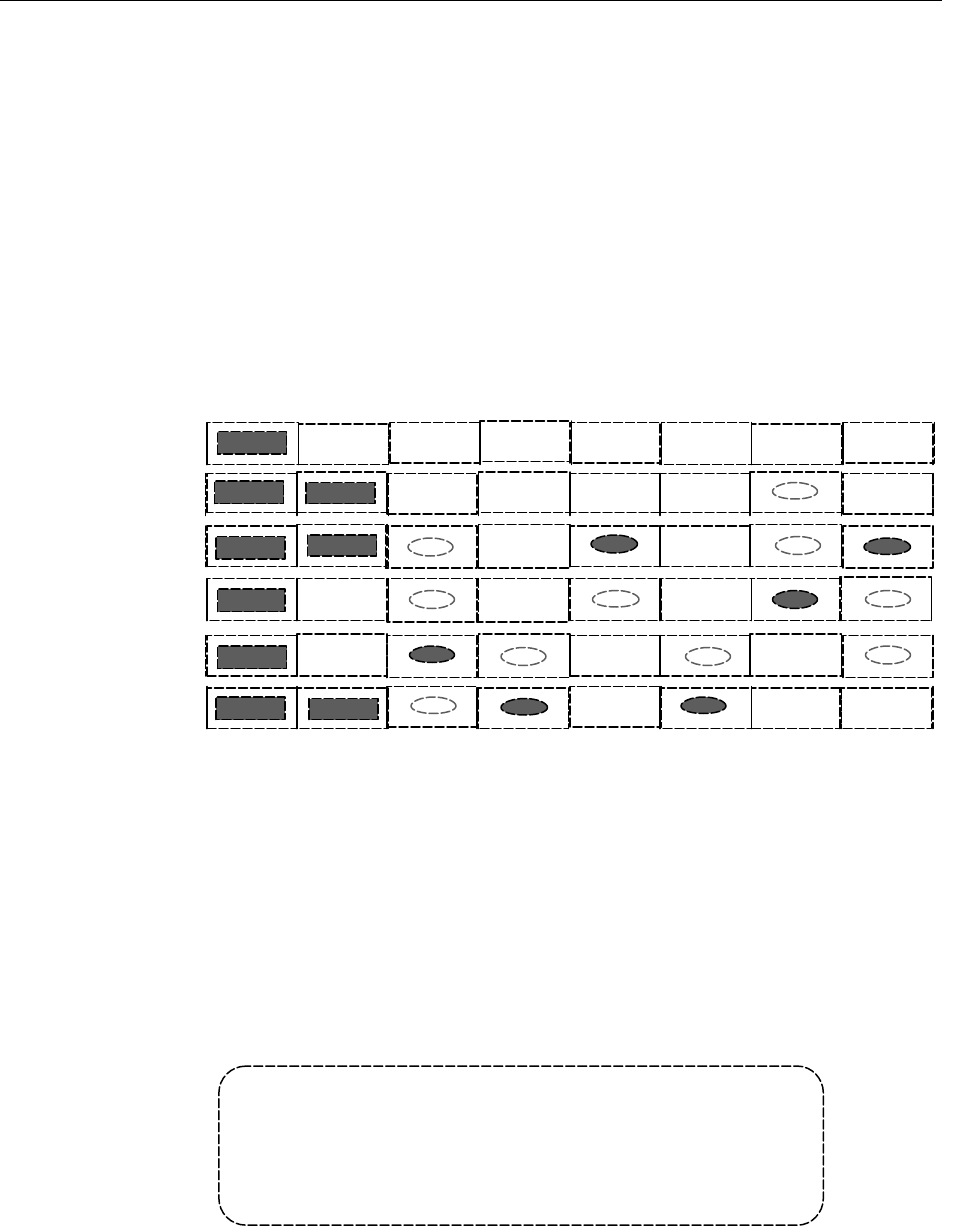
98
Note: The oval threshold setting determines whether the scanner can read a
mark.
5. Select GRAPHICS PRINT from the BALLOT DIAGNOSTICS menu to
print a graphic display of what the scanner reads within each “cell” window.
Each black dot on the printout represents a marked dot on the ballot with a
dashed line dividing each row and cell.
Graphics Print Table
6. Press PREVIOUS to navigate backward through Model 100 menus until you
reach the DIAGNOSTIC menu. From the DIAGNOSTIC menu, select
SYSTEM REPORTS. Use the SYSTEM REPORTS options check the
status of the scanner and identify system problems. The three system reports
available are: DEBUG REPORT, CONFIG REPORT, and SYSTEM
REPORT. See Appendix B, “Understanding Reports” for explanations and
examples of Model 100 system reports.
Diagnostic Report Menu
S
-
MODE DIAGNOSTIC REPORT
DEBUG CONFIG SYSTEM PREVIOUS
REPORT REPORT REPORT MENU

99
The System Settings Menu
Use SYSTEM SETTINGS options to calibrate the scanner and set the system
clock. You must install your election definition PC Card before you activate the
scanner to alter scanning options.
System Settings Menu
1. Select THRHLDS to access the MULTI SHEET option, which you can use
to test the scanner’s multi-sheet sensor.
Note: The multi-sheet sensor prevents the scanner from accepting two ballots
at the same time. For more information about testing the multi-sheet sensor, see
Chapter 4.
2. Select DATE TIME and select from the following options to adjust the system
time, date, and time zone.
• Set Date: sets the current date according to the current time zone.
• Set Time: sets the current time according to the current time zone.
• Set Time Zone: sets the time zone for the polling site.
Date/Time Menu
3. Only qualified, ES&S technical support staff should select the CALIBRATE
DACS option.
S
-
MODE
SYSTEM SETTINGS
DATE CALIBRATE PREVIOUS
THRHLDS TIME DACS MENU
S
-
MODE DATE TIME
SET SET SET PREVIOUS
DATE TIME ZONE MENU

100
The Election Test Menu
Use options from the ELECTION TEST menu to verify the election definition and
check the system counting logic. The Model 100 does not store results for any of
the ballots scanned during the election test and the scanner clears any existing
election totals when you enter the ELECTION TEST menu. The scanner restores
any existing, official results to the PC Card after you exit the ELECTION TEST
menu. The three options available in the ELECTION TEST menu are TEST
BALLOT, REPORTS, and ZERO TOTALS.
Election Test Menu
1. From the ELECTION TEST menu, select TEST BALLOTS to open the
BALLOT TEST menu. From the BALLOT TEST menu, select FEED
BALLOTS, and then insert test ballots into the scanner as you would for a
normal election.
Election Test Insert Ballot
2. After you finish scanning test ballots, select PREVIOUS to navigate backwards
through Model 100 menus until you return to the ELECTION TEST menu.
From the ELECTION TEST menu, select REPORTS to open the
ELECTION REPORTS menu. Use the three options available from the
ELECTION REPORTS menu (SEND RESULTS, REPORTS, and
PAPER FEED) to generate test reports from the Model 100.
Note: For more information about using the PAPER FEED command, see
Appendix A, “Maintaining the Counter.” For information about transferring
election results over a network, see Chapter 5, “Election Day Tasks.”
S
-
MODE ELECTION TEST MENU
TEST ZERO PREVIOUS
BALLOT REPORTS TOTALS MENU
S
-
MODE ELECTION TEST INSERT BALLOT
NUMBER OF VOTERS: 0
PREVIOUS

101
Election Reports Menu
3. From the ELECTION REPORTS menu, select REPORTS to open the
PRINT REPORTS menu. From the PRINT REPORTS menu, you can
generate a Poll Report, a Precinct Report or a Status Report. For samples and
descriptions of the available reports, see Appendix B, “Understanding
Reports.”
Print Reports Menu
4. From the ELECTION TEST menu, select ZERO TOTALS to set the test
totals stored in system memory to zero.
Using the Ballot Auto-read Option
Use the Model 100 auto-read option for diagnostic purposes to select the number
of times the scanner reads a single ballot. You can run a series of ballots and change
the number of times the scanner processes each ballot.
To activate the auto-read option
1. From the DIAGNOSTIC-TEST menu, select ELECTION TEST to open
the ELECTION TEST menu.
2. From the ELECTION TEST men, select TEST BALLOT to open the
BALLOT TEST menu.
3. From the BALLOT TEST menu, select AUTOREAD SETTINGS to open
the AUTOREAD SETTINGS menu. Use AUTOREAD SETTINGS
S
-
MODE ELECTION REPORTS
SEND PAPER PREVIOUS
RESULTS REPORTS FEED MENU
S
-
MODE PRINT REPORTS
POLL PRECINCT STATUS PREVIOUS
REPORT REPORT REPORT MENU

102
options to set the number of times the Model 100 automatically scans the next
inserted ballot. You can also configure the scanner to process ballots multiple
times based on ballot style. For example, you can select a ballot style and enter
a number to direct the scanner to process the next ballot it detects that falls
within the specified style the number of times that you specify.
4. Press SELECT DIGIT to specify the number of times the Model 100 will scan
the selected ballot. Press PLUS or MINUS to increase or decrease the
number.
5. Press PREVIOUS MENU to navigate back to the TEST BALLOT menu
and press FEED BALLOTS to open the AUTOREAD menu.
6. Insert the ballot that you want to scan. The Model 100 automatically scans the
ballot the number of times that you specified in the AUTOREAD SETTINGS
menu.
7. Press STOP to cancel ballot processing. Re-insert the ballot to restart the
scanning process. Press RESET to clear the CURRENT COUNT. Press
PREVIOUS to return to the BALLOT TEST MENU when you finish
processing ballots.
Note: From the BALLOT TEST MENU, press AUTOREAD SETTINGS
to change the number of scan cycles for each ballot that you want to scan.
Polls Open Mode
Open the polls to begin scanning official ballots on Election Day.
To open the polls
Press PREVIOUS to navigate backwards through Model 100 menus until you see
the message “ELECTION CARD INSERTED OPEN POLLS NOW?” on the
display screen. Press YES and turn the key to VOTE to open the polls.
The scanner performs a series of internal system checks and displays the results. If
any of the checks fail, the scanner rejects the loaded election definition and defaults
to the main menu.
If the system checks out, the Model 100 automatically sets election totals to zero
and prints a Status Report and then a Zero Totals report. The Zero Report lists all
active races, and shows the current vote count for all of the contests and issues
included on the ballot. The scanner automatically shuts down if it fails to properly
clear votes from system memory. If necessary, you can generate multiple zero
reports with certification statements.
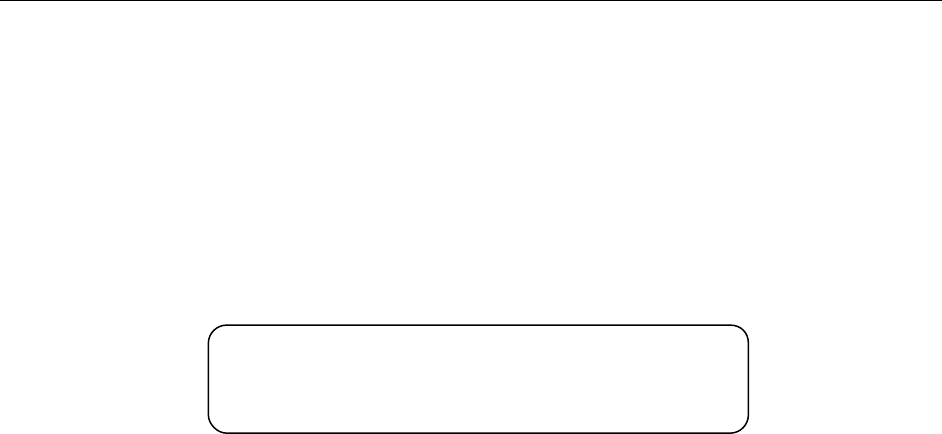
103
After the scanner completes its automatic checks and prints initial reports, the
message, “INSERT BALLOT” appears on the display screen. Voters can now
insert ballots into the scanner and the Model 100 saves the results to the inserted
PC Card.
Insert Ballot Screen
To print an audit log report with the polls open
1. To print a log report without closing the scanner, open the Key Access Panel
and turn the control key to the OPEN/CLOSE POLL position. The AUDIT
LOG-REPORT option appears next to the CLOSE POLLS option.
2. Select AUDIT-LOG REPORT to print the log.
3. Turn the key back to the VOTE position after the report prints to enable voting.
To enable additional precincts with the polls open
1. To enable additional precincts without closing the scanner, open the Key
Access Panel and turn the key to the OPEN/CLOSE POLL position. The
AUDIT LOG-REPORT option appears next to the CLOSE POLLS option.
2. Press the far left button on the control panel (it does not have a label) to open
the ENABLE PRECINCTS menu.
3. Select NXT-PREC to advance through a list of available precincts.
4. Select ENABLE for each precinct that you want to activate. After you enable a
precinct, the precinct remains active for the duration of the election or ballot
test. If you activate a precinct for testing, the scanner reverts to the previous
settings after you exit the test menu.
5. Select PREVIOUS navigate backwards through Model 100 menus until you
reach the CLOSE POLL option, and then turn the key to the VOTE position
to activate the scanner for voting.
To close the polls
INSERT BALLOT
NUMBER OF VOTERS: 0

104
1. At your jurisdiction’s assigned closing time, turn the scanner control key to
OPEN/CLOSE POLL position to access the CLOSE POLLS option.
2. Press CLOSE POLLS to close the Model 100 for voting. The scanner does
not save any ballot totals to the PC Card after you close the polls.
Note: Depending on how you configured your election definition, the scanner
may automatically print a results report and a certification report after you close
the polls. Press CANCEL to abort the printing. You can print additional copies
of any automatic reports from Polls Closed mode.
Polls Closed Mode
Activate POLLS CLOSED mode to generate results reports, print the system audit
log and to transfer election results to your reporting software.
Polls Closed Menu
1. Open the key access panel and turn the control key to the OPEN/CLOSE
POLL position to access the POLLS CLOSED menu.
2. The options available from the POLLS CLOSED menu include: RESULTS
REPORT, SEND RESULTS, AUDIT-LOG REPORT and MORE. For
more information about all of the commands available on this menu, except the
MORE option, see “The Election Test Menu” earlier in this appendix.
Note: For more information about the SEND RESULTS option see “Closing
the Polls” in Chapter 5. Use the SEND RESULTS option to transfer results
over a network to a computer running election reporting software at your
election headquarters.
3. Select MORE to open the MORE SELECTIONS menu. Options available
from the MORE SELECTIONS menu include: RE-OPEN POLLS, MORE
REPORTS and PAPER FEED. Select PAPER FEED to advance the printer
paper by one line. For more information about the RE-OPEN POLLS option,
see Chapter 5, “Election Day Tasks.”
S
-
MODE POLLS CLOSED
RESULTS SEND AUDIT-LOG
REPORTS RESULTS REPORT MORE

105
4. Select MORE REPORTS and enter a password (if necessary) to open the
MORE REPORTS menu. The three options available in the MORE
REPORTS menu include: CHANGE TYPE, PRECINCT REPORTS and
POLL REPORT.
5. Select CHANGE TYPE to select either media or summary as the report type.
See Appendix B, “Understanding Reports,” for more information about report
types.
6. Select PRECINCT REPORTS to print a ‘precinct by precinct report.’ For
more information and examples of report types, see Appendix B,
“Understanding the Reports.”
7. Select POLL REPORT to print an election poll report. For more information
and examples of report types, see Appendix B, “Understanding the Reports.”
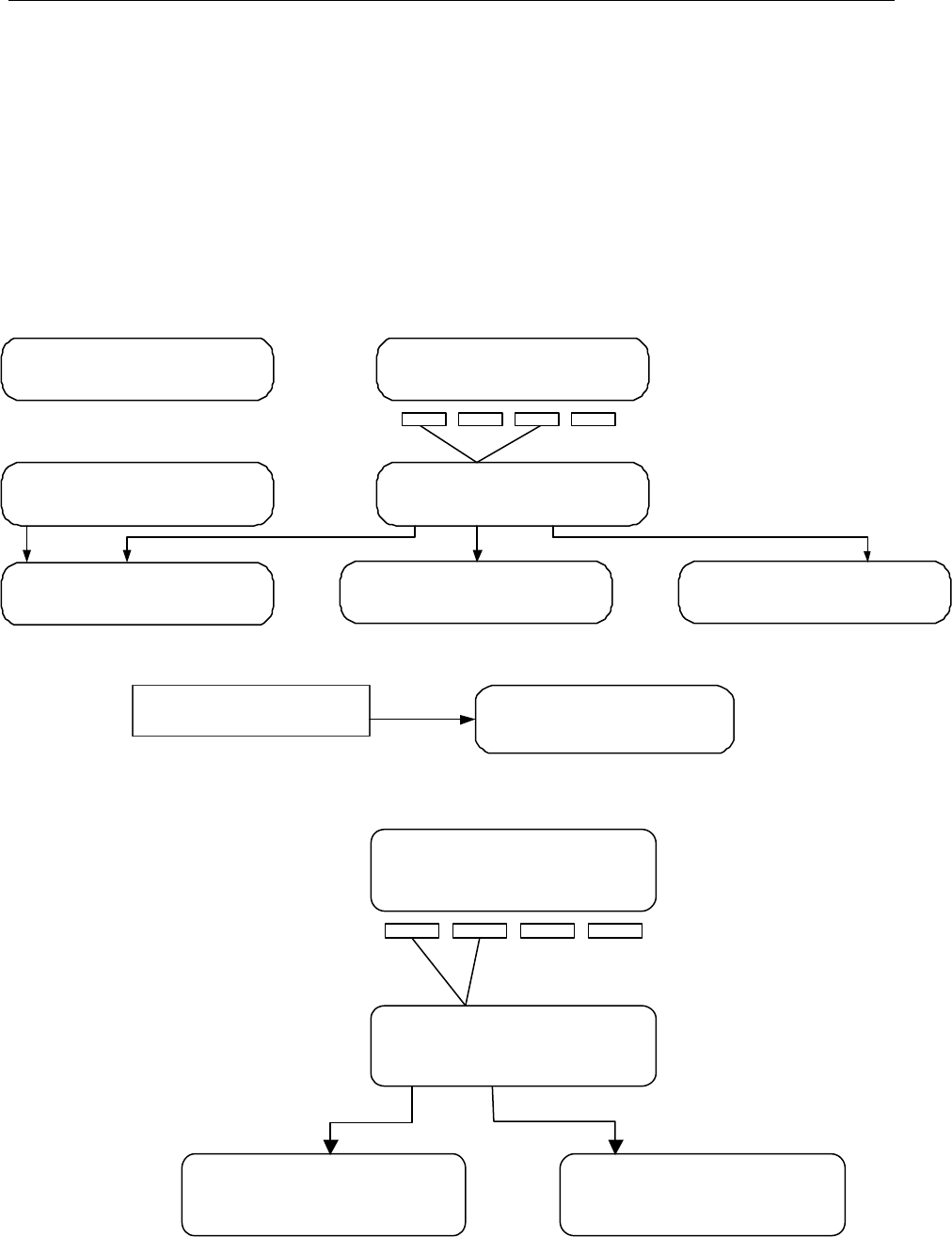
106
Model 100 Menu Flow Charts
Start-up Menu
CLEAR ELECTION DAY VOTES
TO ENTER ELECTION TEST MENU
YES NO
If there are election day totals on the PC
Card and you press ELECTION TEST while
in the DIAGNOSTIC TEST MENU
Model 100 Start-up Menu
Power up message with the Key in the
VOTE position and the PC card installed.
S-MODE ELECTION CARD INSERTED
OPEN POLLS NOW?
YES
Power up message with the key in the Open/Close
position and no PC Card installed.
S-MODE NO ELECTION CARD
DIAGS
Requires that both the 1
st
and 3rd buttons be pressed
simultaneously
S-MODE DIAGNOSTIC-TEST MENU
SYSTEM ELECTION PREVIOUS
DIAGS SETTINGS TEST MENU
S-MODE DIAGNOSTIC MENU
BALLOT SYSTEM MORE PREVIOUS
DIAGS REPORTS DIAGS MENU
S-MODE SYSTEM SETTINGS
DATE CALIBRATE PREVIOUS
THRHLDS TIME DACS MENU
S-MODE ELECTION TEST MENU
TEST ZERO PREVIOUS
BALLOT REPORTS TOTALS MENU
Power up message with the key in the Open/Close
position and a PC Card installed.
ELECTION CARD INSERTED.
OPEN POLLS NOW?
YES
S-MODE ELECTION CARD INSTERTED
OPEN POLLS NOW?
S-MODE MODEM MENU
MODEM CDPD PREVIOUS
SETTINGS STATUS MENU
S-MODE
SERIAL REDIRECTED
OK
CDPD STATUS
ANY KEY TO
EXIT
Press the first and second buttons from the left at
the same time to access the Modem menu.
YES

107
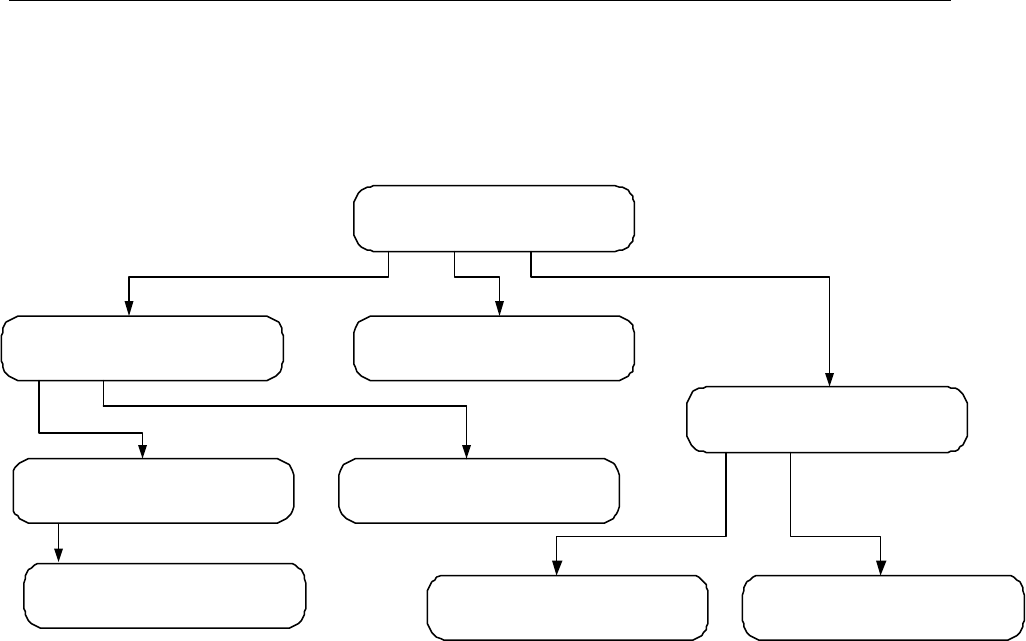
108
Diagnostic Menu
S-MODE DIGITAL REPORTS
DIGITAL MARK SCAN PREVIOUS
TABLE CODE REPORT MENU
S-MODE DIAGNOSTIC MENU
BALLOT SYSTEM MORE PREVIOUS
DIAGS REPORTS DIAGS MENU
S-MODE BALLOT DIAGNOSTICS
FEED RECYCLE PREVIOUS
BALLOTS SET MENU
S-MODE BALLOT DIAGNOSTICS
TOTAL BALLOTS: 0000
DIGITAL MARKS GRAPHICS PREVIOUS
REPORTS TALLY PRINT MENU
S-MODE RECYCLE SETTINGS
CYCLES: 0000
SELECT PREVIOUS
DIGIT PLUS MINUS MENU
S-MODE DIAGNOSTIC REPORTS
DEBUG CONFIG SYSTEM PREVIOUS
REPORT REPORT REPORT MENU
S-MODE MORE DIAGS
BATTERY MOTOR PREVIOUS
STATUS CONTROL MENU
S-MODE BATTERY STATUS
STATUS: BATTERY FULL
PREVIOUS
STEPPER MOTOR CONTROL UTILITY
FORWARD REVERSE PREVIOUS
MOTOR MOTOR MENU
Diagnostic Menu
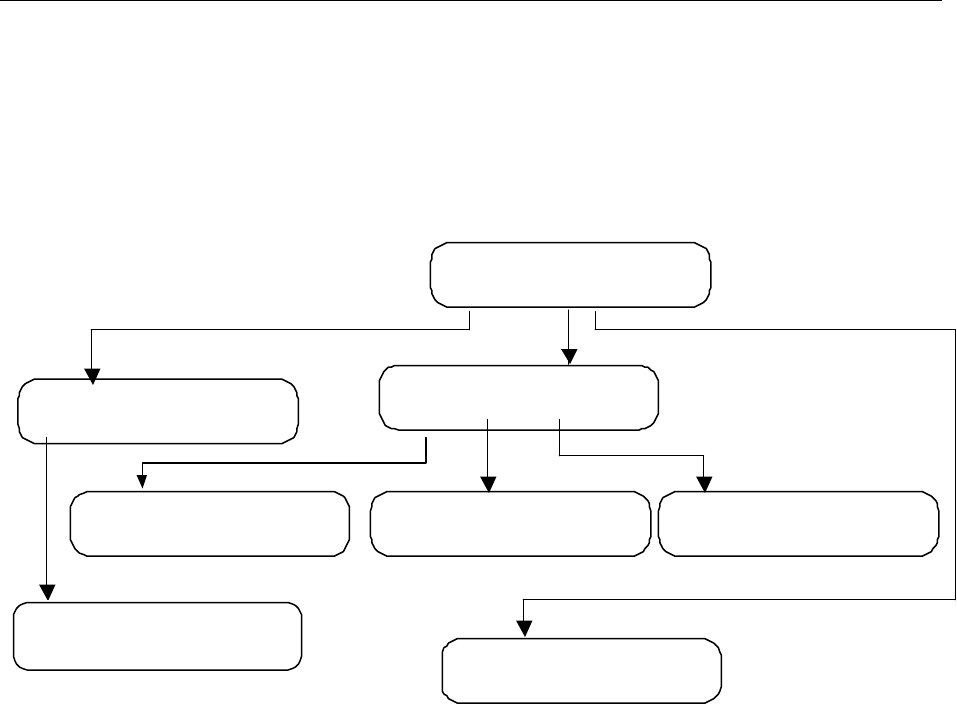
109
System Settings
System Settings
MULTI PREVIOUS
SHEET MENU
S-MODE CALIBRATION MENU
SET FACTORY PREVIOUS
DACS DEFAULTS MENU
S-MODE SYSTEM SETTINGS
DATE CALIBRATE PREVIOUS
THRHLDS TIME DACS MENU
MONTH: 11 DAY: 30 YEAR 2001
S-MODE SET DATE
SELECT PLUS MINUS PREVIOUS
S-MODE DATE TIME
SET SET SET PREVIOUS
DATE TIME ZONE MENU
S-MODE SET TIME
HOUR: 15 MINUTES: 37 SECONDS: 12
SELECT PLUS MINUS PREVIOUS
S-MODE SET TIME ZONE
HOURS OFFSET: 02 DST: ENABLED
TOGGLE
PLUS MINUS DST PREVIOUS
MULTI-SHEET DETECTION
DETECT: FALSE
PREVIOUS
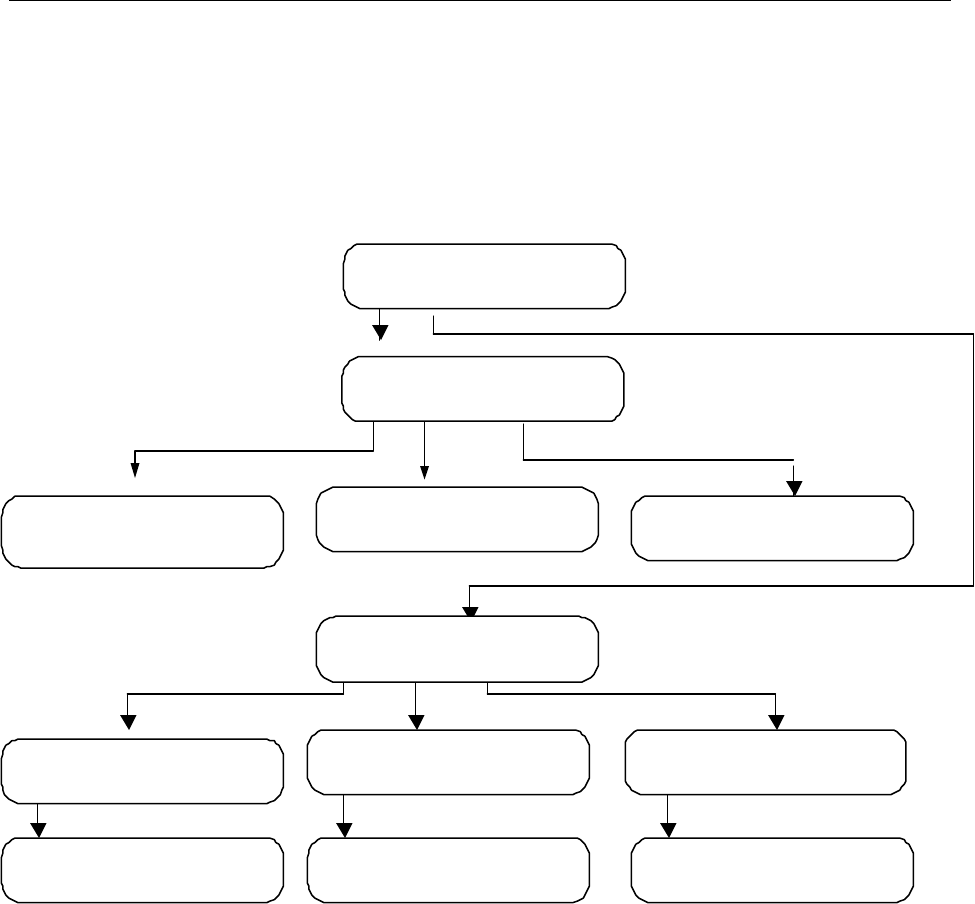
110
Calibration Menu
Calibration Menu
S-MODE CALIBRATION MENU
SET FACTORY PREVIOUS
DACS DEFAULTS MENU
S-MODE DAC VALUES/SENSOR/SKEW
SET SET SET PREVIOUS
S-MODE SET SENSOR OFFSET
CURRENT VALUE: 36
INCREMENT DECREMENT PREVIOUS
S-MODE SET SKEW TOLERANCE
SKEW TOLERANCE: 100
PREVIOUS
PLUS MINUS MENU
S-MODE LOAD/SAVE FACTORY DEFAULT
LOAD SAVE RESET PREVIOUS
FACTORY FACTORY FACTORY MENU
S-MODE LOAD FACTORY DEFAULTS?
YES NO
S-MODE RESET FACTORY DEFAULTS?
YES NO
S-MODE
FACTORY DEFAULTS LOADED
OK
S-MODE
FACTORY DEFAULTS RESET
OK
S-MODE SAVE FACTORY DEFAULTS?
YES NO
S-MODE
FACTORY DEFAULTS SAVED
OK
S-MODE SET DAC VALUES
SELECT PLUS MINUS PREVIOUS
TOP DAC 0180 A:000 B:000 C:000
BOTTOM DAC 0180 D:000 E:000 F:000
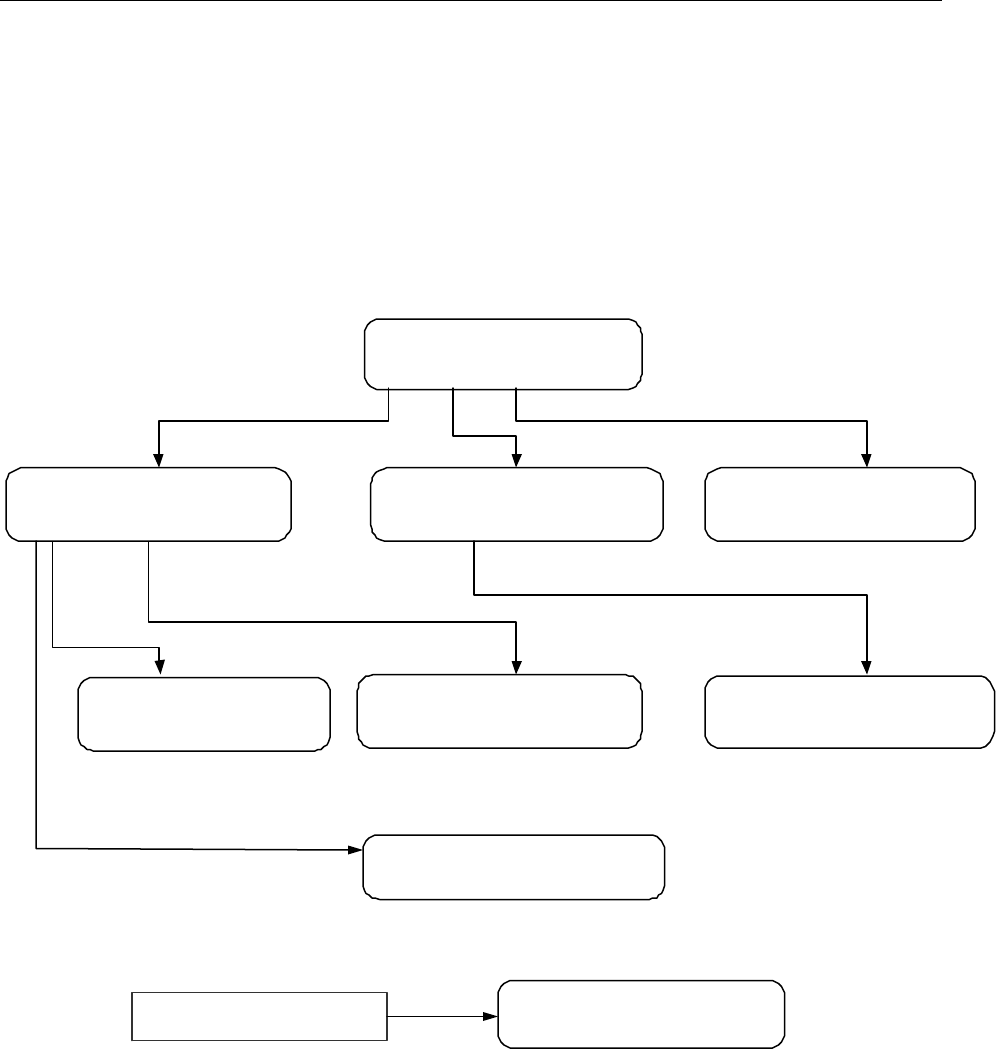
111
Election Test Menu
ELECTION TEST INSERT BALLOT
NUMBER OF VOTERS: 0
PREVIOUS
AUTOREAD SETTINGS MENU
CYCLES: 000000
SELECT PREVIOUS
DIGIT PLUS MINUS MENU
ELECTION TEST MENU
TEST ZERO PREVIOUS
BALLOT REPORTS TOTALS MENU
ELECTION REPORTS
SEND PAPER PREVIOUS
RESULTS REPORTS FEED MENU
COUNTERS ARE SET TO ZERO
OK
If cycles on AUTOREAD SETTINGS
menu set to more than 0
PRINT REPORTS
POLL PRECINCT STATUS PREVIOUS
REPORT REPORT REPORT MENU
AUTOREAD MENU
TOTAL COUNT/TARGET
000000 000000 000000
STOP RESET PREVIOUS
If you press PREVIOUS MENU in Election Test
Mode
CLEAR ELECTION TEST RESULTS
AND LEAVE ELECTION TEST MENU
YES NO
BALLOT TEST MENU
FEED AUTOREAD PREVIOUS
BALLOTS SETTINGS MENU
Election Test Menu
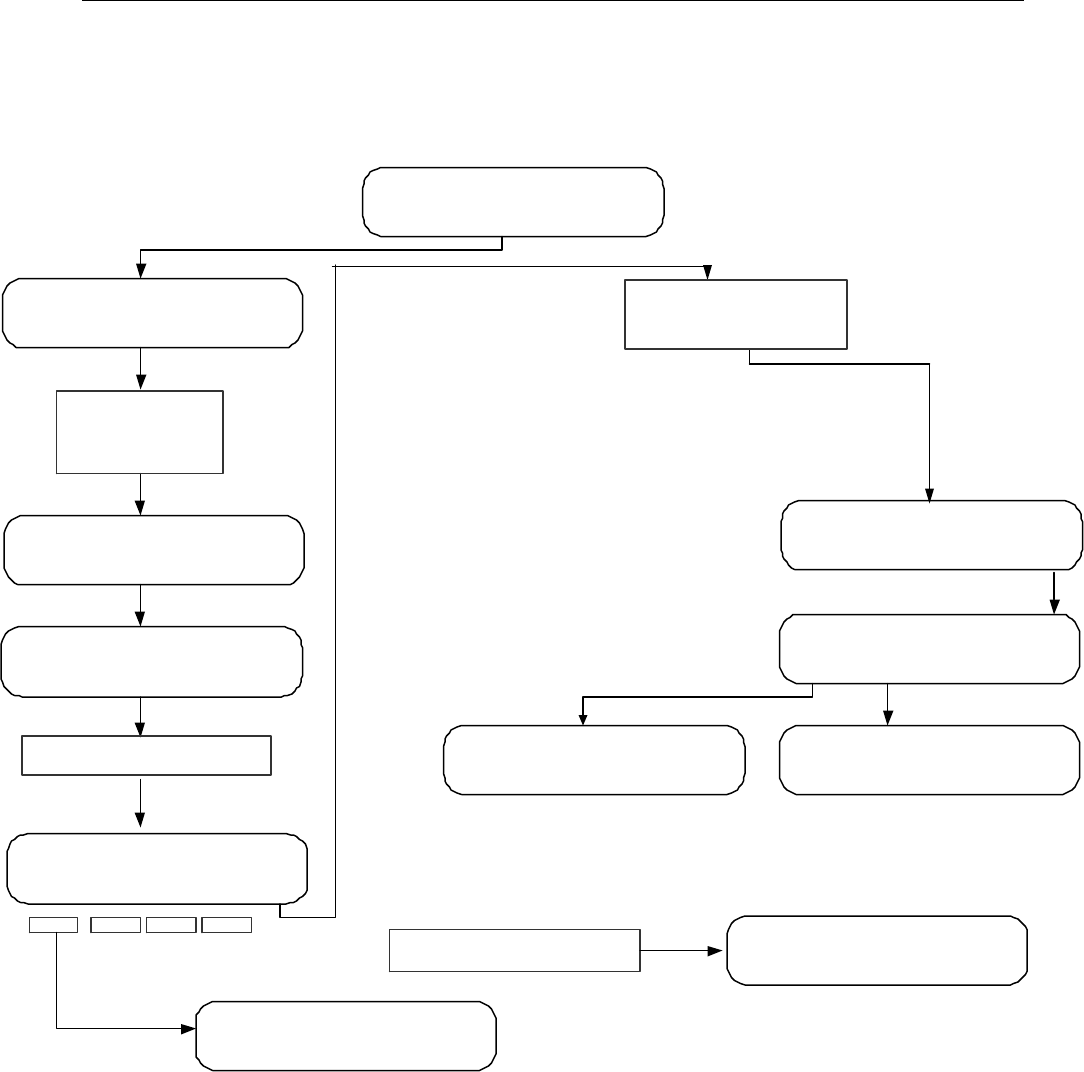
112
Opening and Closing Polls Menu
S-MODE ELECTION CARD INSERTED
OPEN POLLS NOW?
YES
S-MODE OPENING POLLS
PLEASE TURN KEY/SWITCH TO VOTE
INSERT BALLOT
NUMBER OF VOTERS: 0
INSERT BALLOT
NUMBER OF VOTERS: 123
S-MODE INSERT BALLOT
NUMBER OF VOTERS: 123
AUDIT LOG CLOSE
REPORT POLLS
Opening and Closing Polls
One of the following two screens
will appear dependant on the
election definition.
S-MODE POLLS CLOSED
RESULTS SEND AUDIT-LOG
REPORT RESULTS REPORT MORE
If designated in the Election
Definition, Automatic Modem
begins now.
S-MODE MORE SELECTIONS
RE-OPEN MORE PAPER PREVIOUS
POLLS REPORTS FEED MENU
S-MODE REPORT SELECTION
TYPE=MEDIA
CHANGE PRECINCT POLL PREVIOUS
TYPE REPORT S REPORT MENU
S-MODE ENTER PASSWORD KEYS
0 0 0
NEXT KEY KEY
KEY UP DOWN ENTER
Or, if printing is disabled
AUTO ACTION
Print: Status Report
Print: Zero Totals Report
Printing Zero Cert Report
Print: Poll Open Time
AUTO ACTION Print: Status Report
Print: Race ResultsReport (Flag)
Print: Certification Report (Flag)
Print: Audit Log
ACTION REQUIRED TO CLOSE POLLS
Turn Key/Switch to OPEN/CLOSE POLL
When test totals exist on PC Card and you
turn the key/switch to Vote
ELECTION TEST COUNTS EXIST
ON THE PCMCIA CARD
CLEAR TEST COUNTS TO CONTINE. . .
YES NO
S-MODE ENABLE PRECINCTS
PRECINCT ONE
STATUS: ENABLED
NXT-PREC ENABLE PREVIOUS

113
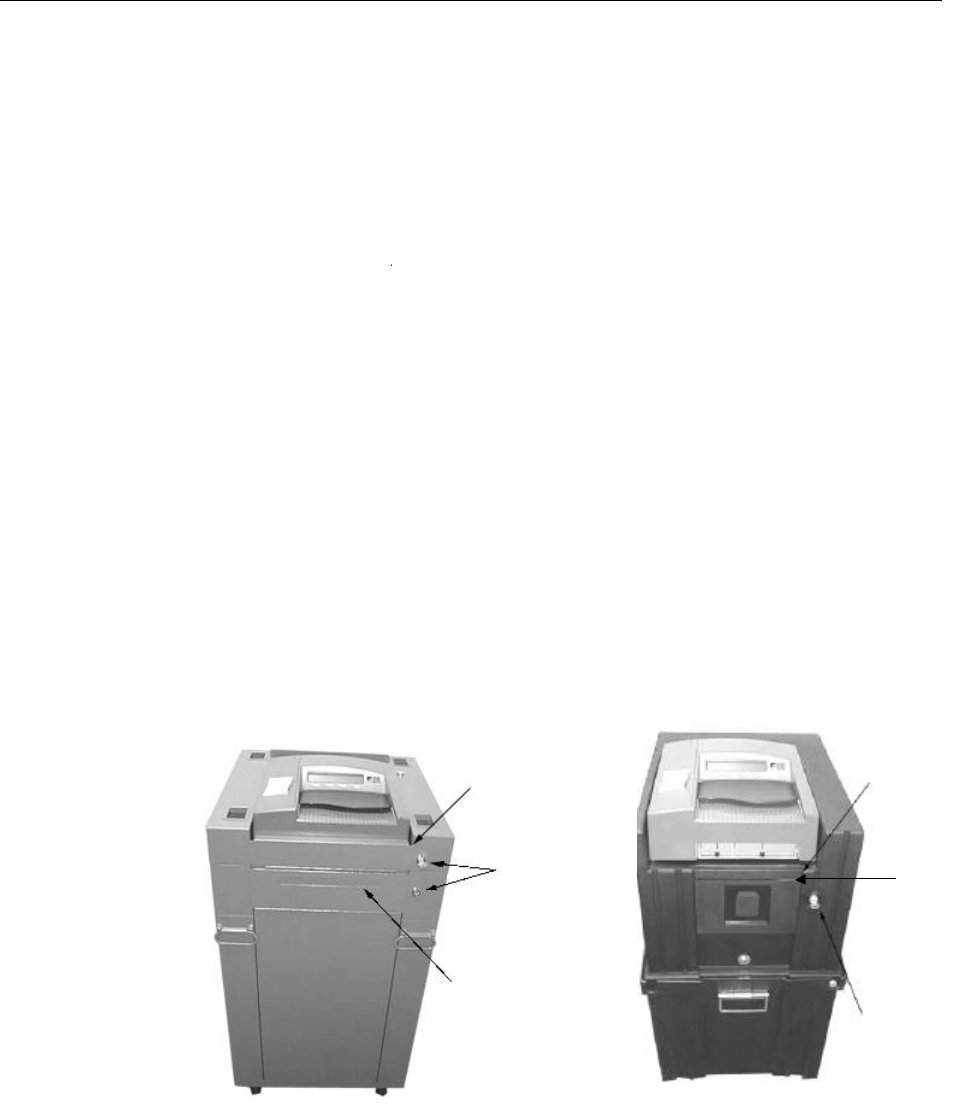
114
Appendix E: Troubleshooting
Use the following procedures if there is a power outage or scanner failure.
Using the Temporary Ballot Storage Bin
If the Model 100 fails during an election, use the following procedure to store
ballots in the temporary bin until you can repair or replace the scanner.
To store ballots in the temporary bin
1. Unlock the sliding door on the front panel of the ballot box.
2. If your jurisdiction uses nested ballot boxes, slide the door down until it no
longer holds the scanner in place. Lock the sliding door open.
3. If your jurisdiction uses metal ballot boxes, open the door to the emergency bin
and lock the top hinged panel on the front of the ballot box in the raised
position. Open the lower hinged panel and rotate the inside cover on the lower
hinged panel to gain access to the storage bin slot. Swing the panel back up and
lock in place.
The Metal Ballot Box The Nested Ballot Box
4. Voters may now insert ballots into the newly exposed slot for temporary
storage. Store uncounted ballots in the emergency bin until you can repair or
replace the scanner.
Slide Door
Downward
Storage
Bin Slot
Door
Lock
Swing Hinged
Door Upward
Locks
Storage
Bin Slot

115
Recovering or Replacing the Scanner
If one of your scanners fails and must be replaced, turn the malfunctioning scanner
off and remove the election definition PC Card from the slot. Insert the PC card into
a replacement scanner and turn the replacement scanner on. The new scanner
automatically recovers the vote totals and election information from the previous
scanner. .
For more information about resuming scanner operations after a single recovery,
see, ”Re-Opening the Polls” in Chapter 5.

116

117
Appendix F – Loading New Firmware
Onto The M100
To install new firmware on the M100, obtain an official PCMCIA firmware card
from Election Systems & Software. Begin loading the firmware card onto the M100
machine.
To load the M100 firmware card onto the M100 machine
1. Remove any cards currently in the machine before inserting the PCMCIA card.
2. Turn on the M100 machine.
3. The screen displays the card version number.
4. A message appears saying, “Reprogram flash memory. Load flash?” Press Yes
to load the flash. Press No to not load the flash.
Note: Do not remove the PCMCIA card during this process.
5. After you have successfully loaded the firmware, you will receive a confirmation
message. Turn off the machine and remove the card.

118
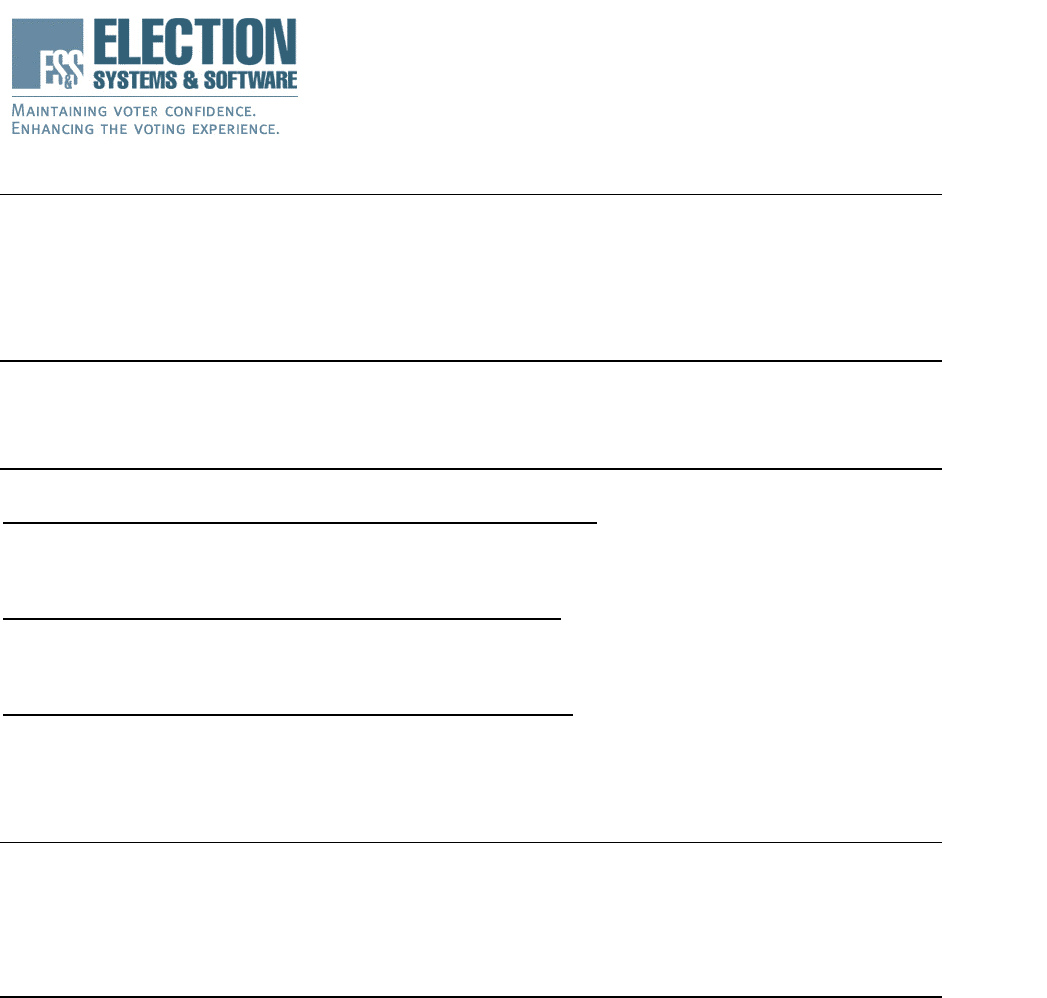
Unity Election System™
Election Data Manager Hardware Programming Manager
Ballot Image Manager Data Acquisipion Manager
Ballot on Demand Election Reporting Manager
iReport
Profile Voter Registration Systems™
PowerProfile™ MegaProfile™
StateProfile™ CandidateProfile™
Ballot Counting Systems
Systems for use at the Precinct or Polling Place – Electronic Ballot:
iVotronic® DRE Touch Screen Voting System
V-2000 Full Face DRE Touch Panel Voting System
Systems for use at the Precinct or Polling Place – Paper Ballot:
Model 100 OMR System
Model 2100 Punch Card System
Systems for use at Central or Regional Locations – Paper Ballot:
Model 150 OMR System
Model 550 OMR System
Model 650 OMR System
Model IV-C OMR System
Election Services and Support
On-site Training and Election Day Support Toll Free Phone and On-line Support
Election Programming Services Ballot Printing Services
Comprehensive Training Programs and Tools Systems and Procedures Documentation
Maintenance Programs Complete Inventory of Election Supplies
If you would like more information on any of our products or services please contact us:
Election Systems & Software, Inc.
11208 John Galt Blvd.
Omaha, NE 68137
Phone: 402-593-0101
Toll Free Inside the U.S.: 1-800-247-8683
Fax: 402-593-8107
Visit our website at www.essvote.com
The following products and services are
available from ES&S: